
by rail engineers for rail engineers www.railengineer.co.uk MAY-JUN 2024 – ISSUE 208 The construction mega-project is bewildering in scale, but constrained sites still raise challenges. HS2: PROGRESS ON A GRAND SCALE PG.36 PERMANENT WAY & LINESIDE ASSETS Rail breaks and defects are at an all-time low. Network Rail’s Brian Whitney discusses their management. TRENDS IN RAIL MANAGEMENT PG.66 ELECTRIFICATION & POWER The industry can deliver a cost-effective, well-performing railway, all while eliminating carbon emissions. A CREDIBLE, PRAGMATIC PLAN PG.08 GEOTECHNICS, EARTHWORKS & CONCRETE
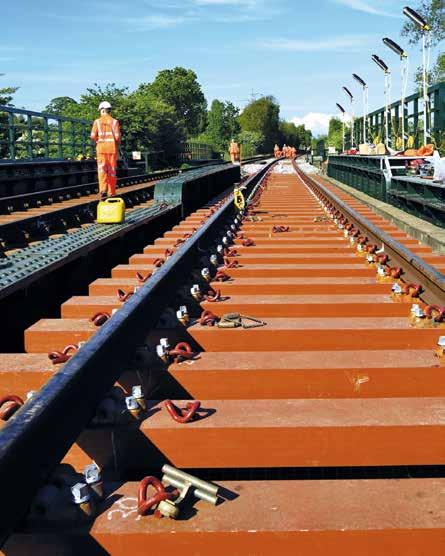
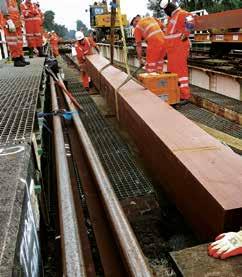
State of the Art

Synthetic Sleeper
Simply working & sustainable
Since 1985 we have installed more than 1,850 km of track
1.7 billion load tonnes | equivalent of 50 years use
Application: Ballast, Slab Track, Steel Construction and Direct Fastening
Can carry Axle loads of up to 65 tons
Use on High Speed Rail up to 300 km/h
Maintains long term track geometry
Contact with ballast similar to timber sleepers
Workable properties like timber sleepers



RAILWAY TECHNOLOGY SEKISUI CHEMICAL GmbH Patrick Childs | T: +44-(0)796-6598055 E-Mail: childs@sekisui.de www.sekisui-rail.com



Siemens inclined OLE
A credible, pragmatic plan
RIA’s new report shows that the railway can deliver a cost-effective, better performing railway while eliminating traction carbon.
Battery electric and battery hybrid trains
The last few months have seen much discussion around battery-powered propulsion. Malcom Dobell investigates.

18|
Enhancing distributionpowerthrough improved manufacturing
Reliable power distribution solutions are critical and improved manufacturing techniques have brought significant benefits to the industry.

Research – adding value in rail freight
Paul Darlington reports on a recent presentation from RSSB’s Robert Staunton and Aaron Rostron-Barrett.
ADHERE & V/T SIC: Wheel/rail interface and adhesion
David Shirres reports on Siemens’ latest initiative aiming to reduce the costs involved with electrification.
Paving the way in electrification
Electrification is at the forefront of decision-makers’ minds in the UK and abroad, but it is not without its challenges.
West Country signalling upgrades
Clive Kessell discusses the technology replacing the old signalling as part of the West Country signalling upgrade.
Hope Valley Railway Upgrade
Rail Engineer met Graeme Whitehead, Network Rail’s senior sponsor for the Hope Valley project, to hear more of its success.
HS2: Progress on a grand scale
The scale of HS2’s construction project is bewildering but teams must still contend with constrained sites, explains Malcolm Dobell.
GeoAccess: Earthwork examinations
Employing the majority of Network Rail’s earthwork examiners, GeoAccess looks for a blend of knowledge, experience, perception, and intuition.
RIA’s 2024 Innovation Conference
Held on March 26-27 at Newport’s International Conference Centre, this year’s theme was ‘inspired by innovation’.
Rail Engineer reports on the activities of the Vehicle/Track System Interface Committee and the Adhesion Research Group.
ADHERE & V/T SIC: Poor ride - what to do?
Network Rail’s Dr Mark Burstow reported on an investigation into poor ride on several fleets at specific locations.
ADHERE & V/T SIC: Trends in rail management
Malcolm Dobell was keen to hear from Brian Whitney, Network Rail’s engineering expert for track and switches & crossings.
Remote detection of heat-related track defects: a new approach
With summer just around the corner, engineers must consider how to manage the risk of heat-related track buckle.
Rolling stock software integration and cyber security
With hundreds of systems communicating at any one time, it’s crucial to ensure they’re all working together properly.
The National Cyber Security Centre
Rail Partners’ Rolling Stock Software and Cyber Security event examined the work of the NCSC.
UK Rail Strategy 2024: looking to the future Mixed messages emerged from an online conference organised by the Westminster Energy, Environment and Transport Forum.
76 CONTENTS 08| 13| 36| 32| 26|
36 32
42| 52| 44|
66| 72| 76| 78| 62| 70| 20| 24|
56|
PHOTO: NETWORK RAIL
PHOTO: HS2
ISTOCKPHOTO.COM/SANKAI Rail Engineer | Issue 208 | May-Jun 2024 3
PHOTO:

 DAVID SHIRRES
DAVID SHIRRES
RAIL ENGINEER EDITOR
DAVID SHIRRES
DAVID SHIRRES
RAIL ENGINEER EDITOR
At last, an (unofficial) plan!
Following recent editorials entitled ‘Where’s the plan’ and ‘There is no plan’, this issue also focuses on the need for one. In doing so we make no apologies for emphasising the need for a whole system plan to engineer the railway of the future.
In May 2021, the Williams-Shapps report committed to the production of a 30-year ‘Whole Industry Strategy Plan’ in 2022. There is as yet no such plan and the Great British Railways Transition Team (GBRTT) is unable to advise when it will be produced. There is thus no (Westminster) Government long-term plan to get the best from its railways. Rail Engineer is therefore pleased to report that the Railway Industry Association (RIA) has published a pragmatic, credible plan entitled ‘Delivering a lower cost, higher performing, net zero railway by 2050’. This shows how, with the right strategy, all these things can simultaneously be delivered in an affordable manner as this plan is largely based on existing plans to which the Government is committed.
RIA’s report also shows how ‘boom and bust’ procurement can be eliminated to reduce costs, save jobs, and give the railway supply chain a predictable workload.
However, this report has no official status. Hence it recommends that Government empowers a crossindustry group to further develop and test its analysis, and that GBRTT is empowered to work with this group to develop an official strategy. Although GBRTT has not been idle in this respect, its analysis is not in the public domain. After the election, it is to be hoped that the new government will act on RIA’s recommendations as a matter of urgency.
RIA’s report proposed extensive use of battery electric multiple units (BEMU) which, without any further electrification, could replace diesel trains on over half the routes they currently operate.
In his feature about battery electric and battery hybrid trains, Malcolm Dobell considers the latest developments in battery traction. This describes the introduction of exVivarail Class 230 battery trains on the GWR Greenford branch and its fast charging system. It also considers the introduction of Siemens Mireo plus B BEMUs in Germany which are charged from the overhead line and can run for 120km off the wires with the same performance as electric traction.
Hitachi has also announced a trial to replace a 6.5-tonne diesel generator with a battery pack of equivalent weight on a TransPennine Class 802 bi-mode unit. It is hoped that the replacement of all diesel generators by batteries on these units will give them a range of 100km off the wires. In another development, Southeastern trains has announced that its new third-rail DC EMUs could have batteries for power supply failure as well as enhancing safety in stations, depots, and sidings. Clearly, increasing numbers of the UK train fleet will be battery powered. Yet it has to be recognised that traction batteries are not cheap. Hence, for an intensive service, electrification is likely to be the lower whole-life cost option. Although RIA’s plan makes the best use of existing electrification, it does envisage a further 4,400 route kilometres of electrification by 2050 to increase the proportion of the network that is electrified from 38% to 66%. It is therefore essential that the industry can deliver this electrification in a cost-effective manner. We show how the Siemens Sicat SX overhead line system offers one way of doing this by increasing span lengths to significantly reduce the number of masts required.
 Siemens Battery EMU now in service in Germany
Siemens Battery EMU now in service in Germany
Rail Engineer | Issue 208 | May-Jun 2024 4 EDITORIAL
PHOTO: SIEMENS MOBILITY

Important though it is to optimise future traction and electrification options, a future rail strategy has to consider much more than this. Looking to the future, we report from an event that considered the legal, passenger, trade union, and industry perspectives, and the eventual creation of Great British Railways. Just how the railway will be structured and operated remains unclear, but it is clear that finance will be key to everything.
Reducing both installation and operating costs as well as improving performance was the aim of the West Country signalling upgrade project. Clive Kessell explains how this was achieved. Another recently completed upgrade project in the Hope Valley will provide more services and better, more reliable connectivity between Sheffield and Manchester as Paul Darlington describes. We also report on HS2’s major construction projects at the Bromford tunnel portal and the Thame Valley viaduct with its innovative LEGOlike construction
There is always much to learn from RIA’s annual innovation conference especially from speakers outside the rail industry. As we describe, AI and robots were a key part of this year’s event. In another feature we describe RSSB’s portfolio of rail freight research projects. As this article makes clear, successful rail freight innovation requires a whole system approach.
RSSB also supports the Vehicle/ Track System Interface Committee (V/T SIC) of which a sub-group is the Adhesion Research Group (ARG) which manages the ADHEsion REsearch challenge (ADHERE). Each year, V/T SIC presents its research findings to an industry seminar. As we report, this year’s event covered trailing arm
bushes, axle bearings, wrong side track circuit failures from rail contamination, enzyme leaf fall treatment, and the use of machine learning to estimate rail adhesion.
Poor ride due to hunting was another topic considered by the V/T SIC seminar. This showed how hunting can occur when both track and wheel profiles are within allowable wear limits. Hence this problem can only be resolved with joint action by operators and infrastructure managers.
A further article from this seminar concerns rail breaks which, although at a record low, still present a safety risk and cause major delays. This shows the potential of AI to further reduce rail breaks by identifying rail break precursors from track recording data and videos.
We highlight the very real risk of cyberattacks in two features. The National Cyber Security Centre (NCSC) considers that the UK’s critical sectors face a threat that is ‘enduring and significant’. We describe the nature of this threat and the action that needs to be taken.
The UK rolling stock fleet is a mix of “super computers on wheels” reliant on cloud-based systems and older trains running updated versions of software originally coded 25 years ago. Our feature explains how rolling stock is vulnerable to both bugs and cyberattacks and why train software must have a software quality assurance plan detailing its full validation, verification, and testing activity.
As always, Rail Engineer highlights the complexity of today’s railway engineering and the achievements of the industry’s engineers in maintaining and enhancing trains and infrastructure. It is to be hoped that, after the election, a strategic plan will be developed so that the nation can make the best use of this expertise.
Editor David Shirres editor@railengineer.co.uk
Production Editor Matt Atkins matt@rail-media.com
Production and design
Lauren Palin lauren@rail-media.com
Adam O’Connor adam@rail-media.com
Engineering writers
bob.hazell@railengineer.co.uk bob.wright@railengineer.co.uk clive.kessell@railengineer.co.uk david.fenner@railengineer.co.uk graeme.bickerdike@railengineer.co.uk malcolm.dobell@railengineer.co.uk mark.phillips@railengineer.co.uk paul.darlington@railengineer.co.uk peter.stanton@railengineer.co.uk
Advertising
Asif Ahmed asif@rail-media.com
Craig Smith craig@rail-media.com
Rail Engineer
Rail Media House, Samson Road, Coalville Leicestershire, LE67 3FP, UK. Switchboard: 01530 816 444 Website: www.railengineer.co.uk
Rail Engineer Videos http://rail.media/REYouTube
Editorial copy to Email: news@rail-media.com
Free controlled circulation Email: subscribe@rail-media.com
The small print
Rail Engineer is published by RailStaff Publications Limited and printed by PCP Ltd.

© All rights reserved. No part of this magazine may be reproduced in any form without the prior written permission of the copyright owners.
Part of: www.rail-media.com
PHOTO: RAILWAY INDUSTRY ASSOCIATION 5
THE TEAM Rail Engineer | Issue 208 | May-Jun 2024


Locomotion opens New Hall
A brand new £8 million collections building opened on 24 May at Locomotion in Shildon, County Durham, just in time for the late May Bank Holiday. This is the museum’s most significant regeneration project since it opened 20 years ago, and it is now the largest undercover collection of historic rail vehicles anywhere in Europe.
Over 100 vehicles are on display, some of which celebrate the role of Shildon as the world’s first railway town. The museum aims to attract 250,000 visitors a year to the region, and Locomotion is a partnership between the Science Museum Group and Durham County Council, with the latter having provided significant funding towards New Hall.
New Hall is part of a wider £95 million masterplan project covering Locomotion and the National Railway Museum in York, regenerating both museums with new galleries, spaces, and vital conservation work to inspire future generations of engineers, creators and thinkers as described in Issue 207 (March/April 2024).
HISTORICALLY SIGNIFICANT
Highlights of New Hall’s collection include historically significant vehicles built at the Shildon works, two snowploughs, a tracked Bren Gun Carrier, two cranes, and the Hetton Colliery Lyon, built in 1851. The museum’s existing Main Hall has also been refreshed and redisplayed.
Almost 1,000 vehicle moves were undertaken to achieve the new displays – the museum’s largest ever series of shunts, involving a team of in-house workshop and traction experts, conservators and specialist contractors. The two halls are not rail connected so transfers had to be carried out by road. Specialist haulier Allelys, of Train Truckers TV series fame, was involved in this work.
Inside New Hall, oral histories from former Shildon’s rail workers are used alongside historic film clips and graphics that bring the collection to life and highlight the significance of coal, industry, and freight transportation - and how the North East’s industry and innovation influenced the world.

CHARLOTTE GRAHAM
PHOTO:
Rail Engineer | Issue 208 | May-Jun 2024 NOTICES 6
MALCOLM DOBELL
Aerolite moving into New Hall


The building is the centrepiece of a host of other improvements and additions to Locomotion’s site, including the return of the iconic Gaunless Bridge, designed by George Stephenson.
Originally spanning the River Gaunless from 1823 to its removal in 1901, Gaunless Bridge is one of the first railway bridges to be constructed of iron, and the very first to use an iron truss. The bridge was sympathetically restored and repainted to its original colour scheme in early 2024 and is now installed on the approach to New Hall.
A ‘Changing Places’ facility has also been installed at the museum. In April, Locomotion was given an award from the North East Autism Society in recognition of its improved approach to inclusion and accessibility.

FIRSTHAND EXPERIENCE
One of the joys of a visit, rather than simply publishing a press release, is to hear the enthusiasm of the staff for the project and the museum. Your writer was escorted on a tour of the new building by Anthony Coulis and Kitty Bartlett whose expertise and knowledge brought the exhibits to life. A particular memory was how they had decided to retain a wagon where the body’s panelling had corroded away leaving only the frame, something that shows very clearly how the wagon was constructed.
Another was in a dirty shade of brown until a volunteer suggested pressure washing it which revealed the original grey paint in very good condition. The dirt comprising mostly brake dust had probably acted as a preservative! One line in New Hall tells the story of wagon manufacture at Shildon Works and includes the very first and the very last “merry go round” coal wagons manufactured there.
Locomotion employs around 48 people and is home to a vibrant community of volunteers, many of whom have longstanding connections with railways in the region.
Peter Robinson, a volunteer at Locomotion said: “It has been my life’s ambition to see something like this in Shildon. I’ve been into New Hall to view the display and it’s a wonderful place.
“I entered the works in 1956 and I was there until 1984. The closure was a devastating blow to the community. My whole life has been built around railways - the museum provides me with a place to share that passion with other people.
“It’s a hugely positive asset for Shildon. I speak to people from all over the country, and even internationally, who have come to Shildon specifically to visit the museum.”
New Hall was designed by AOC Architecture and J+L Gibbons Landscape Architects. The building draws on the aesthetic of an engine shed, with vehicles displayed on reused tracks across six themed roads. Sustainability has been built in through passive design, high insulation, airtightness, and cost-effective construction. Low carbon air source heat pumps deliver heat to the building, reducing energy use.
Building contractors Nationwide Engineering constructed the building over 14 months, breaking ground in January 2023 and completing the work in March of this year.

DOBELL
PHOTO: MALCOLM
Last Merry-Go-Round coal hopper wagon built at Shildon Works in 1982
Snow plough travelling to New Hall
Inside New Hall
PHOTO: MARK SLATER
GRAHAM Rail Engineer | Issue 208 | May-Jun 2024 7 NOTICES
PHOTO: CHARLOTTE

A credible, pragmatic plan
The title of the Railway Industry Association’s (RIA) report ‘Delivering a lower cost, higher performing net zero railway by 2050’ is a bit of a mouthful. Yet it illustrates how, with the right strategic guidance, the railway can simultaneously deliver a cost-effective railway that offers its customers better performing trains whilst also eliminating traction carbon. This is also affordable as it is largely based on existing plans to which the Government is committed.
In addition, the report’s recommendations also support the UK economy by eliminating ‘boom and bust’ procurement to give the railway supply chain a predictable workload. The threatened closure of Alstom’s Derby rolling stock manufacturing plant highlights the importance of addressing this issue. The need for such a report was highlighted in the UK Government’s Williams Shapps report which was published in May 2021 and committed to the publication of a 30-year whole industry strategic plan in 2022. Yet three years later, no such plan has been produced and is unlikely to be produced until well after the next general election.



RIA is to be commended for its production of a suggested strategy which could potentially fill the current policy vacuum. Though its report might not be government policy, it provides the basis for a unified industry approach which could usefully inform the next government’s thinking.
THE PLAN OF THIRDS
RIA’s strategy has three components: (i) deploying battery electric multiple units (BEMUs) as soon as possible where little if any new infrastructure is needed; (ii) electrifying intensively used passenger and freight routes; and (iii) implementing discontinuous electrification or fast chargers where BEMUs need their range extending to decarbonise the least intensively-used routes. It is proposed that these elements would be delivered concurrently to achieve early carbon reduction whilst smoothing delivery activity. This strategy would decarbonise 100% of passenger services and 98% of freight services by 2050.

 Battery EMUs such as this Siemens Mireo plus B are now entering service in Europe. RIA’s plan proposes the large-scale use of such units
PHOTO:SIEMENS MOBILITY
Battery EMUs such as this Siemens Mireo plus B are now entering service in Europe. RIA’s plan proposes the large-scale use of such units
PHOTO:SIEMENS MOBILITY
ASSOCIATION
PHOTO: RAILWAY INDUSTRY
DAVID SHIRRES
Rail Engineer | Issue 208 | May-Jun 2024 8 ELECTRIFICATION & POWER
PHOTO: RAILWAY INDUSTRY ASSOCIATION
The report shows that this is an opportunity to quickly achieve passenger, carbon, and air quality benefits. Without further electrification, the report considers that BEMUs could replace diesel traction on 133 of the 216 current dieselpowered routes. RIA considers that replacing DMUs with BEMUs is a ‘no-regrets’ decision given the age of most DMUs and the RIA assessment that there will still be 135 routes where BEMUs are needed in 2035. These will not all be the same routes as the BEMUs would be initially deployed on, as they would be cascaded as the electrification programme progresses. Electrification of intensively used routes would require increasing the

amount of electrification from its current 38% of the network to 66%. Electrification schemes for which there are currently commitments, including those in Network North, would increase the amount of electrification to 51%. The 1,260 single track kilometres (stk) of electrification recommended by the Chartered Institute of Logistics and Transport (CILT) to decarbonise 95% of rail freight would further increase network electrification to 59%. The RIA report considered that a further 7% of the network needs to be electrified to decarbonise all passenger services and greater than 95% of freight services.
It calls for all this electrification to be delivered at a consistent level of activity allowing suppliers to invest in people, plant, and processes, and benefit from continuous improvement. RIA believes that this smooth programme will further reduce the cost of electrification. Delivery of currently committed schemes that would see 51% of the network electrified requires around 345 stk to be completed per annum into the early 2030s. This means that no new government funding is needed until that time. RIA considers that this rate of delivery should be sustained into the 2040s to electrify 66% of the network in order to decarbonise all passenger services and 95% of rail freight. Its report stresses that this would require early strategic engagement with the electricity supply industry.

Unelectrified route
Existing electrification
Freight electrification
Other planned or proposed electrification
Proposed charging station
GB network electrification after planned and proposed schemes
RAILWAY INDUSTRY ASSOCIATION / GOOGLE
PHOTO:
Rail Engineer | Issue 208 | May-Jun 2024 9 ELECTRIFICATION & POWER
However, the availability of new technology such as static frequency converters reduces our dependence on major grid connections.
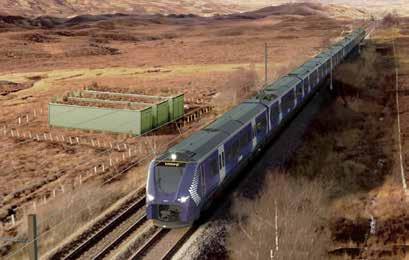
Next to the line is a static frequency which is an ideal way of providing an OLE power supply at such remote locations
RIA’s analysis shows that after the electrification of committed schemes and that required for freight (i.e., 59% of the network), 46 of the 216 routes currently operated by diesel trains would not have been decarbonised. For most of these routes, RIA proposes electrification around major stations, to charge BEMUs on high frequency routes, and to fill gaps on 80-100mph routes. This is the further 7% of the network that RIA considers should be electrified in addition to committed schemes and freight electrification.

This would leave eight long-distance lowfrequency routes in Scotland, Wales, and NW England. Although hydrogen trains with a range of 800 to 1,000km may be suitable for these routes, unlike BEMUs these are not considered to be a mature technology. Furthermore, an established ‘green’ hydrogen industry would be needed to supply these trains. Whilst it is possible that hydrogen trains might be a viable future option, RIA’s report proposes that BEMUs will operate on these routes as these are currently the available technology. These would require fast charging stations such as those described in Malcolm Dobell’s feature on battery electric and battery hybrid trains in this issue. These would necessitate occasional slightly longer stops on these routes.
The development of a strategy for future rolling stock, and the infrastructure they require, demands an understanding of the potential range of rail passenger and freight demand growth. In the absence of any official forecasts of rail passenger growth in the public domain, RIA commissioned Steer Group to undertake an independent assessment of the range of potential passenger growth.
This study took official forecasts of economic activity and population growth and reflected on how this might affect passenger growth by considering different assumptions about sluggish economic growth, the effectiveness of measures to attract passengers, and behavioural change including changes in home working and how rail’s environmental credentials might increase passenger numbers. It concluded that full recovery to pre-pandemic rail passenger levels would take between four and seven years and that, by 2050, rail passenger levels will have increased by between 37% and 97% of their pre-pandemic peak. This is an average growth per annum of between 1.6% and 3.0%. This compares with the 3.7% average annual growth rate between privatisation and the pandemic.
The RIA report is based on this estimated growth in rail passenger traffic. For rail freight it assumes a 75% increase by 2050 as this is the recently published rail freight growth target.
To develop various electrification scenarios including the best use of existing electrification and the minimum amount of electrification required to decarbonise rail passenger services, RIA developed a network model for the 1,100 discrete route segments used by the 216 routes on the network operated by diesel trains. The information held for each segment included its length, service frequency, number of stations, whether electrified, and its potential for electrification.
In some scenarios this showed that the requirement for battery charging may require power supply upgrades. Following widespread consultation with its members, RIA assumed that BEMUs can operate for a minimum of 60km ‘off wires’ and probably 80km, though gradient may then be a factor. It was also considered that BEMUs would need a similar length of wire or a charging station to recharge.
The number of diesel train routes for each electrification scenario is shown on the graph.
RIA’S METHODOLOGY
PHOTO: SIEMENS MOBILITY
PHOTO: RAILWAY INDUSTRY ASSOCIATION
Graphic of an electrified railway at Drumochter summit between Perth and Inverness which is the highest point on the UK rail network.
Rail Engineer | Issue 208 | May-Jun 2024 10 ELECTRIFICATION & POWER
RAIL FREIGHT
As the installed power of a freight locomotive is many times that of a single diesel rail passenger vehicle, it is not practical for them to carry on-board storage. As electric freight locomotives are both significantly more powerful and have lower life cycle costs than diesel locomotives, RIA’s report proposes electrification as the major solution for rail freight decarbonisation.
Hence RIA has adopted the recommendations of the CILT’s electrification strategy report which proposes 1,260 stk of electrification to make the core freight network fully electrified. This would enable 95% of rail freight trains to be electrically hauled and encourage modal shift of long-distance trunk haulage from road to rail. The CILT report also notes that, in the short term, the electrification of six short infill sections totalling less than 100km would enable many more freight trains to be electrically hauled over long distances.
The CILT’s proposed electrification programme aligns with life expiry of the existing diesel locomotive fleet, which will need replacement through the 2030s and 2040s. The CILT also considers that the private sector freight operating companies are keen to procure new locomotives but only if there is an electrified core freight network on which to operate them.
The RIA report notes that ‘drop-in’ alternative fuels or dual-fuelling provide decarbonisation options for diesel locomotives used for both freight and passenger services. It considered the situation both interim, when locomotives could not be replaced in the short term, and for the 5% of freight traffic for which electrification is not viable. The report contains an appendix produced by University of Nottingham which describes the range of alternative fuels and concludes that there are plausible short term and longterm options for ‘drop in fuels’ to displace diesel.
Yet these fuels are in short supply and more expensive than the diesel they would replace. RIA understands that Government policy is that the rail industry should not use alternative fuels with available supplies being prioritised towards aviation and recommends that this policy should be reconsidered. It is also considered that a policy decision is needed regarding the cost of ‘drop-in’ fuels as freight operators have tight financial margins and cannot make the business case to use such alternative fuels on a routine basis. Hence RIA recommends that consideration should be given to subsidising the use of alternative fuels for rail freight.
It is also important to note that whilst alternative fuels reduce carbon emissions, they do not eliminate other harmful emissions. Therefore, whilst they provide an interim solution, they are not a viable long-term solution where freight can be electrified.
ROLLING STOCK STRATEGY
A key aspect of RIA’s report is its consideration of train procurement for which it makes recommendations to avoid the historic ‘boom and bust’ production. This section builds on a previous RIA report – ‘The UK Rolling Stock Industry: Making 2023 the year of opportunity not crisis’. This used a database of existing passenger rolling stock introduction dates to forecast when replacement or life extension decisions would be needed assuming an average life of 35 years. Not surprisingly this reflected the historic ‘boom and bust’ procurement profile.
RIA’s analysis suggests how these large fluctuations in demand could be avoided in future. It calls for orders to replace 2,600 vehicles which will be 35 years old or older by 2030 which includes 1,100 DMU vehicles that could be replaced by BEMUs. Orders to increase fleet size to accommodate the growth in passenger travel could be placed in the years of otherwise low demand for new trains. Another way of smoothing demand would be to extend the life of some trains which is considered feasible for aluminium-bodied vehicles.
The difference between an order profile based on current fleet life and that with intelligent intervention as proposed by RIA is shown below.

BENEFITS
While the much of the RIA report focuses on the need for rail decarbonisation, it expects that the electrification required for this will have a positive business case in the long term. RIA’s 2023 paper ‘Electrification: The Facts’ demonstrates why “electric railways are better railways, however you define better.”
RIA’s report notes its proposals are likely to have a good business case as Network Rail’s 2020 Traction Decarbonisation Network Strategy had a positive business case for a far greater programme of electrification programme. To further review the case for electrification, RIA had the support of A D Little to develop a Total Expenditure/whole life (TOTEX) model for a specific route.
The route chosen was Bristol to Penzance which was felt to have a marginal case for electrification with most of its services being hourly or two-hourly. The TOTEX model compared the BEMU deployment (with charging infrastructure) or EMU (with full electrification) against a do-nothing option.
RAILWAY INDUSTRY ASSOCIATION
PHOTO:
Rail Engineer | Issue 208 | May-Jun 2024 11 ELECTRIFICATION & POWER

This showed that after 14 years the BEMU solution offers the lowest total cost, whilst, compared with do-nothing, full electrification pays for itself after 28 years.
The report demonstrates how its strategy will deliver 70% of rail traction carbon within 10 years. It also considers the wider benefits of rail decarbonisation are also considered. These include modal shift from other transport modes and the economic benefits of expenditure on the supply chain. A report undertaken by Oxford Economics for RIA shows for every pound spent on the railway a further £2.50 is generated in the wider economy.
The reports proposals to smooth the delivery of both electrification and rolling stock also offer significant benefits as historic irregular delivery drives up cost due to the frequency of mobilisation and demobilisation of resources.
Nevertheless, it is recognised that the affordability of any public investment is a major challenge given current fiscal constraints. As there is a positive whole life/whole system business case which will permanently lower railway operating costs, the report recommends exploring private finance options. These could include bundled ‘track and train’ solutions which could be a BEMU fleet and its associated charging infrastructure. RIA considers that such initiatives should be encouraged to move away from public funding as the default solution.
WAY FORWARD
RIA’s strategy shows how its proposed planned strategic approach offers significant benefits. This includes providing confidence to railway planners and investors as well as to the wider economy including the electricity industry by clarifying which routes will be electrified by 2050 and which will not. Furthermore, costs will inevitably be driven up if train owners and operators cannot make optimal decisions about rolling stock specification and procurement in the absence of a plan.
RIA has certainly met its objective of producing a plausible, affordable, and deliverable strategy to deliver a lower cost, higher performing, net zero railway by 2050. Rail decarbonisation has been a key industry issue since the then Rail Minister Jo Johnson challenged the industry to eliminate diesel trains in February 2018. In the six years since then, no other published report has provided such a credible affordable strategy. Yet it has no official status.
Others, including Network Rail and the Great British Railways Transition Team (GBRTT), have also been undertaking similar work. RSSB’s recently published ‘Sustainable Rail Blueprint’ has also considered this issue and notes how GBRTT will set out a detailed strategy that includes targeted electrification and maximising the value of alternative rolling stock solutions, as RIA has done, though GBRTT has yet to publish a long-term strategy.
This work, and that done by RIA, needs to be brought together to produce the whole system ‘rail-plan’. For this reason, RIA recommends that GBRTT is empowered to work with industry to prepare such a railplan for Great British Railways to deliver when it is formed.
In this way it is to be hoped that RIA’s work will provide a catalyst to accelerate the production of a much needed official plan to deliver a lower cost, higher performing, net zero railway by 2050.
Introducing BEMUs as soon as possible delivers early carbon savings, the cumulative effect of which is shown in this graph
INDUSTRY ASSOCIATION
PHOTO: RAILWAY
Rail Engineer | Issue 208 | May-Jun 2024 ELECTRIFICATION & POWER 12
Battery electric and battery hybrid trains



MALCOLM DOBELL
There has been much publicity over the last few months about the use of batteries as a propulsion energy source on trains. For example, in the UK, the first modern battery powered passenger train entered service on the extension from Kirkby to Headbolt Lane on 7 October 2023; Rail Operations Group’s Class 93 locomotives will feature a battery pack as well as diesel power and 25kV operation from the OLE; and Hitachi is testing a tri-mode conversion of a TransPennine Express Inter-City Express train adding a battery pack instead of a diesel generator on one car.
In addition, LNER has ordered 10 tri-mode (electric-diesel-battery) inter-city trains, the forthcoming Piccadilly line trains have a battery ‘get to the next station’ facility and, in Birmingham, some of the CAF trams have batteries to serve the extension to Edgbaston Village. All of these are hybrid trains/trams and there will be more to come. In Germany, Siemens has launched a fleet of battery hybrid trains (see later).
A recent Railway Industry Association (RIA) paper, which David Shirres reviews elsewhere in this issue, envisages a lot more bi-mode operation, and these trains will generally charge their batteries whilst running under OLE, although sometimes short OLE sections may be provided at, say, reversing points, to charge batteries during a train’s layover.
The report also sees a role for batteryonly trains for some duties. For these applications, fast charging is all important and a system solution is required. The reason for this was amply illustrated when Simon Green, Great Western Railway’s (GWR) engineering director, addressed the Chartered Institution of Railway Operators, and Dave Horton, GWR’s chief mechanical engineer (Battery Train Fast Charge Project), addressed the Institution of Mechanical Engineers’ Innovation in Traction seminar (covered in full elsewhere in this issue). They both discussed the system issues that have been addressed in the development and proving work for the West Ealing to Greenford fast charge trial.
Class 777142 BEMU at Headbolt Lane on its first day in service
PHOTO: MALCOLM DOBELL
Rail Engineer | Issue 208 | May-Jun 2024 13 ELECTRIFICATION & POWER

BACKGROUND
In Rail Engineer 193 (Nov/Dec 2021), David Shirres reported on the three trains demonstrated at COP26. As well as the two hydrogen powered trains (which were not ready to be driven by hydrogen) on show, a Vivarail battery-powered conversion of an old London Underground D stock train carried invited guests on return trips to Barrhead. This had been the first electric (London Underground!) train to cross the Forth Bridge under its own power. This led to a proposal to demonstrate the train and its fast-charging technology on the West Ealing to Greenford branch line in West London. Fast forward to the end of 2022, and, sadly, Vivarail entered administration. The DfT was still keen to see the trial continue and granted approval for GWR to purchase the fast charge intellectual property rights together with the prototype train, the three Class 230 DEMU 2-car sets made redundant from the Bedford to Bletchley line, and the remaining D stock cars in store at Long Marston. Getting a new system like this into service is far from trivial, but GWR approached the home straight when, on 18 March 2024, it announced it had started trials with the train and its fast charger on the Greenford branch.

JOURNEY SO FAR
No article about this project is complete without mention of the late Adrian Shooter who was the inspiration behind the project to upcycle ex-London Underground D stock which David Shirres described in Issue 186 (Sept/Oct 2020). His was the inspiration for the current battery configuration and the notion of the fast charge system.
The first incarnation was exported to the USA for ‘Pop Up Metro’ demonstrations. The idea was that batteries would replace the diesel generators on the train, feeding the existing Struckton Traction Control Unit (TCU) and acting as a sink for regenerative energy. Next was a train for a demonstration at COP26 in 2021, where the Vivarail team repurposed the original 230001 prototype into a three-car battery train with a modern interior.
It had been intended that two battery modules would replace the two diesel generators, but Adrian wanted three batteries, leading to the need to relocate the main air reservoir, as well as needing to find space for a new Auxiliary Battery Box, a new ‘Fast Charge Box’, three large DC-DC converters, and a lot of heavy duty cabling. The main battery modules contain lithium ion cells with a thermal management system to control the heat build-up during charging/discharging, together with creating optimum battery conditions in cold weather. Each module weighs 1.7 tonnes and is connected to its own DC-DC converter, the purpose of which is to step down the battery voltage (nominal 666V) to 48V for the battery thermal management system.

Part of the challenge was to deliver a means of charging the train during a normal terminus layover without overloading what might be a rural electricity supply. In simple terms, three elements are required. Clearly two of them are an electrical supply and a means to connect that to the train. The third ingredient is what is known as a Fast Charge Battery Bank (FCBB). The FCBB, in this case a 430kWh, 760V battery bank, is trickle charged from the electricity supply which might be a 400V, 63A three-phase connection. The fast charge aspect is that the battery can charge the train at 760Vdc at a rate of 1.8MW. We’ll get to why it’s not that simple later!
Class 230 001 at Glasgow Central during COP26
The Greenford Branch
PHOTO: MALCOLM DOBELL PHOTO: GWR
Class 230 underframe layout including changes following the COP26 demonstration
Rail Engineer | Issue 208 | May-Jun 2024 14 ELECTRIFICATION & POWER
PHOTO: GWR
The train-to-shore connection is via carbody-mounted shoes connecting to current rails placed between the running rails. Clearly, there are all sorts of protections required to ensure that the rails are not live until the train is stopped and the shoes are connected and are proved to be isolated before departure, as shown in the adjacent diagram. Each retractable shoe has a carbon-copper pick up capable of carrying 1,000A and the conductor rails are aluminium with a stainless steel contact surface. In the four foot, one central positive rail is flanked on either side by a negative rail, so there are three rails in total. The shoes on the train are arranged such that the positive shoe is always in the middle and always makes contact with the central positive rail, regardless of the train’s orientation, hence there is no risk of polarities getting mixed up.


The shoe-contact mechanism was subject to extensive tests including a carefully developed test to simulate ice and snow. The following day it snowed for real!
As discussed earlier, the range on a fully charged battery depends on a lot of factors such as stopping pattern, load, gradients, and speed. The trial train


has travelled over 110km under its own power. Initial testing has already shown that driving style has an influence on range.
This is a factor that is often discussed on metro systems but is all the more important when the energy source has limited capacity. In practice (as with metros) for a given run time, the best technique is to accelerate up to speed as quickly as possible and then coast as much as possible. In the case of the Class 230, which has AC induction traction motors, coasting is beneficial because it minimises energisation losses in the motors. With permanent magnet motors, such as used in most electric cars, this would not be such a problem.
Getting the train approved to run has been challenging as both the train and the charging system required approval, leading to an unusually complex process compared with what is normally in a train operator’s scope, involving both Safety Significant and Safety non-Significant (Common Safety Method terms) changes for both train and infrastructure. Where a
Safety Significant change is involved the change proposer can, in addition to hazard identification/risk assessment, justify the safety of the change by reference to compliance with standards, by cross acceptance from another demonstrably safe system in use elsewhere or by explicit risk estimation. If there is a choice, the first is usually the most straightforward and the latter the least.
In the case of the fast-charging system, both fixed and train-based elements are all novel meaning explicit risk estimation was required as part of the process to demonstrate that risks were reduced so far as is reasonably practicable. In addition, there was a requirement to demonstrate that the train is compatible with the infrastructure over which it will run and with any other trains on the lines concerned (e.g., EMI) and the fast-charging equipment on the infrastructure had to be demonstrated to be compatible with all the trains that might run over it. Both track and train elements had to be demonstrated to be compatible.
Conductor rails installed at West Ealing (above). Test rig showing shoes in snow conditions (below)
PHOTO: GWR
PHOTO: GWR
PHOTO: GWR Rail Engineer | Issue 208 | May-Jun 2024 15 ELECTRIFICATION & POWER
PHOTO: GWR
THE FUTURE
GWR has a relatively large number of self-contained branch lines. Simulations have been carried out by an engineering undergraduate from the University of Birmingham on work placement with GWR. Simulations for all the London/Thames Valley branches, based on a concept train with the second-generation TCU fitted to the SWR Class 484, showed that operation on all these branches is feasible. From this, availability of electricity supplies was evaluated on the conservative assumption that no connection could be made to the Network Rail 25kV supply.

Non-25kV bulk power supplies near to Slough (above) and Henley-on-Thames (below) - circled. Green icons show unconstrained power supply points, red icons show constrained supply points

This work showed that while there were bulk electricity supply points nearby, some were showing as ‘constrained’, meaning that there is a risk that the supply will need upgrading leading to a longer time required to obtain the supply.
Connection to the electricity grid is therefore a major constraint and even for the trial, it has taken two years to get a connection at West Ealing.
For future lines there are still 12 useable D-stock driving motor cars and 43 trailer cars in storage, plus the three ex-Bedford to Bletchley line units which could potentially be converted, or the system could be applied to other fleets, although some of the benefits of the comparatively light D stock cars (energy required from the grid, recharge time, etc.) might be lost.

SIEMENS BEMU ENTERS SERVICE IN GERMANY
The first Siemens Mireo trains entered service in 2020. These articulated electric multiple units are of a lightweight welded integral monocoque construction and have energy efficient silicon carbide power electronics. Currently, there are almost 1,000 Mireo EMU cars in service in two, three, or four-car sets. At Innotrans in 2022, Siemens presented one of 27 Mireo Plus B battery electric multiple unit (BEMU) trains that had been ordered by Landesanstalt Schienenfahrzeuge BadenWürttemberg (SFBW) 2020. Under this contract, Siemens will maintain these units for 30 years with 100% availability. This is said to be possible due to the data analytics of the cloud-based Siemens Mobility Railigent X Suite predictive maintenance system.

PHOTOS: GWR Rail Engineer | Issue 208 | May-Jun 2024 16 ELECTRIFICATION & POWER
PHOTO: SIEMENS MOBILITY
After a lengthy period of testing and development, the first four two-car Mireo plus B BEMUs entered service on 8 April. These units have 120 seats, are 46.6 metres long and have a maximum axle load of less than 20 tonnes.
They operate at a maximum speed of 140km/hr although they are designed to operate at up to 160km/hr. Their traction power in both electric and battery mode is 1.7MW which gives the Mireo plus B an acceleration of 1.1m/s2 in both modes.
The capacity of the battery packs, one per car, can be varied between 400kWh and 600kWh depending on the duty required. Lithium titanium oxide (LTO) battery technology is used. For this application using 500kWh battery packs, the unit has a batteryonly range of 120km with the battery unlikely to be more than 70% discharged after this distance. Batteries are charged from the 15kV 16 2/3Hz overhead line, regenerative braking and two charging stations at Achern and Biberach stations. Based on the thousands of kilometres testing to date, Siemens estimates that the batteries will last for at least 15 years.
The Mireo’s heating uses an energy efficient heat pump. Its air conditioning system uses propane as a refrigerant which is a sustainable refrigerant with thermodynamic properties that ensure a high efficiency.
Other orders for the Mireo plus B will see 31 units on the German East Brandenburg network and seven units in Denmark’s Midtjylland region entering service in 2024 and 2025.
When announcing the introduction of the trains into service, Albrecht Neumann, Siemens Mobility’s CEO for rolling stock, said that Siemens considers that the Mireo Plus B is now a mature technology.
WHAT NEXT?
The Siemens introduction has shown that an existing platform can be adapted to include a BEMU into the product mix. Equally, the GWR project shows what’s possible when adapting an existing train, although it might be challenging to interface the batteries to traction packages never designed to charge batteries. For new builds, all this will be considered but, if converting an existing train, engineers will need to assess the impact of adding several tonnes of batteries on its structural integrity, suspension, braking, and wheel/ rail interface as well as traction system integration.
Rail Engineer has already heard about proposals to provide BEMUs on some of the diesel powered lines in
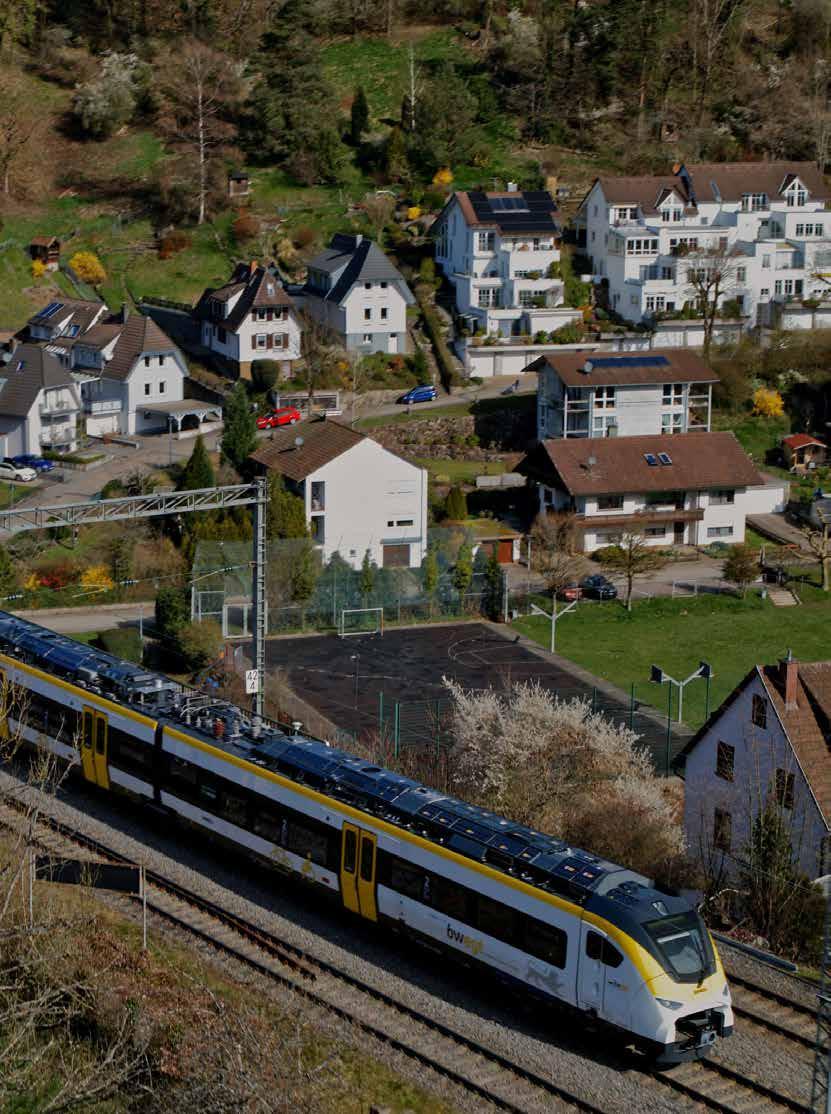
the 750Vdc area in the south of England where, perhaps, some comparatively short sections of third rail might be provided to top up the battery charge during the journey. Using this process, Waterloo to Exeter, East Grinsted to Uckfield, and Ashford to Hastings are possible. In Merseyside, there is talk of the BEMU versions of the Class 777 units being capable of running as far as Wrexham, providing plenty of opportunity to extend the reach of the Merseyside electrics.
It seems likely that a very large proportion of the rolling stock expected to be ordered over the next few years – see ‘Unplanned Rolling Stock Procurement’, Rail Engineer 206 (Jan/Feb 2024) –will be BEMUs or battery diesel hybrids.
This article was based on presentations by Simon Green, GWR engineering director, and Dave Horton, GWR chief mechanical engineer (Battery Train Fast Charge Project), and a Siemens press conference when the Mireo plus B entered service.
SIEMENS MOBILITY
Aerial view of Mireo Plus B. The larger European gauge together with a low floor interior, permits the majority of its electrical equipment to be roof mounted. PHOTO:
Rail Engineer | Issue 208 | May-Jun 2024 17 ELECTRIFICATION & POWER
Enhancing power distribution through improved manufacturing
The rail industry plays a pivotal role in modern transportation systems, providing a sustainable and efficient means of moving people and goods. Reliable power distribution solutions are at the heart of the industry, ensuring the safe and efficient operation of trains and related infrastructure.
In recent years, improved manufacturing techniques have brought significant benefits to power distribution solutions for the rail sector and, at Samuel James Engineering, we have also been taking advantage of these advances with a particular focus on performanceimproving technologies, digital solutions, and developing our team’s core capabilities. We have also been fully committed to embedding the Unipart Way tools and techniques into our everyday tasks, with process improvements that have enabled us to deliver significantly reduced lead times for our customers.
POWER DISTRIBUTION PRODUCTS
Samuel James Engineering possesses extensive expertise in design and development, application engineering, prototype manufacturing, repair, and consultancy at every stage of a system or product’s life cycle. We offer an unrivalled range of highquality Network Rail approved rail power products from Shore Supplies, Signalling Supply Panels (including PSPs, ASPs, FSPs), and UPS Systems as well, as Points Heating solutions, DNOs, Distribution, and Lighting Control Cubicles. samuel-james.co.uk/manufactured-products


ENHANCED TEAM CAPABILITIES
One of the key drivers of improved manufacturing capability in the rail industry is the development and enhancement of team capabilities and, as a Unipart company, we recognise the power of our people and ensure we provide everyone with the right opportunities to continually develop.
CROSS-FUNCTIONAL COLLABORATION
Modern manufacturing teams in the rail industry are characterised by their crossfunctional nature. Engineers, designers, and manufacturing specialists work together closely from the quote through to the design and final production stages. Our collaborative approach and customer engagement principles ensure that our power distribution solutions are not only efficient but also optimised for cost-effectiveness and reliability.
SPECIALISED TRAINING
To keep up with the rapidly changing technology landscape, manufacturers in the rail industry invest in specialised training for their teams. This includes training on the latest design software, advanced manufacturing techniques, and quality control processes. These well-trained teams are better equipped to design and produce cutting-edge power distribution solutions, and being co-located in Coventry, we also have access to Unipart’s Advanced Manufacturing and Engineering (AME) facility.
LEAN PROCESSES FOR REDUCED LEAD TIME
We focus on eliminating waste, streamlining operations, and optimising resource utilisation. These lean manufacturing principles have significantly reduced lead times in the production of our range of power distribution solutions.
We have also developed our procurement and manufacturing processes to ensure efficient material handling, reduced energy consumption, and zero defects. Our streamlining improvements result in shorter production times, smoother workflows, and provide us with the ability to deliver to an agreed schedule.
Samuel James Engineering was acquired by Unipart Rail in 2019 and is located on the Unipart Coventry site. Our improved manufacturing practices have brought significant benefits to power distribution solutions in the rail industry. The enhanced team capabilities and adoption of lean processes have played a pivotal role in reducing lead times, improving efficiency, and lowering costs.
As the rail industry continues to evolve, manufacturers need to stay committed to innovation and collaboration to meet the industry’s ever-growing demands for reliable power distribution solutions.
We at Samuel James Engineering are excited for a positive future supporting the E&P sector, and are confident the advancements we’ve made will contribute to the industry’s overall sustainability and continued success.

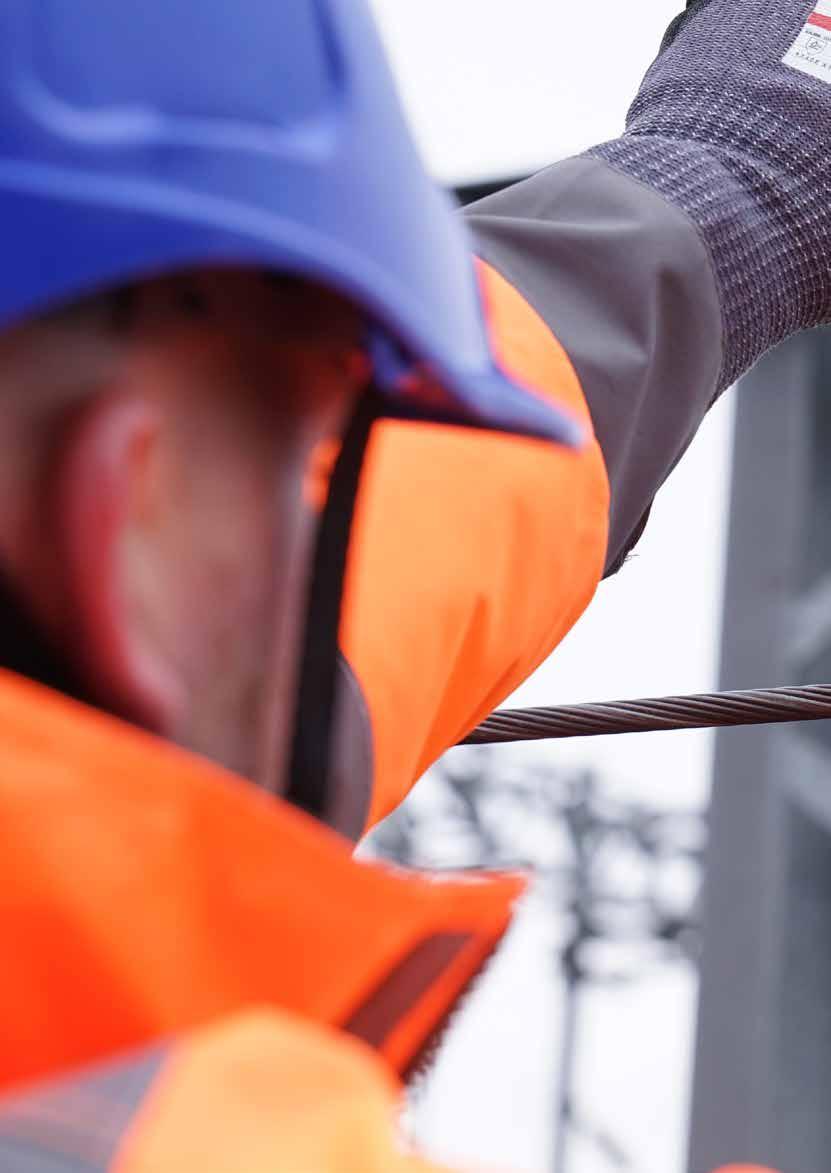
Rail Engineer | Issue 208 | May-Jun 2024 ELECTRIFICATION & POWER 18
PHOTO: SAMUAL JAMES ENGINEERING
GRIPPLE SWIFTLINE RAIL DROPPER - A GAME CHANGER FOR THE INDUSTRY
The goal for the UK rail infrastructure to achieve net zero emissions by 2050 presents a formidable challenge, compounded by the current status of electrification, which stands at just over a third (38%) of the rail network. With such a significant gap to bridge, a transformative approach to the development and adoption of innovative solutions is paramount, as these will play a pivotal role in enhancing the efficiency of electrification initiatives, propelling the industry towards its ambitious environmental objectives. To overcome one of the biggest challenges faced by OLE engineers, which is time, Gripple has worked in collaboration with the rail industry to introduce the new SwiftLine Rail Dropper, which is changing the game for rail electrification.
Approved by Network Rail, the Gripple SwiftLine Rail Dropper is a revolutionary solution to delivering maintenance projects faster and more efficiently. Pre-cut, pre-measured, and completely tool-free, it is faster, safer, and easier to install than traditional rail droppers.
Available in a range of adjustable drop lengths from 1.1 to 2.2 metres, the pre-assembled design enables toolfree installation with minimal training, making projects much simpler and safer, and limiting the time engineers spend working at height and in the dark.
Manufactured in the UK in carbon neutral facilities, all Gripple rail droppers are produced to the highest standards and can be supplied ‘just in time’, as and when maintenance teams require them. You’ve got to see it to believe it!
Unipart Rail is the exclusive UK distributor for the Gripple SwiftLine Rail Dropper, get in touch to request a sample and learn more on our website.

SEE US AT RAIL LIVE: Find out what’s on display by scanning the QR code.




 PHOTO: GRIPPLE
PHOTO: GRIPPLE
PHOTO: GRIPPLE
PHOTO: GRIPPLE
Rail Engineer | Issue 208 | May-Jun 2024 ELECTRIFICATION & POWER 19
PHOTO: GRIPPLE

Siemens inclined OLE


The cost of electrification significantly constrains the expansion of the UK’s electrified railway network. Rail Engineer has reported on various worthwhile initiatives to reduce the cost of electrification as, for example, in our ‘Making electrification affordable’ feature in Issue 106 (May/June 2022).
In this issue we are pleased to report on one that has the potential to reduce the number of masts required by between 24% and 35% depending on the curvature of the line. Siemens calculates mast savings on the straight Hull to Selby line to be 35%. As shown below, on the more curvy Perth to Aberdeen route, mast savings are 24%. This innovation is the Siemens Sicat SX system which in April received National Technical Specification Notices (NTSN) design certification for use in the UK.
Sicat (Siemens Catenary) OLE systems have been in use in the UK for both DC and AC systems. The 2002 Tyne and Wear metro extension uses Sicat LD, whilst the 2005 electrification of the new Larkhall
branch used Sicat SA. In 2019, Sicat SA cantilevers were included in Network Rail’s UK Master Series (UKMS) of approved OLE design ranges.
The development of Sicat SX began in 2004 when Hungarian State Railways won EU funding for an initiative to develop lower cost electrification. In 2010, this resulted in a 4km section of the 90km line between Bajánsenye and Boba in western Hungary being electrified with the novel Siemens SX system. Compared with conventional Hungarian electrification, this saw an increase in span length on straight track from 75 to 99 metres and on track with a 1,000-metre radius curve from 61 to 73 metres.
In all OLE systems, the contact wire has a zig-zag path, or stagger, to avoid wearing a groove into the pantograph. Generally, the catenary wire, which supports the contact wire, has the same stagger as it is vertically above it. With Sicat SX, the catenary wire’s stagger opposes the contact wire’s stagger so that the droppers between these two wires are inclined. Combined with increased catenary wire tension and a novel choice of conductors, this arrangement provides an OLE system with a lower deflection in high winds and so offers longer spans.
ALL PHOTOS: SIEMENS MOBILITY
DAVID SHIRRES
Rail Engineer | Issue 208 | May-Jun 2024 20 ELECTRIFICATION & POWER

Further refinement of the Sicat SX design saw the permissible span length increased to 112 metres when the system was chosen for a rolling programme to electrify the remainder of the Danish network. This work is being undertaken by a consortium of Siemens and Per Aarsleff AS and started in 2015. By 2026, this alliance will have electrified 1,364 single track kilometres.
SYSTEM OVERVIEW
To learn more, Rail Engineer visited Siemens Mobility’s Glasgow office to talk to Peter Pick, principal project engineer, electrification and Eliot Clark, principal design engineer, electrification, whose enthusiasm for the Sicat SX system was evident.
Peter noted that Sicat SX uses the same set of service-proved components as those of the Sicat SA system. The only difference is that for conventional systems the catenary clamp on the cantilever’s horizontal beam is vertically above the registration arm’s contact wire clip, whereas on the SX system the catenary wire is generally not directly above the contact wire.
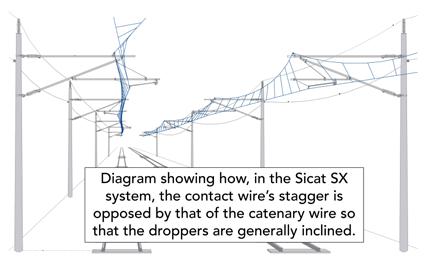

Rail Engineer | Issue 208 | May-Jun 2024 21 ELECTRIFICATION & POWER
A Sicat SX cantilever on which the catenary clamp is offset from the registration arm’s contact wire clip
Eliot explained how the Sicat SX system’s catenary and contact wires are both quite different from those on conventional OLE. It is, for example, more accurate to describe its catenary wire as a cable as this has a core of seven aluminium coated steel wires cables inside an external sheaf of 12 aluminium wires giving it an external diameter of 15mm. Such cables, as specified in European Standard EN 50182, are extensively used for European HV transmission lines and are rated for a maximum tension of 90kN. In the Sicat SX system, they are tensioned at 30kN.
The contract wire of the Sicat SX system has half the tension of the catenary cable, i.e. 15kN. This has an 80mm2 cross section and is a Copper alloy with 0.5% Magnesium content to increase its life. In comparison, Network Rail’s OLE systems typically use contact wires of 107mm2 and 120mm2. Using an 80mm2 contact wire instead of a 107mm2 wire saves 206kg of copper per kilometre. With the reduced use of copper, Sicat SX’s catenary/contact wire system offers a 50% cost saving for conductors over traditional catenary/contact wire systems.
He also noted that despite using less copper this also offers an impedance that is about 10% lower than the current UKMS125 systems which, if Sicat SX were to be widely installed, would offer electricity cost savings of the order of £1 million per annum.
With much longer spans Sicat SX offers tension lengths up to 2,000 metres with fewer tensioning devices and associated anchor structures. With longer tension lengths, it also offers two, rather than three span overlaps. Sicat SX is designed to operate in a temperature range of -30°C to +50°C, compared with the UK standard of -18°C to +40°C. Hence, if Sicat SX’s temperature range was designed for the UK standard it would be possible to further increase maximum tension lengths.
A further advantage is that Sicat SX offers a onemetre reduction in mast height to reduce cost and visual impact. This is because it uses a standard cantilever rather than the inverted cantilever most commonly used by the UKMS.
LOW BRIDGES
In Peter’s experience, low bridges in Denmark were invariably demolished or rebuilt as part of the electrification. This differs from UK practice where the emphasis seems to be to avoid bridge rebuilds wherever possible, without taking full account of whole life costs given the future maintenance and reliability challenges of bridges with minimal OLE clearance. Hence the complexities of getting a 25kV OLE system underneath a bridge with such minimal clearances have not been an issue in Denmark. In the UK, surge arrestors with insulated coatings have enabled clearance between the OLE and the bridge underdeck to be reduced to 40mm as in the case of the Cardiff Intersection bridge.

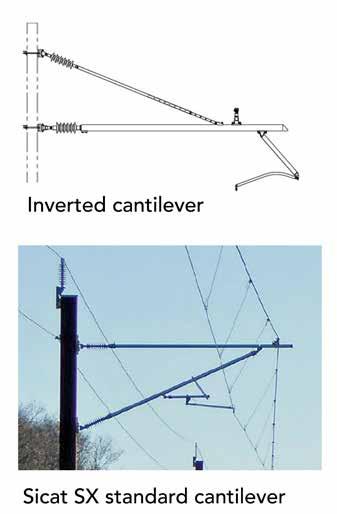
This requires the OLE system height under the bridge to be zero. This is done using a twin contact arrangement where the contact wire is spliced into the catenary and brought down so that it is side-by-side with the contact wire.
For the Sicat SX system that has its catenary cable at twice the tension of the contact wire, this was a potentially problematic issue which had to be resolved before the system could be approved for use in the UK. The solution, however, was relatively straightforward. Before and after the bridge there are splitter plates that separate the catenary into two separate contact wires each of which has a tension of 15kN. Thus, under low clearance bridges Sicat SX has three contact wires side by side.
Rail Engineer | Issue 208 | May-Jun 2024 22 ELECTRIFICATION & POWER
Electrification of the 148 route km between Perth and Aberdeen is a significant part of the Scottish Government’s railway electrification programme. To assess the benefits of electrifying this route with the Sicat SX system, Siemens considered the circa 5,000 masts that would be required using both Sicat SX and the conventional UKMS. This analysis took account of line curvature, how bridges and structures determined mast positions, and OLE wind loading as required by NR/L2/CIV/072.
This work demonstrated that using Sicat SX would reduce the number of masts required by 24% and the number of tension lengths by 25%. With Sicat SX, the average span length is 67 metres which is 32% greater than the 50.9 metre span length of UKMS (these are indicative figures assuming double masts for the entire route). As well as offering large cost savings, this also offers significant delivery benefits as with Sicat SX there would be a significant reduction in the possessions required to install foundations and masts between Perth and Aberdeen.
Siemens estimates that the use of Sicat would reduce the amount of steel required from 7,669 to 5,234 tonnes and the amount of concrete required from 12,973 to 11,439 tonnes, which would reduce the embodied carbon footprint from 14,705 to 11,468 tonnes of CO2E. In addition, fewer OLE masts will reduce future maintenance costs.
It is now seven years since the Government cancelled the Midland Main Line electrification and cut back due to the cost of the Great Western Electrification Programme (GWEP) as a result of GWEP’s costs rising from £874 million to £3.8 billion for the cut-back scheme. At the time, the Government had lost faith in the industry to deliver electrification at a reasonable cost and also decided that electrification was the wrong technology.
Since then, much has been done both to make the case for electrification and win back trust by showing how electrification can be delivered in a costeffective manner. Sicat SX is a further example of what can be done to reduce
electrification costs and so improve the business case for electrification. Now that it has achieved NTSN design certification, Rail Engineer looks forward to seeing its inclined electrification in the UK soon.

ai17175008629_RE - MayJun 2024 - RSA24 Categories Advert -

















































































ABERDEEN CASE STUDY
C M Y CM MY CY CMY K
Rail Engineer | Issue 208 | May-Jun 2024 23 ELECTRIFICATION & POWER
Half page V2.pdf 6 04/06/2024 12:34

the way in Paving European electrification
SwiftLine
As governments and commercial enterprises focus on reaching ambitious sustainability targets, rail electrification is an issue at the forefront of decision-makers’ minds both in the UK and Europe. That said, the rollout is not without its challenges.
Despite investing in the electrification of more than 2,000km of track since 2010, almost two thirds of the UK rail network remain unaddressed, leading the Rail Industry Association (RIA) to conclude it was failing to hit the requirements of its transport decarbonisation plan which sets the ambitious target for a net-zero transport sector by 2050.
This story is mirrored in Europe where, despite clear and decisive action from the European Commission, which has seen a 31% increase in electrified rail since 1990, just 57% of its total rail network is covered.
While the reasons for slow progress remain unclear, the same cannot be said for rail’s innovative supply chain community, which continues to focus more attention on delivering solutions to harness momentum and support for electrification and deliver efficiency in project rollout.
Paul Whittle, group product manager for Rail at Gripple explains why innovation is crucial to unlocking the potential of rail electrification and how its SwiftLine Rail Dropper, approved by Network Rail in the UK and the Federal Office of Transport in Switzerland, is helping engineers maximise possession windows to drive efficiency on electrification projects.
UNLOCKING INNOVATION
The benefits of electrification are far-reaching, and a lot of positivity can be taken in the fact that interest and support for rail electrification continues to grow. But to achieve success there are many challenges to overcome. It’s our job, as an innovation-led supplier to the rail industry, to keep looking forward and deliver problem-solving solutions that address issues and drive efficiency.

ALL
Rail Dropper
PHOTOS PROVIDED BY GRIPPLE
Rail Engineer | Issue 208 | May-Jun 2024 24 ELECTRIFICATION & POWER


To this end, having the right products on hand is essential to ensuring work can be completed safely and efficiently. In 2023, we launched the SwiftLine Rail Dropper, an innovative dropper designed to expedite rail electrification projects by cutting installation times on key elements of work to overhead line equipment (OLE). This not only reduces project durations but also enhances safety and enables more work to be completed within possession windows, optimising the use of limited time.
Highly regarded in the UK market, having already undertaken extensive trials with engineers and contractors, our team is now heavily engaged in trials across Europe. Meeting with contractors and engineers in many European countries, we have begun trials in France, Spain, Portugal, Poland, and Switzerland. In the latter, the Federal Office of Transport (the supervisory authority responsible for rail) has added the product to its directory of approved products, following in the footsteps of Network Rail in the UK and affirming its trust in this innovative solution. These trials have also enabled us to connect with the engineering and contractor communities we serve.
At the heart of it all, the SwiftLine Rail Dropper is a solution that keeps rail engineers safe and ensures possession windows are maximised for routine and emergency maintenance. We value their trust and feedback just as much as the supervisory bodies and there is a lot to be said for the time we spend on-site with these teams. From the beginning, our goal was to understand not just the challenges with electrification more broadly, but also with the installations themselves. It is this feedback and understanding that has allowed us to develop a product that is easier, faster, and ultimately safer to install than a traditional dropper, maximising the benefits for all stakeholders.
DELIVERING BENEFITS
OLE installation and maintenance work is a historically difficult process, often cited as one of the most timeconsuming aspects of rail projects. In delivering the SwiftLine Rail Dropper, our goal was simple - solve this challenge with a simplified, engineered solution. The result is a more efficient and safer dropper that allows engineers to complete work faster, with less effort, and less environmental impact.
At the core of the dropper’s design is a simple, secure quarter turn catenary fixing and an Auto Torque contact wire clamp, which is pre-set to guarantee correct torque every time. This clever design ensures an entirely tool-free installation, with no additional training required – greatly reducing project durations, but also enhancing safety by reducing the traditional reliance on hand tools to manually set the torque. Historically, this has resulted in inconsistent tensions across the line, leading to vulnerabilities in the product’s safety. With the SwiftLine Rail Dropper, this issue is entirely eradicated.
The dropper also comes fully pre-assembled, which means there is no need to cut, crimp, and fix on-site. This saves installers hours on installations and also enhances safety by enabling more work to be completed within possession windows, significantly reducing the time spent working at height and in the dark. Available in a choice of pre-cut lengths and height adjustable to meet a variety of drop lengths, engineers in the trial are also enjoying the versatility available with the product, allowing one dropper to do more than previously possible.
Manufactured end-to-end in the UK, at our state-ofthe-art, vertically integrated facilities, we are also able to offer a greater degree of reactivity in the market. In Europe, we have found that many countries deal with different diameters of wire, and by controlling our own supply chain we have quickly made solutions to suit regional standards.
Vertical integration also ensures we maintain complete control over the quality of the product, which goes through rigorous testing before being delivered to site. This has proven particularly beneficial to contractors from a traceability perspective, where engraved product codes allow installers to trace products right back to the first cut, guaranteeing quality and ensuring they have the trust in the product required to install confidently.
CONCLUSION
The first in a series of game-changing innovations we are launching to support rail electrification, the SwiftLine Rail Dropper embodies our commitment to helping customers achieve more with less. This will undoubtedly have a decided impact on delivering against the ambitious targets set.
It’s clear amongst the engineering community, both in the UK and Europe, that there is a real appetite for change. While it is a long journey ahead, every innovation Gripple and other supply chain partners deliver, makes that journey a little easier, providing solutions that are fit for purpose for the next generation of railways. That is the key to unlocking its potential.
Rail Engineer | Issue 208 | May-Jun 2024 25 ELECTRIFICATION & POWER

West Country signalling upgrades
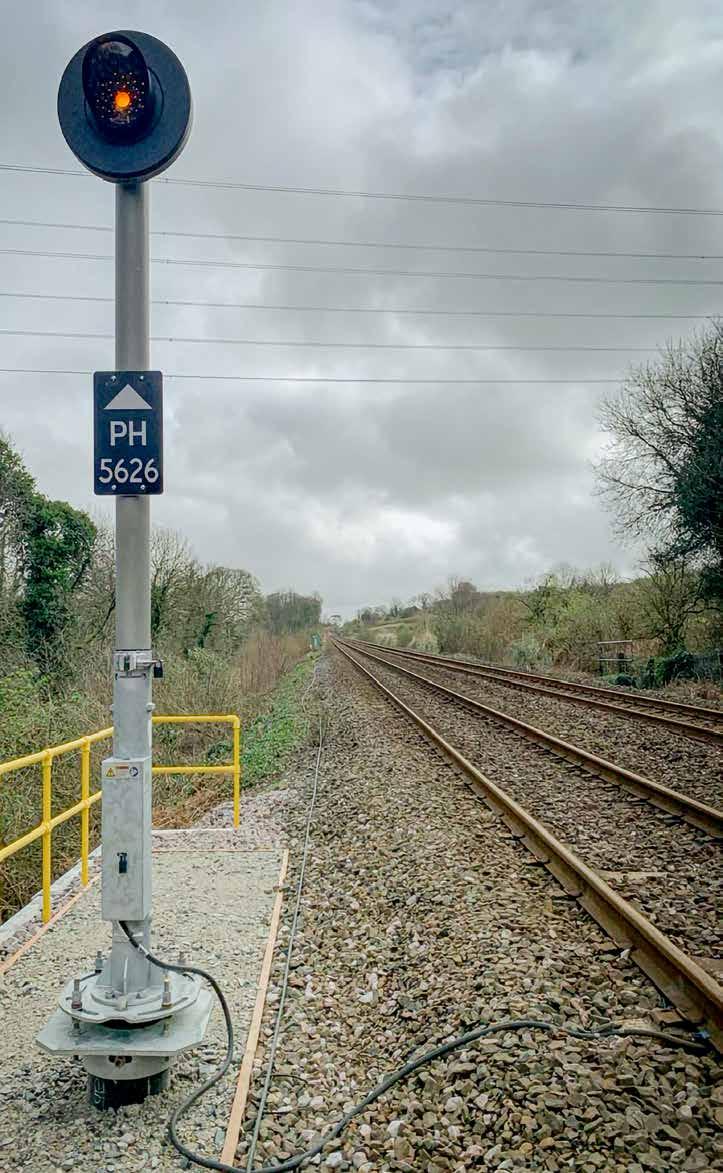


Several recent articles in the railway press have reported on the closure of three mechanical signalboxes in Cornwall as part of an upgrade scheme. Much has been made of the traditional GW lower quadrant signals being replaced with just a touch of sentimentality associated with that. Yet none of these reports have delved into the technology that has replaced the old signalling, nor indeed to explain the reasons for the present project.
Rail Engineer reported in Issue 179 (November 2019), on the introduction of new signalling in Cornwall to achieve a six minute headway in both the up and down directions. That project introduced additional intermediate block sections between Plymouth and Liskeard, Liskeard and Lostwithiel, and Truro and Roskear (near to Camborne); a new control panel at Lostwithiel; and upgrades of level crossings including foot crossings where safety incidents were causing concern. No signalboxes were closed and the lower quadrant signals remained at the box locations. While successful in achieving the capacity gains, it did little to replace the Victorian technology and it was always seen as a stepping stone to eventually bring Cornish Railways into the 21st century.
Visions to modernise the signalling in Cornwall have been around for decades but budgetary constraints have never allowed this to happen and a piecemeal approach is being adopted to introduce more modern signalling. As always in these circumstances, it can lead to work carried out in previous stages being replaced with different technology in the interests of standardisation and contractual preferences. This has been the situation with the latest project.
PROJECT SCOPE
The need to replace ageing and often unreliable equipment has been the principal reason behind the plan. Much has been made of the Cornish element but the signalling equipment to the east of Plymouth was also causing concern. This was a similar scenario to the recent North Wales coast resignalling, and the Western Territory signal engineers duly took note on what had been achieved there. As such, a contract was let to Siemens Mobility for the design and deployment of its modular signalling system in the Lostwithiel, Par, and Truro signalbox areas.
All were to be controlled from Exeter Power Box, plus replacement of signalling and train detection equipment between Plymouth Tavistock junction and Totnes where it butts to the western extreme of Exeter box. A new supplementary panel in Plymouth Power Box was required, since adapting the existing mimic panel was not practical. Plymouth is the oldest power box in the country, having been commissioned in 1960.
Although the track layout has remained essentially unaltered, some changes have been made to improve operational performance and flexibility.
PHOTO: NETWORK RAIL CLIVE KESSELL
Dorman folding signal at Hemerdon
Rail Engineer | Issue 208 | May-Jun 2024 26

Modular signalling has been around for a few years, being developed to reduce the cost of signalling projects on secondary and rural lines. The portfolio of equipment consists of standardised modules that can be manufactured and assembled on a production line and then programmed for whatever the particular application demands. Subsequent testing and proving can also be largely carried out in the factory before being shipped to site for final tests and commissioning. Judged successful, it has been introduced on several re-signalling projects by various suppliers. Modular systems have become the default standard for routes where ETCS may never be justified. The Siemens Mobility product centres around the Westrace interlocking which is based on ladder logic and is different to the WestLock product that derives from the traditional Solid State Interlocking (SSI) used in busier areas. From the interlocking, a local fibre ring is installed to connect the Object Controllers (OC) which feed the associated signals (OCS), points (OCP), and axle counters (OCA). All are fitted with surge suppression to protect against power variations and lightning strikes. From these, the local wiring connects to the lineside equipment.


A further OC is available for level crossings which can be adapted to whatever type of crossing is required. The connectivity uses IP (Internet Protocol) coding. Power requirements consist of a battery backed supply at the interlocking from which a three-core 240V cable feeds all OC cabinets where this is transformed and rectified to produce a 24V DC supply for the signals and axle counters and a 120V DC supply for the points which can be of any type but more usually these days are clamp locks.

To control the interlockings and OCs, a further Siemens product known as Westcad is used as the signaller’s work station located in Exeter PSB. To connect the Westcad to the interlockings, which are often many miles distant, use is made of the Network Rail Telecoms FTNx network that provides a resilient IP coded digital transmission link to ‘points of presence’ along the railway. FTNx is there for the use of all rail disciplines but signal engineers are satisfied that it provides the integrity for the transmission and distribution of signal control information.
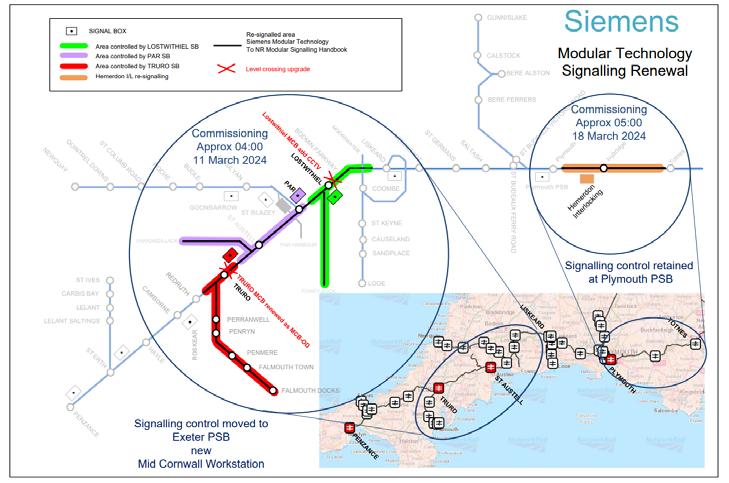
PHOTO: RICHARD EVANS MODULAR SIGNALLING
PHOTO: SIEMENS
Rail Engineer | Issue 208 | May-Jun 2024 27 FEATURE
New Exeter work station covering Cornwall area
THE CORNWALL PROJECT
As stated, three signalboxes have been abolished where age and reliability of equipment was becoming an increasing concern. Westrace interlocking ‘islands’ have been provided at Truro, St Austell, Par, and Lostwithiel, with ‘slave islands’ at Chacewater (the boundary to Roskear) and Penryn on the Falmouth branch, also at Liskeard where the box is retained for the interface to Plymouth. The signalling at Liskeard is unaltered including the retention of track circuits.
The signalling plan was to produce continuous train detection by means of the axle counters but with discrete block sections of a home and distant signal commensurate with the six minute headway. New signals have been provided throughout the Cornish section, most of these being the Dorman fold down type with a single
LED aspect showing either red / green or yellow / green. Connecting the interlockings to the OCs and locally to the trackside items is by the use of armoured cables laid in the cess or in troughing routes where these exist. Recovering old cable is an ongoing challenge.
At Lostwithiel, the existing Intermediate Block (IB) sections at Largin (where the route is reduced to single track over two adjacent viaducts) and at Bodmin Parkway are retained, but have been re-equipped with new signals. The recently installed panel at Lostwithiel and associated SSI equipment has been made redundant but with the intention to re-use these elsewhere. Re-positioning of signals at Lostwithiel station included moving the down home signal westwards in order to prevent stopping trains from fouling the level crossing. The junction for the branch to Carne Point near Fowey is controlled from


the interlocking as are the holding sidings for china clay and engineering trains on the Exeter side of the crossing. Control of the level crossing is now by CCTV monitoring using a 6Mbit link from Exeter PSB where, because of the closer signal sections, the down time of the barriers can be reduced.
At Par, the new signals are located at the end of each platform including the loop line platform, which retains its reversible working to allow trains to and from the Newquay branch to leave the station in either a west or east direction. All points in the station area are controlled by clamp locks from the interlocking, but the junction signal and indicator towards Newquay is mounted on a special twin post provided by Collis. The points that allow china clay trains from Goonbarrow on the Newquay line to be held in sidings are also now fitted with clamp locks which makes it easier to route trains direct into these rather than occupying the Newquay platform. At Burngullow, the St Austell Westrace interlocking controls the access to the china clay works sidings and the branch to Parkandillack. The SSI at Par to control the St. Austell and Probus IB sections has been recovered and the signals are renewed with the Dorman type. Truro has significant passenger train movements because of the busy Falmouth branch with its 30-minute interval service. The track layout and signal positioning have been altered to take account of this. The previous trailing crossover on a curve to the east side of the level crossing has been replaced by a facing crossover on straight track between the two Truro viaducts. This facilitates westbound trains being routed into the up platform should there be a problem on the Falmouth branch requiring trains to depart from the down platform instead of the bay. The level crossing immediately east of the main platforms has been converted to automated obstacle detection operation (MCB OD) but still requires east bound trains to have the barriers closed before the protecting signal into the station can be cleared to green. This is because of the falling gradient from the Penzance direction. The IB sections westwards towards Roskear at Chacewater and Redruth are retained but with new signals provided.
At Penryn on the Falmouth branch, the control of the passing loop is now from the new Westrace slave island although the existing signals and point mechanisms have been retained.
The display of train descriptions which ended at Liskeard is now extended to Roskear as the fringe to the Exeter control panel. A new train describer screen has been provided at Liskeard but, from Roskear to Penzance, traditional block bell signals remain for train type identification.
At Exeter, the Siemens Direct Route Setting (DRS) system is provided which uses timetable data from the nightly download to provide a degree of automatic route setting, but leaves the signallers to make final regulatory decisions. A TMS (Traffic Management System) might be installed later that should assist with optimising train routing and regulation.
PHOTO: NETWORK RAIL
Truro new 9557 S&C crossover supports greater flexibility at Truro to accommodate Mid-Cornwall Metro
PHOTO: CLIVE KESSELL Rail Engineer | Issue 208 | May-Jun 2024 28 FEATURE
Truro Stn Sigs & LXing looking east
THE DEVON ELEMENT
Replacing the unreliable Aster track circuits and improving the line capacity east of Plymouth towards Totnes became part of the overall project. The track circuits are replaced with Frauscher axle counters. The existing signal spacing was not ideal, there being some very long block sections that adversely impacted on capacity, so the decision was made to provide 10 new signal sections equally spaced. This has necessitated the abolition of the Hemerdon loops but, in practice, keeping freight trains moving is a better policy.
A new Westrace interlocking has been provided at Wrangaton (roughly the halfway point) with slave islands at Tavistock Junction and Totnes.

All signals in this section have been replaced with the two aspect Dorman type except at Ivybridge where new three aspect signals are provided to cater for optimum regulation of stopping trains. The power feed has been converted from the 650V lineside supply where voltage drop was a problem, to the new 240V standard as per Cornwall. A new Westcad work station has been installed over the section of redundant panel in Plymouth box to control this section.
TELECOMMUNICATIONS AND RADIO
The policy of providing SPTs at signals has been continued except at the very remotest of locations where track to train communication relies solely on the GSM-R radio. Regarding the latter, the routing of radio calls to the various signallers has had to be adjusted to take account of the new block section positions.
TRAINING AND COMPETENCE
For a railway largely equipped with mechanical signalling and only limited electronics, this project has introduced new systems for which training of the maintenance and technical support staff is needed. The S&T depot for Cornwall is at Par where 18 staff give 24/7 cover working in 12-hour shifts for the area from Penzance to Totnes. To facilitate their training and familiarisation, a Westrace interlocking training suite complete with a signalling control panel, object controllers, signals, and axle counters has been set up in the depot. A five-day training course is given by Setec which is repeated periodically. During the training, faults can be put on for technicians to diagnose and then rectify. The fault log screens at the various interlockings can be replicated in the training room to give staff an understanding on what can happen and what to look for.
At present, the training on clamp locks is carried out at Bristol and that for Westcad work stations is done at Exeter. It is the intention to have a Westcad system provided at Par. For the Devon section, similar training is carried out at Exeter.
The project intention has been to standardise equipment types, hence the removal of SSI units, Thales axle counters, and different types of signal heads and point machines. Having things all the same is a worthwhile objective and helps the maintainer to manage the number of competence certificates that are held and retained.


Reliable lifting and testing equipment for all rail vehicle maintenance.
With over 40 years’ experience of high quality, heavy duty vehicle lifting, Totalkare combines world class products with industry leading support to facilitate effective maintenance and repair.

PHOTO: CLIVE KESSELL
RAIL INSPECTION PITS SAFE INCREASE PRODUCTIVITY QUALITY LIGHTING SERVICING TRAINING LIFTING
Plymouth Hemerdon Work Station
RELIABLE SYNCHRONISED MOBILE
RAIL LIFTING JACKS
Rail Engineer | Issue 208 | May-Jun 2024 29 FEATURE

PROJECT FINANCES AND CONTRACTUAL CONTROL
The project was authorised at £75 million but has ended up costing a fraction over £100 million. Many reasons exist for the increased spend, inflation being the main cause, but there were also delays in getting material and access. The war in Ukraine was a factor as the steel tape armouring for the fibre cables became difficult to obtain.


As to timescale, these factors have introduced delay; the Cornwall area was due for commissioning in November 2023 but was put back to February/March 2024 and the Devon section which was due in February was delayed to just before Easter 2024. Compared to other projects, this represents only minor slippage.
Most of the problems have been with the civil engineering elements where a shortage of labour available to work, stay, and/or commute was a challenge. Eventually, Siemens was able to increase the workforce by transferring contractors from South Wales after finishing Port Talbot West re-signalling and Transport for Wales (TfW) projects in the Cardiff Valleys. The ceasing of red zone working or restrictions on walking has been a factor with most deliveries, with work being achieved during short possession periods in Cornwall. However, in conjunction with GWR and CrossCountry, Network Rail was able to agree extended midweek access through the Hermerden area to achieve improved overnight working arrangements over a period of 18 weeks during the autumn and winter. This helped to control the increasing project cost.
The contract methodology was the hub and spoke arrangement with Network Rail being in overall control, Siemens Mobility being the equipment supplier plus subcontractors working for them and Construction Services doing the track alteration work.
Additional work was undertaken by Colas Rail outside of the main re-signalling footprint to carry out renewal and upgrades to two level crossings on each of the Looe and Gunnislake branches, plus other minor renewals of signal structures in Cornwall. Three of the level crossings upgrades were completed in March concurrent with the re-signalling programme.
POST COMMISSIONING AND THE FUTURE
The commissioning required blockades and bus substitution but since being brought into service, the system has worked well, and the benefits are being realised. Some niggling faults have emerged but that is typical while equipment beds in. Overall, the system is yielding significant performance benefits and should be a potential catalyst for ongoing transport improvements across Cornwall in the coming years.

For the future, mechanical boxes remain at Liskeard, Roskear, St Erth, and Penzance along with the ageing power box at Plymouth. Eventually, these will have to be replaced. Network Rail has commenced the development of a Plymouth resignalling project and will assess the other mechanical boxes for a future control period. These may be around for a good few years yet.
Thanks are expressed to Richard Evans, programme manager for Network Rail and Simon Rhodes, the Network Rail technical expert, for the opportunity to visit the sites and have the project explained in detail.
CLIVE KESSELL
PHOTO:
Rail Engineer | Issue 208 | May-Jun 2024 30 FEATURE
Par Local Fibre Ring Terminal Boxes


If you have a safety concern, make the right call and report it. Tell your supervisor, or contact us in complete confidence. Call 0800 4 101 101 or download our CIRAS reporting app. Scan me We find safety in listening.
Hope ValleyRailway Upgrade



Hope Valley is a trans-Pennine railway line between Sheffield and Manchester which dissects the scenic Peak District National Park. The route connects Liverpool, Warrington, and Manchester Airport to the West and Nottingham, Norwich, and Cleethorpes to the East. Rail traffic on the route is mixed and the train service delivered a poor rail connection between Manchester and Sheffield, compared to other comparably sized cities.
The line has recently received an upgrade to provide more reliable and better rail journeys, and Rail Engineer recently met Graeme Whitehead, senior sponsor Network Rail for the Hope Valley Railway Upgrade to hear more of its success.

The origins of the project go back to the Manchester / Northern Hub programmes to improve and increase train services in the north and reduce journey times. The Hope Valley Railway Upgrade started in Spring 2021, was completed to plan in Spring 2024, and has removed several bottlenecks to allow passenger trains to overtake slower freight trains along the line.
The main improvements include: a new platform and accessible footbridge with lifts at Dore & Totley station; a new railway
loop between Bamford and Hathersage; improved safety at Hathersage West with a new overbridge to replace the foot crossing; signalling improvements and recontrol to improve reliability; and platform extensions to allow for more train carriages.
Passenger services on the line are operated by Northern Trains, East Midlands Railway, and TransPennine Express, with the quarries around Hope Valley producing stone and cement which are carried predominantly by rail freight operators. The route therefore has to accommodate both local, long distance passenger trains, and freight traffic all on a two-line railway.
The route is a designated up line towards Sheffield and down line towards Manchester. From Sheffield, the line follows the Midland Main Line through the south-west of the city
ALL PHOTOS: NETWORK RAIL Rail Engineer | Issue 208 | May-Jun 2024 FEATURE 32
PAUL DARLINGTON
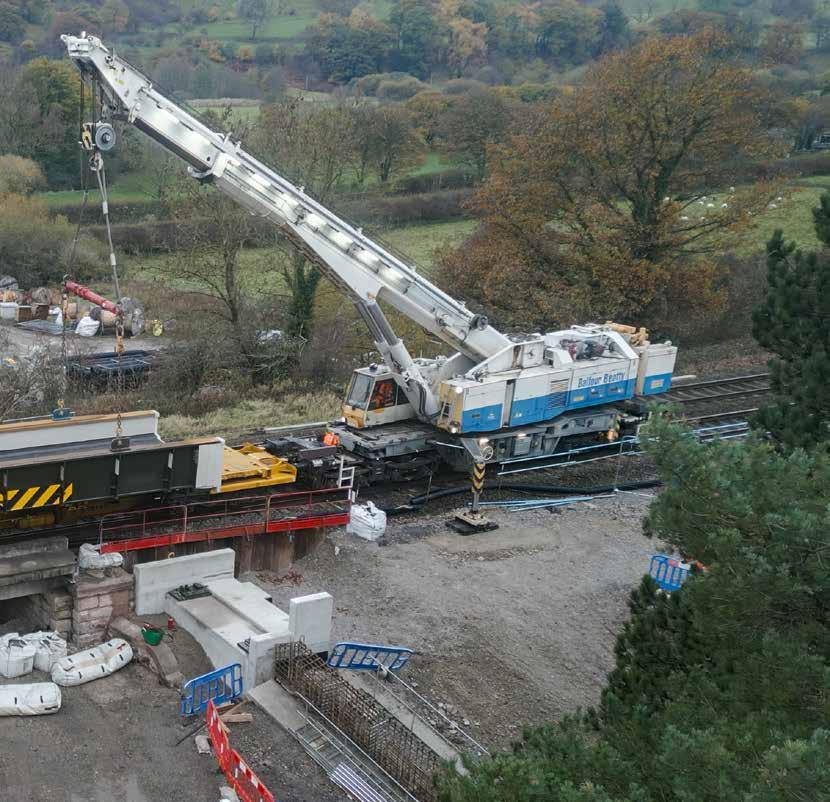
to Dore & Totley station, where the Hope Valley line branches off to run through the 5.7km Totley Tunnel. When the tunnel was completed in 1893, it was the secondlongest in the UK – the Severn Tunnel being 1.3km longer. Only in 2007 did Totley Tunnel become the fourth longest mainline railway tunnel in the UK, after the two High Speed 1 tunnels were opened south of London.
The line emerges in the picturesque Hope Valley area of Derbyshire, where it passes through the stations of Grindleford, Hathersage, Bamford, Hope, and Edale before entering the 3.4km Cowburn Tunnel, the deepest railway tunnel in England at 875 feet (267 metres).
From the western portal of Cowburn tunnel, the line runs through Chinley then splits. The northern branch runs via New Mills Central towards Manchester Piccadilly and the southern branch passes through the 3.5km Disley Tunnel before merging with the Buxton line. It then heads to Stockport to join the West Coast Main Line into Manchester.
UPGRADE INTERVENTIONS
The Hope Valley Railway Upgrade is essentially a capacity scheme to provide more services and better reliable connectivity between Sheffield and Manchester, and onto Manchester Airport. The changes have provided the capability for an additional fast train path per hour, although currently constraints at Sheffield and Stockport prevent the introduction of the additional services. From Edgely Junction to Hazel Grove, signalling interventions have been carried out and commissioned in January this year to increase the line speed from 40mph to 60mph, and Woodsmoor level crossing has been made ‘auto lower’ (operated by train detection) to help manage the signallers workload at Edgeley Junction Number 1 signal box when the additional train path on the route takes place. Some power cable and other minor signalling renewals have also been carried out in the area.

Rail Engineer | Issue 208 | May-Jun 2024 FEATURE 33


Targeted interventions have been implemented along the line out to ‘smooth out’ the castellated speed profile along the route which had some very short sections (typically a few hundred metres) of higher line speed. Drivers would never have achieved the line speed over such a short distance, so the changes have improved the driveability of the route, the track category and maintenance regime requirements, and provided some small carbon benefits.
No significant changes have been made to New Mills, Chinley, Edale, and Earls Sidings signal box areas, but both Grindleford and Totley Tunnel East mechanical signal boxes have been closed, with the control area resignalled and recontrolled to York Rail Operating Centre (ROC) and Sheffield outer work station using Alstom Smartlock signalling, a new lineside SMART I/O interface and Frauscher axle counters. Earles Sidings signal box is now the fringe to the York ROC, and the regional boundary between the North West & Central Region and Eastern Region has been moved west. This is to ensure that there is consistency with operational control, asset stewardship, and maintenance delivery.
The resignalling of Grindleford also supports the connection into a new loop between Bamford and Hathersage stations to allow passenger trains to pass slower freight trains. The loop is located on the up side, so it will benefit both the pathing of the cement traffic from Earls sidings and other freight trains travelling East. Often, when freight loops are provided on the network, they can be accommodated on railway land previously used for railway lines, but the Bamford loop has required an order under the Transport and Works Act 1992 (TWAO) together with land acquisition.
A TWAO process allows the secretary of state to make to an informed view on whether it is in the public interest to make a TWAO and there is a lengthy robust set procedure to allow anyone to give their views on the proposals. So, a lot of work was required to obtain the TWAO before any physical work could commence.
Constructing the loop required some significant earthworks and structures construction, including a bridge extension in Bamford and three culvert extensions to allow water to adequately run beneath the railway. Extensive soil nailing was required to support the new earthworks along with substantial under bridges, one of which went over an aviation fuel pipeline and a power cable. The records for the route were found to be inconsistent with the as-built position and alterations to the initial design were required to ensure the bridge extension did not adversely affect the services. This required involvement of the utilities owner to resolve the issue. The loop itself required a total of 1,323 sleepers, with 3,600 tonnes of ballast for the bottom and top stone.
Hathersage West level crossing has been replaced by a footbridge to improve public safety and another project has provided a Miniature Stop Light (MSL) installation for Hathersage East level crossing.
Rail Engineer | Issue 208 | May-Jun 2024 34 FEATURE
Grindleford Overhead
DORE & TOTLEY STATION
Originally opened as Dore and Totley in 1872, in 1894 the station became the junction for the then new Dore and Chinley line (now the Hope Valley line). Over the years the line between Sheffield station and Dore was widened, and Dore Station junction was made to the north of the station.
In the 1960s the station was closed to main line traffic and became an unstaffed halt and in 1971 was renamed Dore station. The island and eastern platforms were demolished in the mid-1980s and in 1985 the Hope Valley line through the station was converted to single-track, with trains in both directions stopping at the one remaining platform. The name Dore & Totley was restored in April 2008, but as more train services have been introduced the single-track section through the station became a significant bottleneck.

So, as part of the Hope Valley Railway Upgrade an additional ‘down’ platform (new Platform 1) has been constructed and connected to the station via an impressive fully accessible footbridge. The existing platform (was Platform 1 up and down, now Platform 2 up) has been lengthened from 100 metres to 152 metres in order to accommodate six-car trains rather than four.
The previous single line has also been doubled between Dore West Junction and Dore Station Junction. The platforms have been constructed to a high standard, with the facilities including customer information displays and public address.
Dore South curve runs from Dore South Junction to Dore West Junction and is used by freight trains from the Midland main line connecting to the Hope Valley route. The curve has been extended to cater for 500-metre-long trains and to provide more standage on the curve to prevent freight trains standing on the Hope Valley down line. This has required extensive work to enlarge the cutting towards Totley Tunnel. Some of the embankment was stabilised using thousands of soil nails. Due to unfavourable ground conditions the design required amendment further towards the station and a contiguous piled retaining wall has been used to replace the soil nails due to the sheer amount and weight of the earthwork being held back.
Between Dore and Sheffield there have also been some minor speed increases introduced on the Heeley Loop located on the down line.
JOINT VENTURE DELIVERY

The main works needed to improve capacity and connectivity between Sheffield and Manchester were delivered by a VolkerRail and Story Contracting Joint Venture (JV), called VolkerRailStory JV. Volker Rail undertook the signalling and telecoms (supported by Alstom signalling), together with the track scope, and Storey undertaking the civil engineering works. The VolkerRailStory JV also delivered community projects, including volunteering, schools engagement, work placements and other opportunities for young people. Keller Ltd delivered the extensive soil nailing and a video showing the extent of the works can be found by following the QR code.

A signalling simulator for the Hope Valley line was provided at the York ROC by Hitachi. Hitachi’s simulation, known as TREsim, emulates the Alstom workstation and provides trainee signallers with an environment controlled exactly as the live railway, with the ability to run scenario-based sessions.
An innovation which the Hope Valley had to introduce and commission was the first use of the Alstom SMART I/O interface for the Frauscher axle counters. This interface provides the ability to connect devices to the Alstom IP network-based architecture object controller, instead of using legacy communications back to the interlocking. This allows faster troubleshooting and enhanced availability.
A number of other projects were planning to commission the new interface and be ‘first in class’ before Hope Valley, but for various reasons their timescales slipped, so the Hope Valley upgrade project had to take on the product trial and approval leadership. This occurred only five weeks before commissioning. The Hope Valley project was added to the trial certificate and additional test paths were required to prove the new product. However, all went well, the device was approved and installed, and this did not affect the Hope Valley timescales.
The works to create Bamford Loop were undertaken throughout 2023 due to the nature of all the interventions and multiple under bridges, with commissioning early in 2024 along with the resignalling and recontrol of Grindleford and Totley East signal boxes.
Edgely Junction to Hazel Grove speed and other improvements were originally planned for September 2023, but were changed to January 2024 because of issues with driver training material. The Dore and Totley track doubling and station works were delivered during a nine-day blockade, with commissioning on 25 March, and the final track drainage works were completed during a five-day blockade at the end of April.
CONCLUSION
In addition to signalling and station improvements, a total of 3,923 metres of new track, including the new loop, has been installed to provide additional passing places for trains and improve the reliability of services along the Hope Valley route. We hear of some railway projects with escalating costs and extended timescales, but quietly in the background there are projects such as the Hope Valley Railway Upgrade, making the most of the resources available to improve public transport with more reliable and better rail journeys. Everyone involved in the Upgrade deserves to be congratulated for its success.

Rail Engineer | Issue 208 | May-Jun 2024 35 FEATURE
Dore & Totley footbridge
HS2: Progress on a grand scale
HS2 is the biggest construction project in the UK. David Shirres’ article in Issue 207 (March/April 2024) discussed many of its key features including 32 miles of tunnels (five bored and five ‘cut and cover’), together with 50 major viaducts including 11 viaducts just for the delta junction to the north of Interchange station. With all this going on it’s easy to overlook the fact that most of these sites would be regarded individually as major construction projects.

With construction proceeding apace, HS2 is increasingly showing off progress. Your writer is not as familiar with civil engineering projects as he is with rolling stock and those he has seen tend to be on very constrained sites for projects in London. This report, about two recent visits, showed that much of HS2’s construction is on a much bigger scale, but even then, teams still have to contend with constrained sites even though the sheer scale of the work is amazing.


MALCOLM DOBELL
PHOTO: HS2
Rail Engineer | Issue 208 | May-Jun 2024 GEOTECHNICS, EARTHWORKS & CONCRETE 36

THAME VALLEY VIADUCT

Whilst not the longest bridge/viaduct on HS2, it is 880 metres long and, in any other situation, would count as a major project in its own right. But here it is just one more significant construction undertaking as the line carves its way through the Chilterns and south Midlands.
As Bob Wright outlined in his article in Issue 204 (Sept/Oct 2023), this is a novel design in many ways. Unlike more traditional viaduct designs, every major element is being manufactured in a factory before being slotted together on site like a giant Lego set, cutting its carbon footprint by around a third. The main contractor is EKFB - a consortium of Eiffage, Kier, Ferrovial Construction (FC) and BAM Nuttall, which has worked with its design partner, ASC (a joint venture between Arcadis Setec and COWI) and specialist architects Moxon.
On a sunny day in early May 2024, Rail Engineer visited the site near Aylesbury Vale Parkway station to see progress at the half-way milestone. On arrival, EKFB Project Manager Emma Bolado Arroyo, and HS2 Senior Project Manager Ben Sebastian-Green outlined progress before being transferred by minibus the mile or so to the construction site itself where Noel Cooper, FC Civils Solutions project manager, explained the details as we toured the site.
The viaduct will carry the railway over a flood plain, so it was necessary for the contractors to make the land stable enough to carry the plant (up to 600-tonne cranes) and materials necessary for excavation and construction. The contractor’s office was established just south of a newly constructed roundabout on the A41 and from there a 1.5km road was built to the north end of the viaduct where a site office has been built.
The footprint of the land available for construction (defined in HS2 legislation) is around 2.5 times the width of the viaduct, and on the east side of the line of the viaduct, a two-way causeway was constructed, which employed European style right hand running for a while to keep the heaviest laden vehicles away from the edge of the causeway.
PHOTO: HS2
Location of the Thames Valley Viaduct
Rail Engineer | Issue 208 | May-Jun 2024 GEOTECHNICS, EARTHWORKS & CONCRETE 37
Thame Valley Viaduct looking north

BACKGROUND
As Bob Wright reported, three key elements of the construction – piers, beams, deck panels, and parapets – have been manufactured off site, although none of the latter had been delivered at the time of the visit. All, that is, except the piers at the centre of the viaduct which have been cast in situ. These are more substantial than the others and act as anchors for the beams. Radiating from these piers, the pretensioned beams are supported on bearings, and each is firmly connected to the next with tensioned connectors. The bearings have to accommodate expansion and contraction of the beams, a figure of up to 450mm was mentioned. Also cast on site were the abutments.




When the construction method was being discussed, the scale of the challenge became clear, especially for installing the beams. These are 25 metres long and weigh nearly 100 tonnes. There are 64 beams in total plus eight slightly shorter 20-metre beams, totalling 2 x 880 metres overall length. The beams can only be lifted when the windspeed is below 25km/h. The beams are transported from Pacadar’s Isle of Grain factory to site and lifted directly into the piers.
As the beams represent a special load that must travel with an escort and only at agreed times, the journey from the factory to site effectively becomes part of the construction process. The truck can only depart from the Isle of Grain if the following day’s weather forecast shows an acceptably low wind speed. Moreover, if the truck arrives and the wind speed had risen above the limit, the truck is stranded until the wind speed falls. If the wind speed is above limits, there can be no lift. Added to this constraint, the causeway is blocked when lifting is taking place, so material movement must be planned around beam lifts.
Rail Engineer was able to see that most of the beams have been installed and connection and tensioning of the beams has started. Many of the deck planks were in place and installation of re-bar had started, ready for pouring in situ deck concrete.

PHOTO: HS2 PHOTO: HS2
PHOTO: HS2
PHOTO: MALCOLM DOBELL
PHOTO: MALCOLM DOBELL
Factory Pier (above) Cast-on-site Pier (below)
Rail Engineer | Issue 208 | May-Jun 2024 38 GEOTECHNICS, EARTHWORKS & CONCRETE
Beams installed on piers with temporary supports (L), telephoto image along hollow beams prior to connection and tensioning (R)


Only at the southern end is construction a little slower whilst the contractors await the electricity network operator to disconnect an overhead power cable and connect it to an underground cable that has already been installed. The finish of the factory-made piers beams was excellent, and it was obvious that a great deal of effort had been made to replicate that finish on the piers that had been cast on site.
In case you’re wondering about the height of the viaduct, it is about 3 metres. As a naïve rolling stock engineer, your writer asked whether an embankment might have been simpler, only for it to be explained that there needed to be a bridge over the river Thame anyway and there would need to be so many other bridges and culverts to accommodate footpaths and water moving around the flood plain, that it worked out simpler to build a viaduct.
Handover to the track/signals/OLE contractor is forecast to take place during 2026.




PHOTO: HS2
PHOTO: HS2
PHOTO: MALCOLM DOBELL PHOTO: MALCOLM DOBELL
PHOTO: HS2
PHOTO: MALCOLM DOBELL
Beam lifting manoeuvre
North abutment. Site office in the background
Beam connection underway
Rail Engineer | Issue 208 | May-Jun 2024 39 GEOTECHNICS, EARTHWORKS & CONCRETE
Offsite manufactured deck planks fitted to beams
Washwood Heath HS2 Site Layout (not to scale)

BROMFORD TUNNEL PORTAL, WASHWOOD HEATH
This invitation was to see ‘the completion of the Washwood Heath portal of the 3.5-mile Bromford Tunnel’. This is also to be the site of the maintenance depot for HS2’s trains and its main control centre. Nothing prepares one for the scale of the site, though. This is an area famous for transport as it is the former site of Metro-Cammell (Tube trains, Mark 4 coaches, Pendolinos) and Leyland-DAF Van (LDV) factories. The site is 2km long and 600 metres wide at its widest, some 65 hectares (100 football pitches) in area. Images on Google Maps or in print do not do it justice, and even on a site visit, one fails to appreciate the full scale.
The contractor carrying out earthworks and constructing the portal is a consortium of Balfour Beatty VINCI (BBV). Tim Cook, its project manager described the work. This is a brownfield site and there were many buildings in situ when the contractor arrived. These were demolished and all concrete was crushed and graded for re-use on site. Due to its industrial past, there was a lot of contamination (mainly hydrocarbons). BBV worked on the principle of ‘remediate the soil to an acceptable level by fixing or reducing the current contamination level’ and this was carried out with the support and approval of the Environment Agency.
Approximately 60,000 cubic metres of soil has needed some form of remediation, but this pales into insignificance compared with the amount of soil moved on this undulating site. It is planned to excavate 1.643 million cubic metres of which nearly 1.4 million has been completed. Much of this was moved within the site (one million cubic metres out of 1.2 million) and much of the remainder is being transported along a specially built road to various sites around the delta junction.
The tunnel portal looks small in the site diagram, but when put into a human scale it becomes clear that it is a huge construction in its own right. It is a 750-metre-long cut and cover, top down constructed structure built by Bachy Soletanche and Balfour Beatty Ground Engineering (SB3) taking the track from the Bromford Tunnel portal, 22 metres below ground level up to surface level. Each side of the open top box was constructed by digging 35-metre-deep, 1.25-metre-wide trenches in 10-metre longitudinal panels filled with reinforced concrete with horizontal beams between them to react lateral loads.
Soil was removed down to a depth of approximately 5 metres and more horizontal beams were constructed before digging down to foundation level circa 3 metres below what will be track level. Here, numerous piles were sunk into the ground to anchor the box into the ground to react the upward pressure of ground water. So far, 44,000 cubic metres of concrete has been
poured into the portal works and as much again is still to be poured (finishing concrete and further reinforced concrete in the base of the box to prepare for later construction of the track slab).
In the area adjacent to the portal, a 7-metre-deep sump will be dug to collect surface water that will be pumped into surface ponds that will drain into the adjacent River Tame (not to be confused with the River Thame mentioned above). The spiral access stairs give a scale of the box depth.
 Aston Church Road Bridge
Key:
Purple: Extent of site
Blue: Bromford portal and box
Red: Extent of depot site
Yellow:
Left: Sidings (top) and Driver/ Service Staff Building (bottom)
Middle: Network Integrated Control Centre
Right: Maintenance building and wheel lathe
Aston Church Road Bridge
Key:
Purple: Extent of site
Blue: Bromford portal and box
Red: Extent of depot site
Yellow:
Left: Sidings (top) and Driver/ Service Staff Building (bottom)
Middle: Network Integrated Control Centre
Right: Maintenance building and wheel lathe
PHOTO: HS2 / GOOGLE EARTH
Saltley Viaduct (off map)
PHOTOS: MALCOLM DOBELL Rail Engineer | Issue 208 | May-Jun 2024 40 GEOTECHNICS, EARTHWORKS & CONCRETE
Spiral staircase access to bottom of box providing a scale to the height of the box


The Bromford tunnel is being constructed using two tunnel boring machines (TBM). The first, Mary Ann, is due to reach the portal in December 2024/ early 2025 with Elizabeth following in mid to late 2025. The spacing of the lateral concrete beams at the top of the box provides for the TBMs to be dismantled and lifted out section by section.
Alvin Pedzai, HS2 project manager, described the other works being carried out near the Washwood Heath Depot site. To the west at Saltley there are two existing road bridges (Aston Church Road Overbridge and Saltley Viaduct) over the existing Birmingham-Derby line. Both structures will be replaced to provide adequate vertical clearance above the new HS2 rail lines. A significant constraint is that both these bridges are important road connections into Birmingham, so the works will be phased so that only one of these bridges will be closed to vehicle traffic at any given time during construction.
DEPOT
Damian Wheeler, head of Washwood Heath, HS2 Ltd, explained how the depot will be built on the now-flat areas delivered by BBV. There will be a 300-metre-long, eight track maintenance building at the east end of the site, each track able to accommodate one HS2 200-metre train.
At the west end of the site there will be 16 stabling sidings, each capable of accommodating two coupled 200-metre
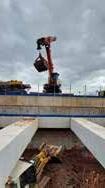
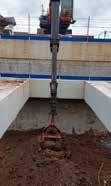
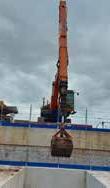


trains. Trains will be able to enter and leave the sidings from/to the main line under ATO control. There will be accommodation for drivers and servicing staff adjacent to the sidings, and the main Network Integrated Control Centre (NICC) will be located between the maintenance shed and the sidings. Damian said that the contract for construction will be let later in 2024. Rail Engineer described the concept for the depot in more detail in Issue 203 (July/Aug 2023). When the depot and NICC are in operation, it is expected that 550 people will be employed on site. In addition, in the area to the south of the depot, there will be about 30 hectares of land handed over for commercial development that is estimated to create 1,000 jobs.
IN CONCLUSION
Your writer is sure there will be many more intermediate and completion events to celebrate before HS2 civil construction concludes. Some highlights to look out for will be walking tunnels, visiting the three stations (and Euston eventually) as well as the delta junction with its multiple levels and viaducts. Rail Engineer’s writers will be busy!
With thanks to HS2’s Alastair Cowan (Thame Valley Viaduct) and Pippa Whittaker (Washwood Heath) for their assistance with this article.
PHOTO:
HS2
Bromford Tunnel portal
Looking away from the portal: excavation continues
Levelled site taken from approximately the east end of where the maintenance building will be located
Artist’s impression of completed site
Excavation method
Rail Engineer | Issue 208 | May-Jun 2024 41 GEOTECHNICS, EARTHWORKS & CONCRETE
PHOTOS: MALCOLM DOBELL
EARTHWORK EXAMINATIONS
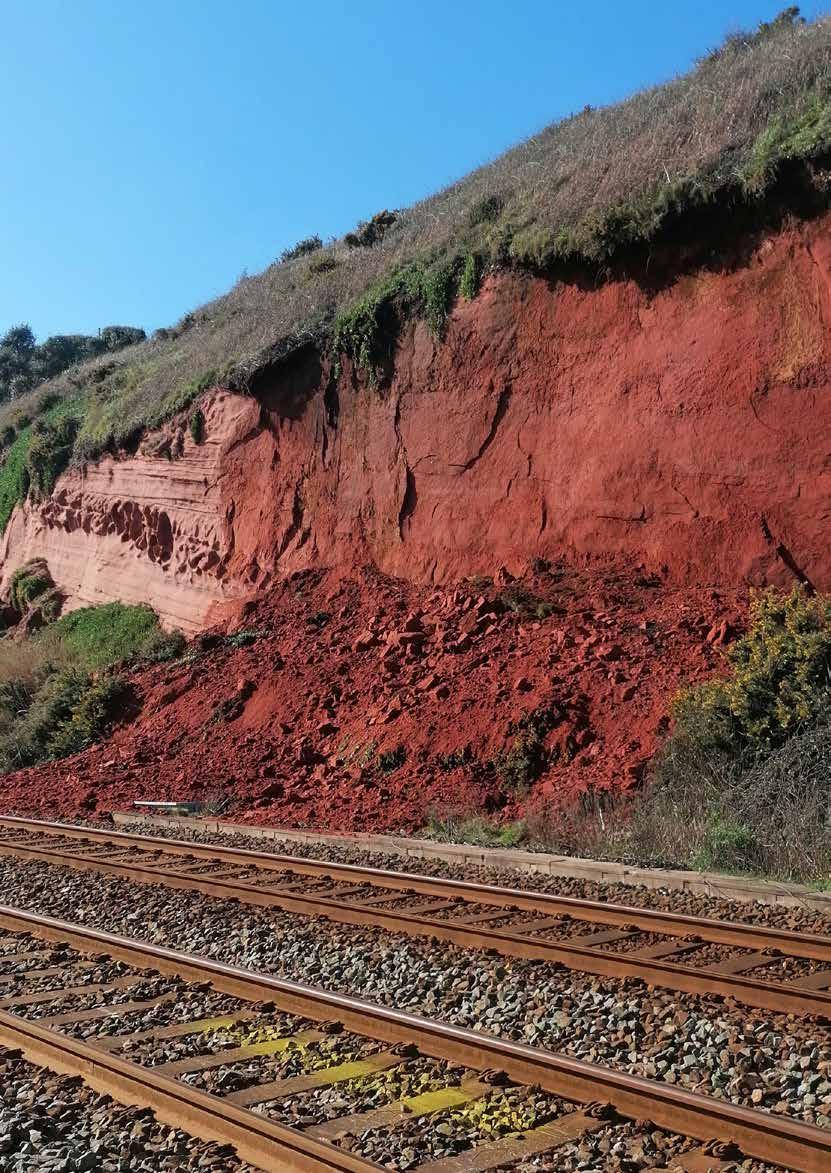

It is a late December morning. The sky is a leaden-grey, the temperature is in single digits, it is starting to rain and the wind makes it feel a lot colder. A GeoAccess earthwork examiner starts up the GISmapp application and opens up the record of the first of many earthwork assets to be inspected. They beckon to their vegetation management team “lets go”, and so begins another day of earthwork examinations. Across England and Wales dozens of our earthwork examiners do the same.
No drones and certainly no robotic dog here; this is Human V1.0 and the accompanying Mk 1. Eyeball. It is niche and highly specialised work, requiring a special type of person; there are fewer than 100 earthwork examiners working across England, Scotland, and Wales during any
given examination season. As sole framework contractor responsible for earthwork examinations in Network Rail’s Southern, Wales, and Western Regions, GeoAccess employs the majority. We select the very best, looking for that special blend of knowledge, experience, perception, and intuition.
Rail Engineer | Issue 208 | May-Jun 2024 42 GEOTECHNICS, EARTHWORKS & CONCRETE
ROB FISHER

EARLY-WARNING SYSTEM
The 2023/24 season will see our earthwork examiners inspect over 15,600 individual five-chain lengths, comprising cuttings, embankments, and rock slopes. Ahead of this, enabling works to clear vegetation will be undertaken, alternative access points to reduce the need for line blocks and possession will be determined, and sites requiring rope access will be identified.
The process of inspection remains largely unchanged since the early days, a detailed visual assessment that requires a keen eye. Not just for the obvious signs of slope instability but the subtle, less discernible features and other factors, notably the condition of drainage, retaining structures and, more recently, outside party slopes. Our earthwork examiners are the early-warning system, often calling in issues that may pose a risk to the safe running of trains, or an urgent defect that requires prompt action, not just for earthworks, but also structures and dangerous trees, particularly following storm-events. While technology is available for other methods of inspection, such as LiDAR surveys and producing 3D digital twins, the scale and number of assets to inspect means that from a practical, feasibility, and compliance standpoint, applicability is reserved for special inspections of problem assets. As the technology improves, along with Big Data handling, machine-learning, and AI, the problems of scale will eventually be overcome. In the interim, our earthwork examiners provide feedback on the GISmapp application such as improvements to enhance the user-interface to allow greater efficiency, and data checks for erroneous or conflicting information prior to completing an exam to ensure quality and compliance are maintained to a high standard.
We work closely with Jeremy Benn Associates (JBA), developers of GISmapp and the maintainer of the Earthworks Database, to seek continuous improvement and efficiencies. A new chapter of collaboration with JBA will begin shortly as we look to the latest in innovation and technology to elevate earthwork examinations to a new level for the 21st century. A successful trial with One Big Circle, developers of the AiVR platform, means we can now capture video with our drones and have it precisely geo-located to ELR, mileage, and side of the line. Going forward, we will use video surveillance on the Cornish Main Line between Dawlish Warren and Teignmouth to monitor the vulnerable rock formations that form the cliffs as a supplement to our regular foot patrols of the section.
RAPID RESPONSE
At time of writing (April 2024), GeoAccess has attended 373 earthwork incidents since the summer of 2020, when our records began. The Network Rail Southern Region accounts for 51% of the total (Wales 30%, Western 13%, others 6%). With the number of named storms and associated high-intensity rainfall events increasing each year, climate change is having a significant impact on earthworks. January 2023, a period of prolonged wet weather, saw the southern half of England receive above average rainfall. Consequently, 25 earthwork incidents occurred during that month (the highest total for a single month), of which 19 occurred in the Southern Region. The upward trend continues, for the period January to March 2024, GeoAccess has responded to 60 incidents, compared to 46 for the same period in 2023.
A strategic review of our rapid response service is currently underway, which will include a review of records to identify weather-related earthwork ‘hot spots’ across the regions we work in. This will help us to provide additional earthwork examiners when severe weather is forecast to impact those areas, in anticipation of multiple incidents occurring.


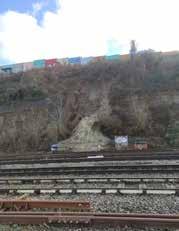
WHAT NEXT FOR GEOACCESS?
Growth of the business, through continuous learning, innovation, and collaboration, and being our best, is at the forefront of everything we strive for. The coming months look to provide some interesting and exciting opportunities in respect of collaborative working with past and current partners, not just in earthworks but other disciplines for which we are strongly positioned.
This year will see significant recruitment as the upcoming 2024/25 earthwork season will be our biggest to date. In response to the increase in numbers of earthwork examiners, one of our priority internal projects is the continued expansion of our learning and training platform, GeoAccess Academy, including developing VR training for earthwork inspections in partnership with Techcare Digital.
Beyond 2024 may well see our gaze extend towards Europe.
ALL PHOTOS PROVIDED BY GEOACCESS
Rail Engineer | Issue 208 | May-Jun 2024 43 GEOTECHNICS, EARTHWORKS & CONCRETE

Inspired by innovation –
RIA’s 2024 Innovation Conference


It is not surprising that the Railway Industry Association’s (RIA) annual innovation event won the 2023 Association Excellence Awards for ‘Best longstanding association event’. With over 400 delegates, this was RIA’s biggest ever such conference. It featured around 20 key speakers and 70 stands, of which 11 were in the Future Focus Zone which showcased the latest technologies. This year’s event was held on March 26-27 in Wales at Newport’s International Conference Centre. Its theme was ‘inspired by innovation’.
RIA’s Innovation Conference was first held in 2009 at a time when rail innovation was hardly mentioned. This year’s conference was the fifteenth such event. Over the years there has been increasing recognition of the importance of innovation and the need to embrace digital technologies. At this year’s event, a frequent theme was Artificial Intelligence (AI) and robotics, with various robots on display.

PASSENGER FOCUS
RIA Chief Executive Darren Caplan welcomed delegates as he opened the conference. He recognised that previous years had been difficult, with Covid and the cancellation of HS2 phase 2. Furthermore, the industry still needed more certainty, especially in respect of rolling stock orders. Yet the CP7 settlement provided confidence in respect of maintenance and renewals work and there were many opportunities for industry to effectively address the challenges it faces for which innovation is essential.
The action being taken to address Network Rail’s four key priorities of boots off ballast, weather resilience, better asset knowledge, and driving efficiencies through innovation was described by Robert Ampomah, Network Rail’s chief technology officer. He explained how this was being supported by the rail industry’s research, development and innovation (RD&I) programme which has eight themes:
1. Passenger experience and accessibility.
2. Freight capability.
3. Traction decarbonisation.
4. Environment and social sustainability.
5. Optimised and resilient operations.
6. Automation.
7. Optimised and resilient assets.
8. Digitisation and data.
PHOTO: RAILWAY INDUSTRY ASSOCIATION
DAVID SHIRRES
Rail Engineer | Issue 208 | May-Jun 2024 44 FEATURE
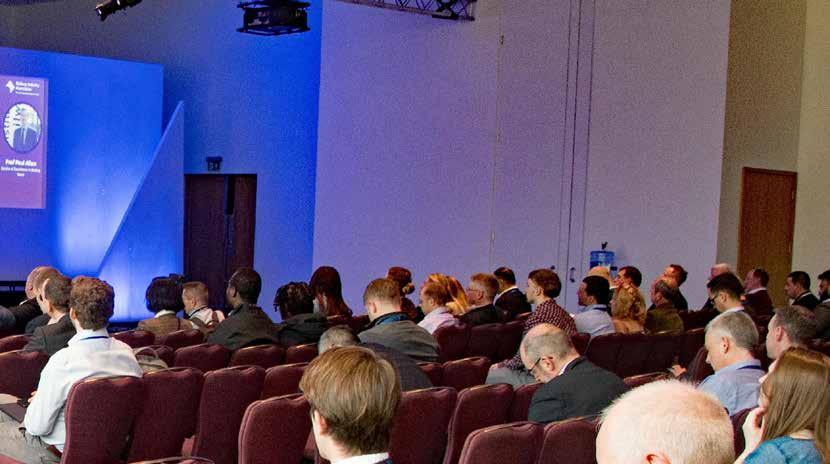
The South Wales Metro will be the first large scale use of battery powered EMUs on a discontinuous electrified network. This illustrates Transport for Wales’ (TfW) vision that innovation is key to achieving the vision of “a high-quality, safe, integrated, affordable and accessible transport network”. TfW’s chair, Scott Waddington explained how this vision is being delivered with initiatives such as TfW’s innovation lab. He was proud of the success of the pay-as-you-go fares on key routes across South East Wales which is the first place in the UK outside London to offer such fares.
Transport ticketing was also addressed by Uber’s new mobility lead, Rebecca Jeffrey. Uber was launched in 2012
and is now active in 71 countries. It recently booked its one billionth trip in the UK. Rebecca explained how Uber had recently expanded into various modes of transport including bikes, boats, and trains. She stressed that a sufficient reduction in carbon emissions will only be possible with electrification and modal shift to public transport. Uber promotes its train ride offering by encouraging its customers to “split their ride with 200 people”. It offers 10% cashback on all train tickets booked on Uber.



Rail Engineer | Issue 208 | May-Jun 2024 45 FEATURE

DATA ANALYTICS
Dave Looney, head of product strategy at Telent explained how the company’s Management Integration & Control of Assets (MICA) had been enhanced by teaming up with data analytics specialists Purple Transform whose data analytics insights platform, SiYtE, provides improved threat detection from trespassers and suicide prevention from the detection of abnormal behaviours of individuals in crowds. He also explained how SiYtE can analyse sensors that detect vibrations and cliff face movements to issue real-time alerts when there is a real risk of a line blockage.

The weather forecasts produced by the Met Office require 215 billion observations per day which, when analysed to produce simulations and predictions, produces 1,818 terabytes of data. The Met Office is clearly a big data organisation. Its co-director for Joint Centre for Excellence in Environmental Intelligence (JCEEI), Rachel McInnes, explained how artificial intelligence is improving weather forecasting and how it can help the railway industry manage climate resilience.
She advised that the Met Office’s specific rail industry expertise contributed to the Carmont weather task force. She also explained how the JCEEI was pioneering how AI can be used to process environmental data and knowledge to pioneer the development of environmental intelligence research.

The 3,035km railway network in Holland is a fifth of that in the UK, yet this dense intertwined network carries 1.45 million passengers per day which is half that of the UK. Dutch rail infrastructure is managed by ProRail whose senior program manager for research, Arjen Zoeteman, outlined the challenges it faced with the growth of mobility, new technology, sustainability, and scarcity of resources which were the same faced by Network Rail.
Arjen’s presentation emphasised the importance of collaboration between railway administrations to accelerate the implementation of innovation. As an example, a Memorandum of Understanding was signed in August between ProRail and Network Rail to jointly develop acoustic monitoring using fibre optic cables and other technological improvements.
TECHTALKS
In a change of pace, there followed a series of short presentations on specific products and initiatives. Chris Clements, ABB’s sales & marketing manager, highlighted the benefits of his company’s electrification installation products and the technical support and training that it offers.
Scott Heath, innovation manager at Thales, considered the challenges of effectively using data and focused on the use of video analytics to understand behaviour of those in crowds to determine potential risks. Using data was also the theme of the presentation by Richard Homheinz, a senior consultant engineer from Capgemini who stressed the need to unify data silos and use AI to extract data to derive metrics and dashboards.
The importance of cybersecurity was stressed by Evan Jones, chief executive officer, Complete Cyber. His company offers a portable scanner, Vault IOT, that provides a comprehensive cyber security health check of all digital assets.
The digital hub for rail projects used on the Welsh Core Valley lines and the Transpennine Route Upgrade was described by Helix director, Matthew Marsland. This uses design and real-time construction data to manage project workbanks and material supply to produce shift reports, quality check sheets, progress maps, and dashboards.
BENCHMARKING PROJECTS
Network Rail’s Rail Investment Centre of Excellence (RICoE) was founded to support the implementation of the Project SPEED initiative in 2021. One of its key roles is project cost benchmarking. A joint presentation by Charlie Fuller, RICoE’s head of benchmarking and Arcadis Business Advisory’s Susan McGuerty described the BenchSmart system which, as Charlie advised, is the result of a cost intelligence programme set up three years ago. It has been developed to capture costs in a consistent manner across all Network Rail’s five devolved regions and now has data on over 500 projects with 400 trained users. It now offers a better understanding of project cost drivers, including the split between direct and indirect costs.
PHOTO: PRORAIL
Rail Engineer | Issue 208 | May-Jun 2024 46 FEATURE

The system has dashboards showing summary and detailed cost data. It also offers project element cost comparisons, for example different footbridge costs of the Access for All projects. In this way BenchSmart offers increased data accessibility and accuracy, greater insights and better information for industry stakeholders including the DfT.
DESTINATION REVENUE GROWTH
Opening the second day of the conference, RIA’s innovation director, Milda Manomaityte, advised that RIA’s mission is to ensure that the views of its membership are heard. To do so RIA must understand the issues and promote solutions. For this reason, it has become a tradition over the last three years for RIA to publish a report at its innovation conference.
2022 saw a report on the need for a railway innovation strategy whilst a report on data and digital technologies in rail was published last year. This year’s conference launched RIA’s report ‘Destination Revenue Growth’ which provides a blueprint to enhance the railway’s ticketing and retail offer. This takes as its starting point a Williams Shapps report commitment that: “We will make the railways
easier to use. We will simplify the confusing mass of tickets and introduce far more convenient ways to pay.” It details the issues with railway ticketing systems and has four asks:
1. A stable national vision of a future of rail retail policy.
2. Standardised and specified interfaces to facilitate the adoption of account-based ticketing and ensure interoperability between different regions and modes.
3. A level playing field and culture of data sharing.
4. Common contractual frameworks for secure, efficient exchanges of operational data between transport operators with uniform models of revenue distribution and compensation.
The report notes that almost every single RIA document in recent years has included a plea for visibility of the Government’s strategic vision and the plans to deliver that vision.

PHOTO: RAILWAY INDUSTRY ASSOCIATION
Charlie Fuller and Susan McGuerty describing the BenchSmart system
Rail Engineer | Issue 208 | May-Jun 2024 47 FEATURE
Day two of the conference offered insights from outside the rail sector. The Department for Business and Trade’s National Digital Twin Programme aims to develop the standards, frameworks, and guidelines for UK digital twin technology. Its head of programme, Alexandra Luck, explained how better sharing of digital information required the right information to be available at the right time to the right people.
The programme aims to have digital twins that are realistically deployable and useable by all organisations with low barriers to adoption. She described a digital twin demonstrator for asset resilience, emergency planning and response for the Isle of Wight for which key stakeholders were the Council, NHS trust, and the emergency services.

Production of this digital twin required the identification and cleansing of data sources, integration architecture, and an app with the required visualisation. Recent severe floods on the island proved the usefulness of this model though it also highlighted deficiencies as it took five hours to locate all the vulnerable people on the island.
National Highways (NH) is responsible for over 22,000km of roads in England which is comparable to that of Network Rail’s rail network. In her presentation, NH’s roads development director, Dr Joanna White, explained how NH faces the same issues as Network Rail and has an innovation strategy with similar key themes: net zero carbon by 2050; connected journeys by 2025; cheaper, faster construction by 2030; and zero harm by 2040.


NH aims to half the number of serious incidents for its roadworkers by 2025 and, by 2040, eliminate human involvement in asset monitoring and inspection with the use of drones and climbing robots. Between 2020 and 2025, NH will have invested £200 million in innovation and £40 million in R&D. Joanna emphasised the need for collaboration between sectors and referred to NH’s partnership with Network Rail which includes the joint use of helicopters to monitor the country’s rail and road networks. Another transferable technology is NH’s use of cosmic rays, or muon imaging to detect redundant railway tunnel voids.
The DfT’s National Security Science and Research (NSSR) programme is the UK Government’s technical authority for transport security and resilience. Its deputy director, Tom Salter and PA Consulting’s transport innovation lead, Dr Steven Carden, gave an overview of this work. The programme aims to understand threats and their impacts, mitigate priority risks, and support incident response.
For rail, a key challenge is improving security without constraining high throughput. The solution is to encourage the general public to spot suspicious behaviour. This resulted in the DfT working with British Transport Police to implement the ‘See it, Say it, Sorted’ campaign.
NSSR is currently developing a four-year flexible framework agreement for the delivery of R&D projects to support its work. Tom felt that this required the right culture as the best value comes from both parties approaching it intelligently and transparently and that “humility brings out the best of the supply chain”.
LEARNING FROM OTHERS
Screenshot of Isle of Wight digital twin showing vulnerable assets
PHOTO: NATIONAL DIGITAL TWIN PHOTO: NATIONAL HIGHWAYS
National Highway’s network
Rail Engineer | Issue 208 | May-Jun 2024 48 FEATURE
L to R: Joel Smethurst, Paul Allen, Paul Plummer and Joanna Binstead

UKRRIN
A panel from the UK Rail Research and Innovation Network Panel (UKRRIN), chaired by Joanna Binstead of Siemens Mobility, answered questions on their work. This panel consisted of Professor Paul Allen of the Centre of Excellence in Rolling Stock at the University of Huddersfield, Professor Paul Plummer of the Centre of Excellence in Digital Systems at the University of Birmingham, and Dr Joel Smethurst of the Centre of Excellence in Infrastructure at the University of Southampton.
The wide ranging discussion covered the work being done to help Network Rail deliver its CP7 commitments within the available budget. It was felt that this needed better use of data as well as some quite fundamental work to understand earthworks deterioration.
There was also a plea for both human centric and system thinking for which collaboration was important.
It was felt that one of UKKRIN’s strengths was collaboration between different universities. An example of this is how the Universities of Bristol and Huddersfield are collaborating in the development of inerters for railway suspensions. This is a type of damper in which force is proportional to acceleration.
When closing the discussion, Joanna asked panel members for a single takeaway. Paul Plumber felt that the technologies on display were truly inspiring and that more would be attracted to the rail industry if they knew about these innovations. Paul Allen was
inspired by the expertise in the room and urged conference attendees to make use of the Rail Data Marketplace. Joel Smethurst considered that the key issue highlighted by the conference was making the best use of data and AI.
ARTIFICIAL INTELLIGENCE
With AI being a topic discussed throughout the conference, it was appropriate that the conference’s final presentation was by IBM Technology’s principal solution architect, Sven Strassburg, on the new paradigm of AI. His presentation considered the respective benefits of traditional AI models which undertake specific tasks and massive foundation multi-tasking AI models which generate sequences of related data.

Sven believed that AI should: use the best available open technologies; be trusted to offer security and data protection; be targeted for specific business needs; and provide a platform that can run anywhere designed for scale and widespread adoption. He felt that AI could support compliance with increasing regulatory demands in respect of governance, transparency, and ethics.
His presentation considered how AI can manipulate text to create a Q&A resource from a broad knowledge base, summarise text to capture key points, generate content for a specific task, or classify written input. AI-supported computer vision can also rank defects and track changes over time to automate maintenance tasks.

Rail Engineer | Issue 208 | May-Jun 2024 49 FEATURE
PHOTO: RAILWAY INDUSTRY ASSOCIATION


STANDS AND SPOTLIGHTS
Over 50 stands in the main exhibition hall and 11 in the Future Focus Zone showcased the available new technologies. To make the conference a more interactive event, much of the programme was devoted to 25 10-minute spotlight presentations by exhibitors at their stands. What follows is a brief overview of the impressive capabilities on display.
In the Future Focus Zone, it was not possible to avoid the robots and it was interesting to speculate whether robotic dogs might soon be in widespread use. The UK Atomic Energy Authority stand showed how they have eliminated the need for humans to enter hazardous environments. As such robots become less expensive, will it be long before they are used to inspect railway infrastructure that is difficult to access?
Yet as a reminder that railways are about moving heavy vehicles at high speeds, much on display in this zone concerned mechanical and civil engineering. The University of Sheffield’s Advanced Manufacturing Research Centre’s stand included components produced by a variety of advanced techniques including additive manufacturing which can produce complex shapes with minimal waste. The University of Southampton’s stand featured
steel-free fibre reinforced polymer bridge beams which are 80% lighter than concrete. Its stand also featured research into the use of optical fibres in which there were laser-created reflectors every 10cm that enable the fibre to have thousands of highly sensitive strain gauges along its length.
The University of Huddersfield’s Institute of Railway Research had information about its test rigs which are used to study the dynamics of wheel/rail and pantograph/OLE interaction. A spotlight presentation also explained its collaboration with the University of Bristol, Bracknell Willis, and Network Rail to develop an inerter-based pantograph.

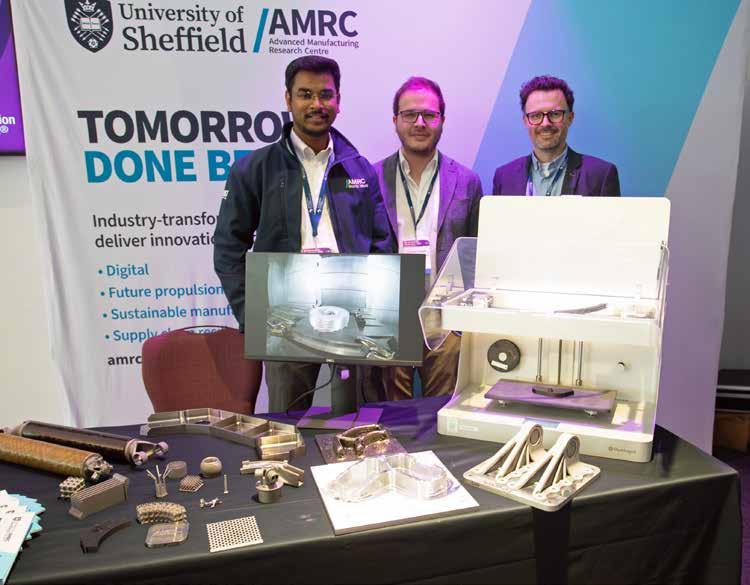 Advanced materials at the University of Sheffield’s stand
Advanced materials at the University of Sheffield’s stand
Rail Engineer | Issue 208 | May-Jun 2024 50 FEATURE
The University of Bristol’s Jeffrey Jung with an inerter
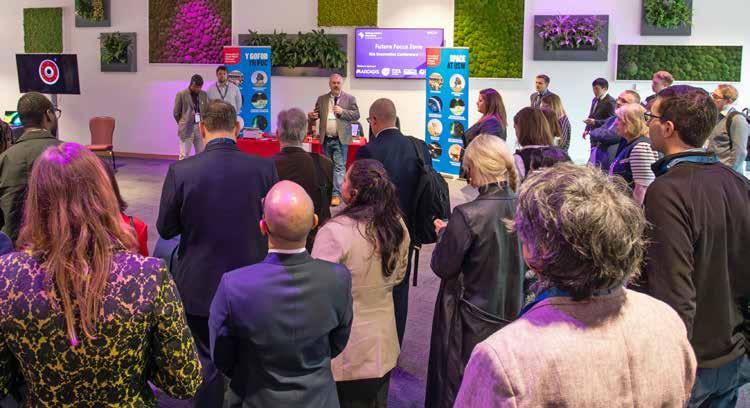
In the main exhibition hall Network Rail’s stand had information about its international R&D collaborations and RSSB had much information about its research programmes including freight on which there is to be a greater focus in the 2024 update of the Rail Technical Strategy.
TfW’s stand featured those who had benefited from its innovation lab including Briteyellow which has developed a virtual reality wayfinding app to help passengers navigate complex stations and Dopee Doo’s reward scheme which encourages people to explore by train.
One of the most entertaining spotlight pitches was by ‘Wreck it Roy’ and ‘Potential Pete’ which illustrated the need for COMET incident root cause analysis software. Another safety product on display was Tended’s wearable geofencing technology which offers centimetre accuracy to prevent workforce strayed


out of safe zones and can also ensure the accurate placement of marker boards.
Given the importance of sharing data, the Rail Data Marketplace (RDM) stand offered delegates an opportunity to learn how it brings data publishers and consumers together with data sharing agreements. The RDM portal went live in September and now has over 700 users, 103 data products, and has facilitated 1,700 data sharing agreements. As is always the case at such events, there is always much to learn from chance conversations. For example, it was interesting to learn of a novel use of AI to keep deer off the tracks between Peterborough and Grantham, as LNER’s automated deer deterrent system uses sound and vision sensors to detect deer approaching the track and then activates audible and visual alarms until the deer has moved a safe distance away.

There is always much to learn at RIA’s innovation conference both from those outside and within the industry. Understanding the latest developments and finding out what is available through the conference programme, the exhibition stands, or chance conversations must help with the implementation of new ideas. Indeed, it is safe to say that those present were ‘inspired by innovation’. For this, RIA is to be commended for yet another successful innovation conference.


RIA’s 2025 innovation conference returns to the ICC Wales at Newport on 25-26 March 2025.








TBF - Here to help and support YOU during times of need A wide range of benefits for you, your live-in partner and dependent children for less than 20p per day . Registered charity: England and Wales 1160901, Scotland, SC047016 JOIN ONLINE TODAY www.tbf.org.uk TBF24_Advert_185x50.indd 1 01/03/2024 07:23
Spotlight presentation at the TfW stand
RAILWAY INDUSTRY ASSOCIATION
PHOTO:
Rail Engineer | Issue 208 | May-Jun 2024 51 FEATURE
‘Wreck it Roy’ and ‘Potential Pete’
Researchadding value in rail freight




The Retired Railway Officers Society was founded in 1901. One of its aims is to provide an opportunity to maintain the ongoing friendships and contacts of people retired from senior positions in the rail industry. Due to the extensive experience of its audience, the Society is able to attract a high calibre of speaker, and this was the case recently when Robert Staunton and Aaron Rostron-Barrett from the Rail Safety and Standards Board (RSSB) presented ‘Research adding value in rail freight’.
RSSB is an independent company limited by guarantee and its primary purpose is to bring about improved health and safety performance throughout Britain’s railway network. RSSB has four main areas of activity to support the rail industry. These are research, safety, Standards, and sustainability.
RSSB RESEARCH
Evidence-based changes to Standards and the development of new and improved safety risk tools underpins RSSB’s research programme. Its research activity also helps the industry with key challenges that cannot be tackled in isolation and need whole-system and long-term thinking. The research is funded by the Department of Transport (DfT) (£7.5-£10 million per annum) and is organised as a tripartite agreement between RSSB, the DfT, and the rail organisations.
The RSSB research team looks into future developments and sometimes makes the first steps in exploiting new technologies into the rail industry. It looks at ways of removing barriers in operations, revaluating the safety risk, and understanding the costs and benefits of any change. RSSB’s research is focussed on high impact topics, which may also have high uncertainty, with low risk changes the responsibility of the rail organisations. RSSB doesn’t do the most profitable or most immediate research / business improvement - that’s for the rail organisations. They often look at problems that many stakeholders in the industry have, but are too big for one organisation. These may be complex problems and the effort to resolve the issue and to realise the benefits don’t lie in the same place. This is the case with rail freight.

 PAUL DARLINGTON
PAUL DARLINGTON
Rail Engineer | Issue 208 | May-Jun 2024 52 FEATURE
Currently, rail freight contributes £2.45 billion to the UK economy each year and is growing and evolving. Businesses are making the switch from road (and air) to rail to keep their supply chains moving forward, sustainably, and efficiently. Rail freight is greener than other forms of transport and its contribution to net zero will increase. A tonne of freight moved by rail produces around a quarter of the carbon emissions compared to it being moved by road, and a single freight train can replace up to a mile of lorries from the roads, which is equivalent to around 1 billion fewer Heavy Good Vehicles (HGV) miles every year. On land, rail is the most sustainable option for long distance, ‘heavy lifting’, while lorries and vans, ideally electric vehicles, are best placed to cover the ‘last mile’. Although there is currently some negativity to electric vehicles, they can easily cover the last 10 or 20 miles or more.
The government has set a target for rail freight growth of at least 75% by 2050 to deliver more benefits to the country. Many believe this target should be bigger and call for robust plans to be put in place to achieve this target. From food to supermarkets, to building materials for construction and to removing waste, rail freight is a vital part of the transport system, and it impacts all our lives. Ninety percent of rail freight benefits are realised outside London and the South East. It is therefore crucial to achieving a growing economy and creating opportunities right across the country.
CHALLENGES
There are many challenges in the freight business. These include clearing routes for freight operation and dealing with heavy loads and the transport of dangerous goods. There have been some significant accidents relating to dangerous goods in Canada and North America. An incident in East Palestine, Ohio, resulted in a chemical spillage with danger to residents, and in Lac-Megantic, Quebec, 47 people were killed when the handbrakes on a freight train were left off and the train rolled back down a hill into the town.



But to achieve national decarbonisation targets and achieve net-zero there must be more investment in rail freight. The government is backing the shift of freight from road to rail and offering funding for businesses to make the switch through Mode Shift grants. This is a good start, but more innovation is required.
RSSB monitors incidents across the world and publishes a monthly review of lessons and learning for the industry. In Wales, an incident at Llangennech in 2020 resulted in a wheel flat which eventually derailed the train. Oil spillage created significant pollution in an area of special scientific interest, and it cost £37 million to clear up. Freight on the GB railway is generally safe and freight incidents are rare, accounting for only 2% of the fatality weighted industry risk. However, rare is not the same as never, and 38% of all potentially higher-risk accident events recorded over the past five years have involved freight trains or freight operators.
The main risk areas are derailment (40%), workforce personal injury (20%), train collision (12%), and level crossing incidents (12%). Freight trains have an overall lower number of Signals Passed At Danger (SPADs) compared to passenger trains, but a tool developed by RSSB which normalises freight trains by the number of red aspect signals they face, has revealed that normalised freight train SPADs are nearly three times higher than passenger trains. The tool is now available for operators to use to understand and mitigate their risks.
PHOTO: ISTOCKPHOTO.COM/TEAMJACKSON
Rail Engineer | Issue 208 | May-Jun 2024 53 FEATURE

FREIGHT TRAIN PAYLOADS
RSSB has a portfolio of research projects which will help the freight industry to grow and become more efficient. As an example, Aaron described a project to increase the maximum allowable freight train payloads. The trailing load limit is defined by the coupler strength, the tractive effort of the loco, and the ability to meet the timetable.
The freight train loading tables, derived from the British Rail days, have not been updated since the introduction of the Class 66 loco around 25 years ago. On the GB rail network, there are three types of screw couplers with ratings of 23 tonnes, 34.5 tonnes, and 56 tonnes. There are two factors of safety: proof strength and braking strength. RSSB research has identified that the two factors are each applied in a different way. With analysis, these were able to be consolidated and resulted in an increase of 13% in allowable trailing load for a 56-tonne coupler, and 16% for a 34.5-tonne
Applying this research to real world case studies saves operators thousands of pounds in efficiencies per freight flow and brings significant environment and social benefits. Three examples are:
» Moving intermodal freight on the East Coast via Harringay. Train lengths can be extended by 14% (2 wagons) providing operating cost savings of £245,000 annually as well as a 1.4-tonne reduction in CO2, 8kg reduction in NOx, and 171g reduction in particulates.
» Moving jet fuel to Heathrow airport. Train lengths can be extended by 12.5% (3 wagons) providing operating cost savings of £291,000 annually as well as a 0.25-tonne reduction in CO2, 2kg reduction in NOx, and 15g reduction in particulates.
» Moving intermodal freight on the West Coast Mainline via Beattock. Train lengths can be extended by 21% (4 wagons) providing operating cost savings of £364,000 annually as well
Freightliner has also used the tool to run longer trains of bulk aggregates out of Tunstead in Derbyshire.
The old trailing load calculations assumed that the gradient on a route was the most pessimistic possible. RSSB has developed a tool to calculate trailing load limits based on actual gradients. As an example, the tool identified that five extra wagons could be hauled over the Haringey Junction route with no change to the infrastructure, compared to the previous Standard. In the short term, interim advice has been issued to the industry, and Network Rail is making Specific Loads Book modifications. Longer term, the Standards will be revised and incorporated into a digitised Loads Book. Freightliner is already using this tool to run significantly longer trains and saving between £245,000 and £346,000 annually per freight flow.
A further RSSB project relates to axle bearing monitoring, using acoustic signature rather than temperature. The study looked at trackside fitments,

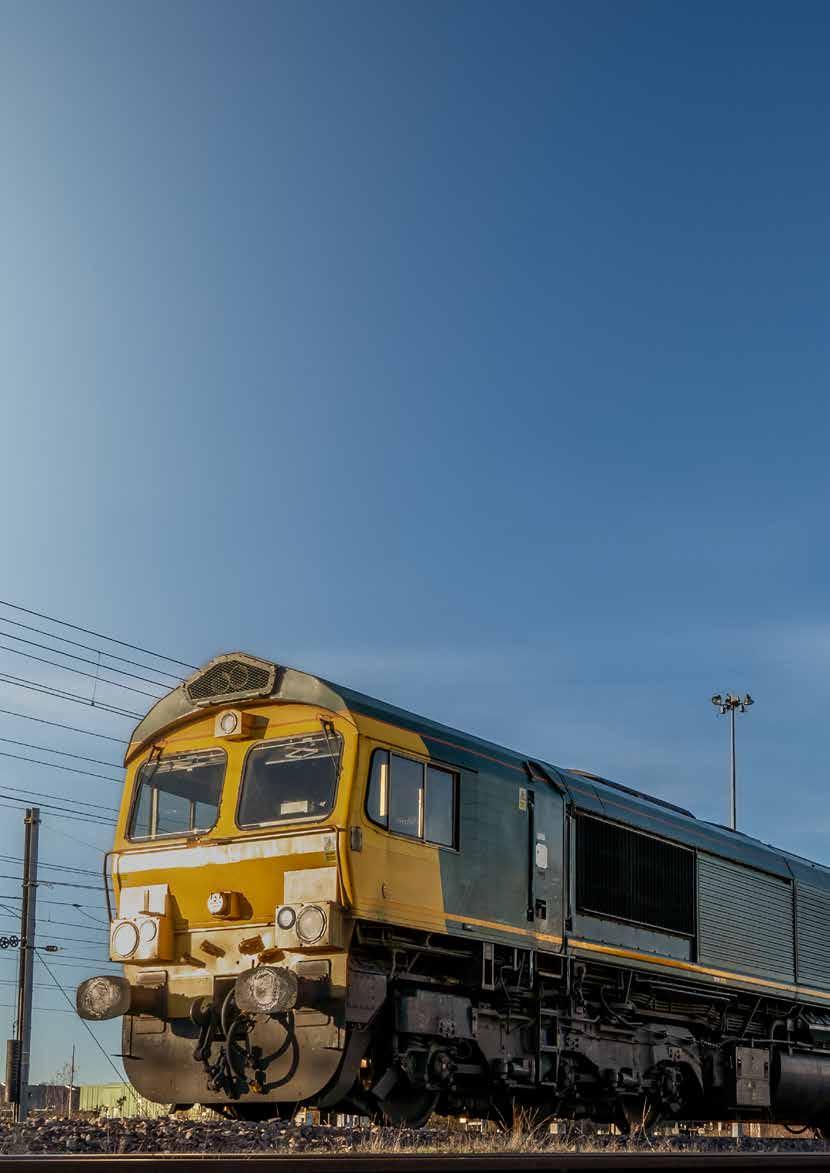
PHOTO: ISTOCKPHOTO.COM/TEAMJACKSON Rail Engineer | Issue 208 | May-Jun 2024 FEATURE 54
SMART WAGONS
Digital Auto-Couplers (DAC) have two core primary functions: (i) to enable wagons to couple together without human interaction; and (ii) to enable the provision of power and data down the train to provide ‘smart’ wagons. Above the coupler is a connecting box, the cover of which rotates out of the way when the wagons are coupled together enabling a secure connection. Conduit is provided through the wagon from one coupler to the next to provide electrical continuity down the train.
On the wagon there are power and data nodes which enable instrumentation to be placed. This instrumentation is not part of the core DAC fitment but produces many potential ‘enabled benefits’ such as load and vibration monitoring. Implementation would require modification to 900 locos and shunters, 13,600 wagons, and the procurement of 20,000 DACs. The benefits were around £26 million per annum and were mostly enabled benefits such as wheelslide protection and remote condition monitoring to reduce service failures and derailment risk.
is iWagon, which Rail Engineer covered in Issue 206 (Jan/Feb 2024). This extracts energy from the freight wagon wheel rotation to power diagnostic systems and overcoming the lack of a power feed on a freight train. The VTG Rail JPA tank wagons are the first three wagons to be fitted which have been modified at Tarmac’s Maintenance Depot at Dunbar in Scotland. Further wagons for trial fitment will be deployed on the Hanson and Mendip Rail fleets.
FURTHER INNOVATION
Other innovation projects include assessing the aerodynamic risk in increasing average and maximum speeds of freight trains, to allow less speed differential with passenger trains and avoid slower freight trains holding up passenger trains. This initiative has the potential to help everyone in rail with better service reliability, faster freight journey times, and avoids the need for as many expensive passing loops.
A tool to predict future route access for heavy axle weight trains involves identifying the locations on the network where withdrawal
are not subsidised, and freight transport is very competitive. Identifying who funds freight enhancements, which could benefit everyone in rail, is not always straightforward.
RSSB tracks and monitors the implementation of its research projects, taking a role in facilitating their introduction using project management techniques. Over the last 10 years, 58% of the research work has been significant, with 19% of the significant work fully implemented.
The research funding expectation for Control Period 7 is £50 million, along with £165 million for Network Rail’s R&D activity, but this is a small fraction of the £1.2 billion total spend on developing and implementing technology. By adopting a whole system optimisation approach, RSSB is delivering value for freight in projects relating to safety, efficient operation, and growth. Its focus on implementation has increased take-up and provides a good return for the industry from the funding available.
All of RSSB’s research is available free to access via its website:


Of necessity this presentation was unable to cover the full portfolio of RSSB research projects. Those not addressed in this feature will be the subject of a feature in the next issue.
With thanks to the Retired Railway Officers Society and RSSB for their help with this article.


Rail Engineer | Issue 208 | May-Jun 2024 FEATURE 55
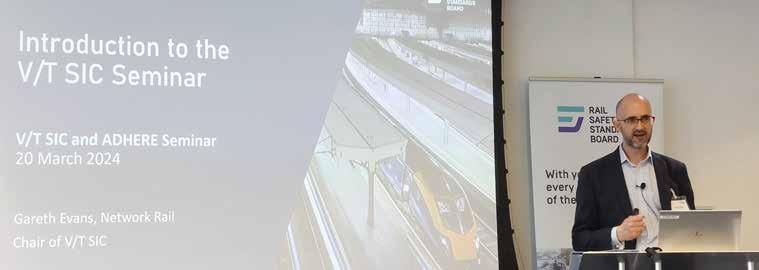


RADHERE & V/T SIC: Wheel/Rail Interface and Adhesion
ail Engineer has been reporting on the activities of the Vehicle/Track System Interface Committee (V/T SIC) and the Adhesion Research Group (ARG) for many years. V/T SIC is a cross-industry body under the umbrella of the RSSB which aims to improve knowledge of, and recommend actions to improve, this vital interface. It was created following the derailment at Hatfield in October 2000 when a rail broke into many pieces caused by rolling contact fatigue.
The railway industry had realised it needed to understand this and other issues caused by train wheels running on the track. At the time, rail breaks were running at a rate of over 1,000 per year. Since then, great strides have been made but, as illustrated in this and accompanying articles, work remains and issues that were thought to be resolved, have reemerged.
A particular wheel rail interface issue - adhesion - has been an issue since the earliest days of steel wheels on steel rails. The added factor of leaves on lines, subject to much ridicule in the popular press, but a safety risk nonetheless, seems to have become more serious since the end of steam and the introduction of mostly disc braked trains. Additionally, the objective of achieving a generally good ride seems to have made the situation
worse. In the 1990s the Adhesion Working Group was established, and one of its successors, ARG, manages the ADHERE research programme and is a sub-group of V/T SIC.
Each year, their research and other investigations are presented to the industry. In recent years the seminars have been virtual or hybrid, but for 2024 the seminar was in person only, a move that was welcomed by both speakers and the 100 or so people who attended the day at RSSB’s offices in London. Product demonstrations and networking were much in evidence.
Presentations were a good mixture of research and updates on current issues, some covered here and others in their own articles.


 MALCOLM DOBELL
MALCOLM DOBELL
PHOTO: PROFESSOR JASON ZHENG Network Rail’s Gareth Evans introducing 2024 V/T SIC seminar Prototype hydro bush testing Rail Engineer | Issue 208 | May-Jun 2024 56 FEATURE
PHOTO: MALCOLM DOBELL


TRAILING ARM BUSHES
Professor Jason Zheng Jiang from the University of Bristol and Dr. Heiko Müller from Gummi-Metall-Technik GmbH (GMT), presented their work on producing an improved trailing arm bush (see Trailing Arm Suspension above). This is a four-way collaboration between the University of Cambridge, University of Bristol, University of Huddersfield, and GMT, a supplier of railway trailing arm bushes.
The goal of the project is to construct a novel trailing arm hydro bush device and experimentally demonstrate its performance advantages over the current hydro bush for the Mark 4 coach. Although the work focusses on the Mark 4 coach, the developed technology will be widely applicable.
The prototype, the design details of which are confidential, has shown some very promising results during laboratory tests. It has delivered a 20% reduction in longitudinal static stiffness compared with GMT’s current design and 28% compared with the Mark 4 current design, delivering a modelled reduction in simulated track damage for larger radius curves (e.g., 1,200 metres) without harming forecast passenger comfort and stability, compared with the standard GMT bush. Lab-based accelerated life testing has also demonstrated adequate fatigue life of the bush comparable with the products already in use. Currently, preparations are being made to fit the new design to a Mark 4 bogie which has arrived at Huddersfield so that it can be tested on the University’s fullscale HAROLD rig.
TRAILING ARM PRIMARY SUSPENSION
This design of suspension is used on many of today’s trains. The principal components are shown on the adjacent diagram.
The trailing arm bush is, in principle, concentric rings of steel with flexible rubber material bonded to the two rings. A feature of such a bush is that it can allow the wheelsets to steer slightly, the amount depending on the stiffness of the bush. The measure of this is known as Primary Yaw Stiffness (PYS). It needs to be stiff at high speed to allow for a good ride, but less stiff when curving at relatively low speeds. A simple rubber bush cannot deliver both.
Some years ago, an improvement to the track friendliness of South Western Trains (Now South Western Railway) classes 444 and 450 units, caused by high PYS, was made by fitting a hydraulic radial arm bush known as a Hall or hydro bush. These worked like a longitudinal hydraulic damper, where high frequency longitudinal vibrations delivered a high PYS bush, whilst at lower frequencies, it would allow more longitudinal movement allowing steering, i.e., lower PYS. In more formal language, a hydraulic damper is a two-terminal device in which the forces applied at the terminals are equal, opposite, and proportional to relative velocity between the nodes.
Get the PYS right and the stability of the vehicle and hence the passengers’ ride experience will be good. Get it wrong and a reduced PYS can contribute to lateral instability or rail damage on curves.

A further design iteration is under way making use of the inerter principle originally developed at the University of Cambridge. An inerter is a twoterminal device in which the forces applied at the terminals are equal, opposite, and proportional to relative acceleration between the nodes unlike a conventional hydraulic damper where the forces are proportional to relative velocity. It is intended that the bush will incorporate inertance in the longitudinal and lateral planes.
The candidate design is forecast to deliver a 90% reduction in longitudinal static stiffness compared with the current design and is predicted to deliver much lower damage in 200-metre-radius curves and even lower damage on 1,200-metre curves than mentioned above. Passenger comfort is maintained at all speeds operated by Mark 4. The next step is to realise the outline design in hardware.

PHOTO: PROFESSOR JASON ZHENG
JASON ZHENG
PHOTO: PROFESSOR
PHOTO: MALCOLM DOBELL
Siemens trailing arm primary suspension bogie, with the principal components labelled
Rail Engineer | Issue 208 | May-Jun 2024 57 FEATURE
Mark 4 coach bogie primary suspension indicating the location of the trailing arm bush
AXLE BEARINGS
A 10-car train will have at least 80 axle bearings, more if it has axle mounted final drives. Each one represents a single point critical safety failure risk. If the bearings are competently designed, lubricated, and kept free of foreign material, they are usually trouble free. That said, a single failed bearing can cause a major safety disaster. LNER’s Keith Mack who is chair of the RSSB sponsored Wheelset Management Group, and also chair of RAE/3/-/2 UK bearing group, presented its latest work. The group has representation from bearing manufacturers and overhaulers, lubricant OEMs, RSSB, passenger and freight operators, and Network Rail.
Keith explained that axle bearing failures in the UK remain low, but he emphasised the importance of proper investigation if one does fail. He referred to a failure on a class 390 in February 2021, and he commended Alstom’s investigation as best practice. Sometimes the damage caused by a failed bearing is so extensive that it is

WRONG SIDE TRACK CIRCUIT FAILURES
Autumn leaf fall is known to cause contamination of the railhead. A mixture of leaves, moisture, and rolling from wheels results in a black leaf layer. When the leaf film is wet, it is very slippery but, as it becomes dryer, it is an effective insulator leading to Wrong Side Track Circuit Failures (WSTCF). This is a significant safety risk and, before an assessment of comparative risk in the 2010s, the use of sand as an adhesion improver was restricted because of the perceived risk of sand insulating track circuits and causing WSTCFs. The comparative risk assessment showed that not stopping in time was a much higher risk than a WSTCF.
That said, the latter risk cannot be ignored and Dr Will Skipper from the University of Sheffield reported on ‘Understanding how Railhead and Wheel Contamination affects Track Circuit Performance’ (RSSB project T1222). Ten years of Network Rail WSTCF data
impossible to determine the root cause. In the 2021 incident, the root cause was contamination between the axle guide and the bearing on the outboard side during heavy overhaul.
To share this best practice, RSSB will be publishing Technical Note TN2315 dealing with evidence conservation of failed axle bearings in service, filling a gap that there is no industry recognised way of collecting evidence to learn from bearing failures, especially as priority is usually given to restoring the vehicle to operational service. It will set out a methodical approach to collecting data at the point of failure and preserve the failed bearings for further analysis to help prevent similar failures and it will support RIS-2709RST ‘Rail Industry Standard for the Identification of Roller Bearings Defects’ which contains criteria for assessing bearing condition.
Finally, Keith stressed the importance of storing bearings correctly so that they remain fully lubricated and outlined some changes to improve the clarity of RIS-2704-RST ‘Rail Industry Standard for Wheelsets Handling and Storage’ which applies to handling and storage of wheelsets and bearings.
was analysed showing where the incident happened, the type of track circuit and the cause (confirmed or inferred). Four main contamination causes were identified: leaf, rust, sand, and grease, with leaf the majority cause, bigger than the other categories added together. Incidents in October and November on DC track circuits were by far the largest individual entries. Further analysis showed that the overwhelming majority of track circuits saw no failures, and very few saw more than an average of one WSTCF every two years.
Laboratory tests were carried out to understand the effect of three different pressures of 8 tonnes, 12 tonnes, and 20 tonnes, using leaf, rust, and sand contaminants. The results for leaf contaminant showed that, for the lower loads, the test rig surfaces remained isolated for the majority of the tests, whereas there was some conductivity for the 20-tonne equivalent load. For sand, the 12-tonne and 20-tonne tests demonstrated conductivity whereas the 8-tonne load showed a range of voltages illustrating that the electrical resistance in the contact area changed through the test. Track tests were carried out on the Wensleydale Heritage Railway using a class 142 Pacer train. This is a two-car, two axles per car, circa 12.5 tonne axle load tare, i.e., the middle load from the laboratory tests. Genuine DC track circuit equipment was used. Tests were carried out using clean rail, a leaf layer, sand on clean rail, and sand on the leaf layer. For
the leaf test there was a spike in voltage when the first wheelset entered the contaminated area and a smaller spike when both axles of the leading axle were on the contamination (leaf powder mixed with water, spread on the rail, and rolled in with two train passes).
For sand, there was a large voltage spike during the first pass but much less persistent on the second pass. The combination of sand and leaf resulted in longer and larger voltage spikes than either of the previous tests, the worst of both worlds.
 Breakdown of WSTCF causes over a 10 year period
Breakdown of WSTCF causes over a 10 year period
PHOTO: DR WILL SKIPPER
Appearance of rails after contaminant was applied
DR WILL SKIPPER Rail Engineer | Issue 208 | May-Jun 2024 58 FEATURE
PHOTO:
Further analysis explained some of the ‘spikey’ traces. In reality, the electricity feeding DC track circuit is actually a rectified AC voltage for DC track circuits, unless operated by battery. This is only apparent when measuring with a high sample rate. These AC voltages are further affected by the inductance in the coil of the relay, creating negative sections to the signal. These behaviours were key for analysing the behaviour of the circuit when contamination was applied to the railhead. As the train enters the track circuit and the sander is activated, the electrical behaviour is different to a leaf contaminated contact. When viewed at high speed, as the sand is applied the ‘DC’ waveform is suddenly insulated leading sometimes to large peaks in voltage at the return voltage. This on/off type behaviour and the relay coil inductance in the relay causes the large increases in voltage - something that does not appear to be common knowledge within the signalling community.
As part of the track trials, images were taken by a drone operated by Network Rail at a height of over 50 metres above the track. These were of good enough quality to allow for the assessment of railhead contamination.
The study also examined WSTCF records on sample lines. The researchers sought to evaluate whether the results from the lab tests were reflected in service, especially as wheel-rail contact pressure was a very important factor in the laboratory. When analysing operations, load is easy to quantify but other factors, i.e., relating to contact area and position on rail, are harder to

assess as this depends on wheel/rail profiles and running band. The link between train weight and WSTCF was apparent in headcode data. Using traffic analysis and WSTCF results, Sheffield generated ‘heat maps’ illustrating the contribution of various factors on WSTCF risk: Traffic (frequency, type, mix}; track circuit type; rail head treatment train runs; and tree proximity.
For example, on the Bletchley to Bedford line (BBM), there was a mix of WSTCF causes that would need to be addressed, whereas on the line to Hull (HUL1) the analysis points to the dominant factor of track circuit vulnerability. Comprehensive information about this work is available on the RSSB’s website.


‘SPIKEY’ TRACES
intermittent electrical
contact WSTCF heat maps for six sample lines PHOTO: DR WILL SKIPPER PHOTO: DR WILL SKIPPER Rail Engineer | Issue 208 | May-Jun 2024 59 FEATURE
Voltage spikes on DC track circuits during
wheel/rail
ENZYME LEAF FALL TREATMENT
An article in Rail Engineer 202 (May/June 2023) described work by Dr Leonardo Gomez, University of York, and Professor Roger Lewis, University of Sheffield, exploring the use of enzymes as a natural way of dealing with leaf contamination. There was a reminder that enzymes are biological molecules made of protein and they are powerful catalysts that work under ambient conditions (no high temperatures and pressures).
Because each enzyme is specific to its task, the potential for unintended consequences is minimal, they are water soluble, and enzymes have been developed and are produced at a large scale for industrial applications (e.g., food manufacture) and can be highly cost-effective and robust. Tests in the laboratory continue to determine the most effective enzyme and to understand the effect on the leaf layers. Further climate chamber tests are planned to assess different enzymes in different conditions of humidity and temperature. Full scale rig tests are also planned to assess how enzymes promote leaf layer removal by the passage of wheels. This research is still in its early stages.
MACHINE LEARNING AND IMAGES
Last year’s article also reported on the work of Morinoye O. Folorunso from University of Sheffield to use on board forward and downward facing camera images together with machine learning to estimate rail adhesion. The principle was demonstrated last year and, since then, work has proceeded with implementing a web-based tool that can present adhesion risk based on users’ input images, learning about unusual contamination that the machine learning needs to be trained for (for example, mud on the track at a crossing) and further full scale tests.
The capture unit was further tested on a Scotrail class 158 train which had a different lamp bracket mounting point to that used previously, giving the team a slight issue with alignment. Despite that, over 6,500 data points were collected. Further data was collected at the Wensleydale Heritage Railway. Tests included applying leaves to the track which the system detected.
The estimated friction levels were validated using a rail mounted tribometer with good correlation. Professor Roger Lewis explained how the camera box approach can be used in conjunction with new (or existing) railhead cleaning technology. This might enable a reduction in the amount of cleaning consumables required. He also outlined how this technology could lead to near real time adhesion mapping. He outlined a vision of the near future where there is integration between meteorological and environmental models and adhesion estimating using data from service trains to inform drivers, and longer term planning by operators and maintainers.

With thanks to RSSB’s Ben Altman and speakers at the seminar for their assistance with this article.

PHOTO: MORINOYE O. FOLORUNSO
Intermittent leaf layers correctly identified by the system
Rail Engineer | Issue 208 | May-Jun 2024 60 FEATURE





















34th NATIONAL ANGLING CHAMPIONSHIPS 2024 For more details and an application form please contact: railsportgb@ntlworld.com or by post to: Cliff Robinson, 9 Knoll Close, Littleover, Derby, DE23 3SG. Telephone: 07757923902 Makin Fisheries Wednesday 14th August 2024 Wolvey, Leicestershire/ Warwickshire border Ready for a career in the mobility industry? More information at innotrans.de/en/campus Apply now – Pick up a job! Eurailpress Career Boost – only on 25 September, 2:00 p.m YOUR. FUTURE. eliminating the flange groove > barrier-free passing easy passage for cyclists at any angle flange groove free from snow and ice for train speeds up to max. 70 mph STRAIL (UK) Ltd. | Tannery Lane // Send / Woking // GU23 7EF // Great Britain Head Office +44 (14 83) 22 20 90 // info@strail.com @strail_official @kraiburg strail www.strail.com ELIMINATING THE FLANGE GROOVE LEVEL CROSSING SYSTEMS Rail Engineer | Issue 208 | May-Jun 2024 61 FEATURE
ADHERE & V/T SIC:
Poor ride - what to do?


Rail Engineer has reported on poor ride from some fleets on the main line several times, as have other commentators. Unfortunately for the people who might investigate, reports of “rough ride” is rather unspecific. That said, at a recent seminar featuring the work carried out under the auspices of the Vehicle/Track System Interface Committee, Dr Mark Burstow, Network Rail’s Vehicle Track Dynamics Engineer, rose to the challenge. He discussed an investigation about poor ride on several fleets at specific locations.
These included:
» Midland Main Line (South of Bedford).
» West Coast Main Line (Winsford/Acton Bridge).
» Great Western (Didcot-Swindon area).

» East Coast Main Line (Currently under investigation).
Mark said the reports were initially described as ‘rough rides’, but he explained that, in reality, they were ‘hunting’. Technically, hunting is a well understood problem with known causes, but ‘rough ride’ is more vague description which can refer to a number of different issues. It seems that, across the industry, hunting is not as well understood as it used to be and many see it as a ‘track’ problem because it occurs at specific locations, although it tends to affect only some vehicles on a route. In reality it is a true vehicle/track interface problem.

Although the cause of hunting - high equivalent conicity - is known, investigating the phenomenon is complex. It requires co-operation between the infrastructure manager, the vehicle operator and, where different, the vehicle maintainer. It is necessary to carry out site visits to take detailed measurements of wheels, rails, and other track features such as gauge and cant. The automated systems for measuring wheel profiles from trackside and rail profiles from trains are not yet proven to be accurate enough for this process.
“After measuring a train’s worth of wheel profiles or 100 metres of rail profiles, anyone can become an expert in using a Miniprof,” said Mark.
Whilst measurement train results for gauge and cant are generally accurate, these are also measured by hand and correlated well with the automated measurements. Once the data has been acquired it is processed using specialist software.
 MALCOLM DOBELL
MALCOLM DOBELL
ALL PHOTOS: NETWORK RAIL Rail Engineer | Issue 208 | May-Jun 2024 62 FEATURE
Lateral acceleration for two different vehicles on the same track section: the red line shows a vehicle prone to hunting
ANALYSIS
Analysis showed that hunting was occurring on straight sections of track. In these locations the track gauge was tighter than 1,435mm but well within specified maintenance limits although it was noted that for many years the nominal gauge was 1,432mm and some track installed to this value may still be in service. Measured rail profiles showed no obvious issues and were well within allowable wear limits.
Equally, wheel profiles were well within limits set out in GMRT2466 ‘Railway Wheelsets’ and there had been no flange wear even on wheels that had run for over 300,000km.
But when wheel and rail were put together, there was a general trend that higher mileage wheels took equivalent conicity above the usual limit of 0.5. tight gauge and the absence of flange wear leading to slight tread hollowing were significant factors.
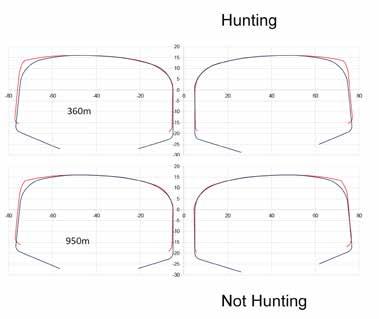



 Sample measured rail profiles
Sample measured wheel profiles
Sample measured rail profiles
Sample measured wheel profiles
Rail Engineer | Issue 208 | May-Jun 2024 63 FEATURE
Equivalent conicity values linked to slightly tighter than standard track gauge and wheel mileage since last reprofiling. In all cases, measurements within limits
The National Technical Specification Notice (NTSN), the UK version of EU Technical Specification for Interoperability for Rolling Stock – Locomotive and Passenger is clear that (summarising):
» The combined (i.e., vehicle and track) equivalent conicity for which the vehicle is designed shall be specified for in service conditions in maintenance documentation taking account of the contributions of wheel and rail profiles.
» If instability is reported the operator and the infrastructure manager shall identify the locations affected in a joint investigation.
» The operator shall measure the wheel profiles of the wheelsets in question and calculate the equivalent conicity using a reference rail profile to check if this value is withing the set limits. If not, the wheel profile has to be corrected.
» If the wheelset conicity is within limits (despite hunting), then a joint investigation by the operator and infrastructure manager shall be undertaken to understand the reasons for the instability.
» A similar procedure is specified in the Infrastructure NTSN, using measured rail profiles and reference wheel profiles.
As is often the case when dealing with wheel rail interface issues, delivering the NTSN requirements is easier said than done for a number of reasons. Firstly, calculating equivalent conicity using techniques in EN15302 ‘Railway applications - Wheel-rail contact geometry parameters - Definitions and methods for evaluation’ (referenced in the NTSN) is not simple and unsuitable for day-today management and monitoring.
Secondly, the requirement is to check wheel profiles against a reference rail profile (and vice versa for rail profiles). Thirdly, when making those comparisons, the results often show that all is well. It is the combination that is troublesome.
Mark referred to previous research into a technique for estimating equivalent conicity using measurements that are

relatively easy to collect. This work sought to identify features in profiles that increase equivalent conicity. The researchers had proposed to measure wheel flange thickness at 3mm above the tread datum (in addition to the current 13mm) and track gauge 3mm below the top of rail rather than side of rail (in addition to the normal gauge point 14mm below the rail top).
The work shows that this is not yet a perfect measure as it showed that serviceable rails were already below an acceptable limit and that wheels would need to be reprofiled at too low a mileage.
Mark said that strategies to reduce wheel rolling contact fatigue have been successful and design solutions such as lower primary yaw stiffness have reduced flange wear. All this has led to much higher mileages being achieved between reprofiling if the only wear criteria are used, but there is no monitoring of factors that lead to high equivalent conicity.
This is not helped by the absence of these factors in wheelset and infrastructure standards. It is reasonably clear that tight gauge, but within maintenance limits, can lead to high equivalent conicity and that the absence of flange wear leads to hollow treads which can also lead to high equivalent conicity.

HOW TO MANAGE THIS
Some of the complex formulae in EN15302
Rail Engineer | Issue 208 | May-Jun 2024 64 FEATURE
Measurement method from earlier “quick equivalent conicity” research
Clearly those involved in train and infrastructure maintenance need to be better informed; that rough riding may well be a system property not a sole train or infrastructure issue. The industry needs to focus on delivering acceptable equivalent conicity, a wheel and rail management parameter. Automated wheel measurement in depots can help, but it is understood, automated rail profile measurement has not, so far, proved to be accurate enough.
The good news is that a university project is carrying out further work to develop a ‘quick conicity’ method to help wheelset and infrastructure maintainers to determine when to intervene.
HUNTING – SMALL CHANGES ARE IMPORTANT
‘Hunting’ is the dynamic instability of wheelsets, a higher frequency lateral wheelset oscillation. It is uncomfortable for passengers, feeling like lateral vibration. It also imposes high forces on both track and vehicle.
It usually develops when the ‘equivalent conicity’ is high and causes forces that are higher than can be damped by the suspension. Equivalent conicity is a measure of the combination of wheel shape, rail shape and track gauge. The frequency of oscillation increases as conicity rises and train speed increases.

EQUIVALENT CONICITY
A rolling radius difference graph describes how the wheel rolling radius changes as the wheel/rail contact point changes, as shown in the diagram below.
Equivalent conicity is defined from the gradient of that relationship. Equivalent conicity is mostly good; it is required to allow wheels to steer around curves and higher conicity allows vehicles to be guided round
sharper curves without flange contact reduced wear. But equivalent conicity can be bad; high conicity leads to instability on straight track and on shallow curves.
A standard exists (EN15302:2021) that specifies how to calculate equivalent conicity, but it is not an easy read. The calculations are not straightforward and are usually undertaken using specialist computer software.


WHAT NEXT?
Rail Engineer | Issue 208 | May-Jun 2024 65 FEATURE
Movement of a wheelset during half a cycle of hunting
ADHERE & V/T SIC: Trends in rail management


In December 2023, there was much adverse criticism of the railway when there were several incidents on the Great Western Main Line caused by rail breaks, compounded by a major delay caused by damage to the overhead line equipment. Against this background, Rail Engineer was keen to hear from Brian Whitney, Network Rail’s Engineering Expert for Track and Switches & Crossings at the recent Vehicle/Track System Interface Committee (V/T SIC) seminar. He has frequently spoken about the number of rail breaks and defects in GB’s approximately 64,000 km of rail.
For interested readers, his previous report on rail breaks was in Issue 197 (July/August 2022), while in Issue 202 (May/June 2023), Brian covered how hot weather issues affect the track. In the same issue, Bob Hazell described many of the tools and techniques used to identify and fix rail defects.
A RECORD LOW
As always, things move on and Brian was able to report that the number of rail breaks in the period April 2023 to March 2024 was likely
to be around 60, a record low despite the adverse publicity from the incidents on the Great Western mentioned above. Analysis of broken rails over the last 10 years shows that November, December, and January are the peak months, and generally the numbers are small in summer months.
At the time of his report there had been 56 broken rails allocated to 29 different cause codes (see top image on page 2).
The most numerous were 17 caused by rail foot corrosion leading to a stress raiser type crack leading to the fracture.
The most numerous of the other causes were three in the year but there was just one break in most categories. In context, there are typically over 30,000 defects reported per year of which an average of around 50 per month are serious, requiring a block to traffic or a severe speed limit.
Brian demonstrated why rail foot faults are not always revealed by ultrasonic inspection.

ALL PHOTOS: NETWORK RAIL
MALCOLM DOBELL
Rail Engineer | Issue 208 | May-Jun 2024 66 PERMANENT WAY & LINESIDE ASSETS



A rail pad may look satisfactory but may have become worn under the rail, trapping water, leading to corrosion. Pitting on the rail foot might provide a confused test trace and the situation might be worse if the rail pad, whilst appearing intact, is fully worn under the rails.
Generally, though, it is high loads locally that finally cause the break, but more likely in winter where continuously welded rails are under tension due to thermal forces. Brian illustrated this where rails broke adjacent to dipped welds. As wheels pass over the dip they

become slightly unloaded, following which the wheel rail vertical force increases rapidly.
Another reason, often on switches and crossings, is where there are dips or voids in the track support. In these locations, the forces arising from poor support are compounded by high peak loads as the wheels negotiate the discontinuities of the crossing. Brian showed an example of a vertical crack in a crossing originating from a stress raiser caused by these loads and the sudden change in section, illustrating how a minor redesign in this area might reduce the risk of cracking.
Analysis of cause of rail breaks 2023-24
Vertical crack starting at small radius in the casting
Rail Engineer | Issue 208 | May-Jun 2024 67 PERMANENT WAY & LINESIDE ASSETS
Photos showing dipped weld (not visible to the naked eye) followed by a rail break, with diagram illustrating the rise in wheel/rail force immediately following the dipped weld
IDENTIFYING PRECURSORS
As an experienced track engineer, Brian often investigates rail breaks using data from various sources and then looks at photographs which clearly show a rail break precursor, such as the approach to a bridge or a site of pumping ballast. He has talked fondly of the day when data from different sources might be combined with photographic information to alert maintainers to the circumstances that might lead to a rail break, so that
remedial action might be taken. He was mildly optimistic that the day is almost with us. The many measurements taken by the high-speed measurement train can now be accurately aligned so that experts can see how track is changing, suitably colour coded to show the good, the bad, and the ugly. However, Brian had always been keen to understand the context - the combination of features, all within specification, that together might lead to a fault. As is often said, a picture is worth a thousand words, and the
ability to link images to the data has the potential to be transformational. Not only that but artificial intelligence/ machine learning is starting to be used to identify track features and rail defects. As anyone who has carried out on site track inspections will tell you, it’s easy to miss things, especially at night. It’s even worse when watching video streams of track from a comfortable armchair. Brian reported that One Big Circle’s Automated Intelligent Video Review (AIVR) has been trained to identify track features and has accurately identified all

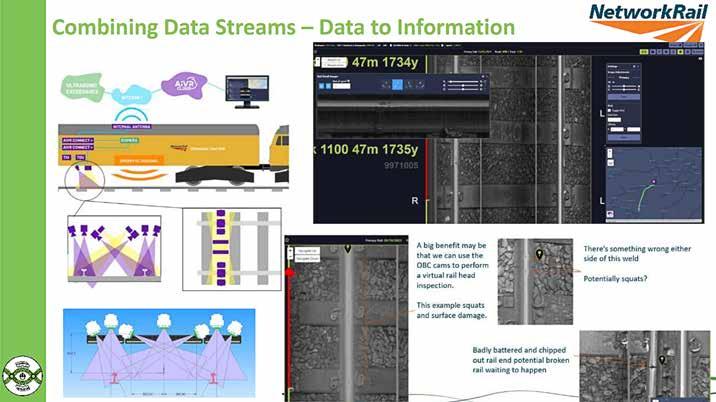
Rail Engineer | Issue 208 | May-Jun 2024 68 PERMANENT WAY & LINESIDE ASSETS

the rail welds on a large sample of track. On a particular ultrasonic shift, it has also identified over 550 squats.
There was more. Brian illustrated the power of AIVR with an image of an area of light-coloured ballast, suggesting that there was lack of support.
This was obvious to the naked eye, but what wasn’t obvious was shown on a heat seeking camera which showed that an electrical rail bond across a rail clamp was exhibiting hot spots that needed investigation (see below).
AN AI FUTURE
With the data from track recording, ultrasonics, and from video all aligned to time and location, Brian was optimistic that soon artificial intelligence will be able identify precursors to rail breaks. The challenge will be to determine what to do prior to failure as there are sure to be far more sites identified than actually break, at least in the early days.
It looks as though there is light at the end of the tunnel and that huge data sets might be capable of being turned into useful information. At last, the image of Brian Whitney, ‘burning the midnight oil’, surrounded by monitors showing data streams, might be consigned to history, although Rail Engineer is sure there will be new problems for him to solve.

Rail Engineer | Issue 208 | May-Jun 2024 69 PERMANENT WAY & LINESIDE ASSETS
Top right: light coloured ballast indicating a problem; bottom right: infrared image showing poorly bonded cables

Remote detection of heat-related track defects: a new approach
SENCEIVE
PHOTOS:
Rail Engineer | Issue 208 | May-Jun 2024 PERMANENT WAY & LINESIDE ASSETS 70
Optical Displacement Sensor with laser directed at rail to detect lateral movement

With the European summer hopefully just around the corner, engineers must consider how best to manage the risk of heat-related track buckle. Established measures include targeted (and disruptive) speed reductions and (expensive) human observation of the track to detect and report lateral movement. They also include localised temperature monitoring, but this is usually based on measurement of air temperature, which can be up to 20 degrees different to the steel rails and does not relate directly to movement.
The search is on for an automated and effective monitoring solution to detect lateral movement that can be applied over extended lengths of track.
Wireless remote monitoring is one of the principal technologies in the spotlight. Track temperature sensors can be incorporated into a wireless platform, bringing the advantages of constant, unattended data collection and automated alerting – but extreme rail temperatures do not always correspond with movement.
The use of wireless tilt sensors on track and structures has become widespread over the last two decades but, while they are effective at detecting parameters such as changes in cant and twist that include an element of rotational movement, they will not detect a purely translational sideways shift. Similarly, wireless instruments to measure rail stress have been around for a while – but again they only indicate the risk of track buckle, because stress levels can vary widely without manifesting in lateral movement.
What is needed is a solution that directly measures lateral movement of the rails and does so in a continuous manner, with automated alerts sent to remote users.
That’s why Senceive monitoring experts have been working with track engineers to explore new options. In a pioneering research project with Network Rail, a testbed has been set up to evaluate a number of approaches. This comprises a length of continuously welded track and a series of hydraulic rams that can push and pull the track sideways in a controlled way. In this regulated environment,

it has been possible to show that the Senceive Optical Displacement Sensor (ODS) can detect lateral movement to millimetre precision with updates sent via the cellular network every few minutes. While various deployment options are possible, the most straightforward is to fix the sensor to a solid object that is unconnected to the track, such as a gantry or retaining wall, and direct the laser at the web of the rail. Where no suitable structure can be found, metal stakes can be used. Alternatively, the sensor can be fixed to the sleeper and directed at a solid object, ideally within about 20 metres of the track.
The next step in this process will be wider rollout of this approach to more sites that have been identified as being at-risk. These deployments could involve a multi-sensor approach to measure rail temperature and stress, alongside the measurement of displacement measured by the ODS. They will also include sophisticated cameras capable of enabling remote users to see up to 50 metres of track in any light condition. A feature that makes this solution especially effective is compatibility with Senceive’s smart InfraGuard solution which can be configured so that defects automatically trigger increased sampling, alerts and photography. In this way track, engineers can learn what’s happening on site long before they can get boots on he ballast.
As this smart IoT approach becomes more widely adopted, the days of depending on the vigilant watchman or tolerating disruptive speed restrictions could be drawing to a close.

 Optical Displacement Sensor fixed to sleeper with laser directed at a fixed trackside structure
PHOTO: NETWORK RAIL
Disruptive track movement due to extreme temperatures near Glasgow, 2006
Optical Displacement Sensor fixed to sleeper with laser directed at a fixed trackside structure
PHOTO: NETWORK RAIL
Disruptive track movement due to extreme temperatures near Glasgow, 2006
Rail Engineer | Issue 208 | May-Jun 2024 PERMANENT WAY & LINESIDE ASSETS 71
Optical Displacement Sensor on trackside structure directed at rail

Rolling stock
software integration and cyber security


Software has become a major feature of rolling stock design maintenance and operation. Even in the 1990s, your writer counted over 200 microprocessors fitted to systems and subsystems on each new eight-car Central line train. That was a comparatively simple train by today’s standards which might see as many as 200 microprocessors per car. With all these systems needing to communicate, the challenge is to make sure that they are all integrated and work together properly.

Another challenge arises from modern trains communicating with the outside world, leading to the risk that bad actors might try and take control of the train and render it unsafe or unusable. To explore this, at the end of February 2024 Rail Partners hosted a seminar at the UK Rail Research and Innovation Network’s facility at the University of Birmingham.
Dr George Bearfield, director of health, safety and cyber security at Rock Rail, and chair of the RSSB Asset Integrity Group gave the keynote address. To illustrate the emerging challenges in rail with a lack of visibility and understanding of software driven systems he used the example of a recent, high profile rolling stock software issue. A regional train operator in Poland had bought some new trains from a domestic supplier. After a nominal 1,000,000km operation, they needed overhaul. This operator sub-contracted overhaul to a third party. When the first train had been completed, they found that it would not work; systems that had worked previously no longer did so. The same thing happened
The failures included the driver’s display (HMI) indicating that the train was ready to move, brakes would release but it would not motor.
The manufacturer blamed the overhauler. The overhauler thought there was something odd in the software and called in a group of socalled ethical hackers (investigators). The train’s main system controller was an off-the-shelf PLC and the investigators used the PLC supplier’s debugging tools to understand data traffic of working and non-working trains to identify areas of code meriting further investigation. They found numerous issues including: every train had different software; trains would lock up if they hadn’t operated at over 60km/h for a length of time; there were several locations, including, allegedly, the overhauler’s premises that were geofenced to lock the software; sometimes the power inverter was disabled.
In addition, the secondary compressor (necessary to raise the pantograph) was disabled; the emergency stop was sometimes triggered; and there were ‘cheat codes’ that could be entered in the HMI to unlock the software. Needless to say, the manufacturer vehemently denied that it had implemented these features.


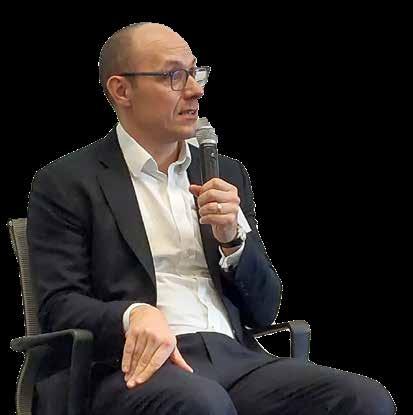 MALCOLM DOBELL
Darren Fitzgerald, RSSB (Left) and Dr George Bearfield, Rock Rail and Chair Asset Integrity Group Rail (Right)
MALCOLM DOBELL
Darren Fitzgerald, RSSB (Left) and Dr George Bearfield, Rock Rail and Chair Asset Integrity Group Rail (Right)
Rail Engineer | Issue 208 | May-Jun 2024 72 FEATURE
Cyber security was next, and George suggested that there is often insufficient technical competence to be assured that assets are safe and secure, something that has to be continuously reviewed over asset lives. In cyber security people talk about Information Technology (IT) and Operational Technology (OT); terms that will pop up again in this article. There is an increasingly grey area between IT and OT as digitalisation and the internet of things continues to develop.
Operating technology, use of computer/software technology in the factory and in transportation, is using more and more internet connectivity to gather monitoring data and support maintenance. Managing and protecting such systems is normal for IT departments but is quite new for OT. Moreover, IT and OT increasingly overlap especially where trains transmit huge datasets to the cloud from where they are analysed on IT business systems.
visibility of the supply chain for all aspects of systems. As he put it, “you’re going to need to say what you need in contracts to be secure, and insist on getting it”.

His final comments were about Artificial Intelligence (AI) and he suggested that it should be kept well away from safety systems. He thought, though, that it might be useful in driving cyber security defence as we need to keep ahead of our adversaries who will also use AI to help drive their offensives.
STANDARDS
George said that the only way to ensure safety critical software was acceptably safe is to work to EN50128 ‘Railway applications - communication, signalling and processing systems. Software for railway control and protection systems’ (now being replaced by EN 50716 Railway Applications. Requirements for software development).
To comply with the standard, the supplier must have a software quality assurance plan detailing its full validation & verification and testing activity. So, he said, “insist on seeing it and, when you review a change, make sure that the evidence you see confirms that the standard has been applied and that the software validator - the key competent party providing assurance - has signed it”. If enforced, this will allow clients to ensure a degree of rigour in software assurance, will drive the correct behaviours, and will help keep liabilities in the right place.
George issued a fairly gloomy warning that we have been through a period of ransomware attacks, that the current unstable geo-political situation increases the likelihood of attacks and clients are likely not to have clear
RSSB’s Darren Fitzgerald expanded on standards and assurance. He said that software itself is only part of the issue that organisations have to consider and he looked at it as a multilayered approach. Clearly assurance is intended to show that software will perform as expected, doesn’t introduce vulnerabilities, doesn’t reverse previous fixes and, of course, operates consistently well.
Darren outlined RIS-0745CCS ‘Client safety assurance of high integrity software-based systems for railway applications’ which includes a great deal of useful guidance and refers to over 30 other standards and other relevant documents. It is intended to help clients be curious about what, hitherto, they might have considered to be black boxes.
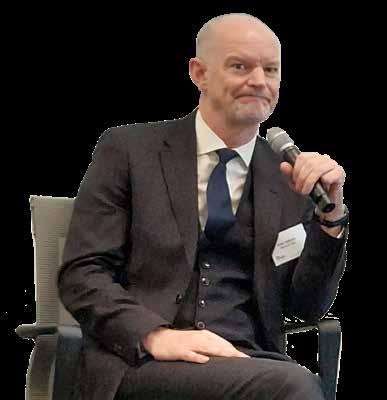

Darren said that it is generally not possible to confirm the behaviour of software-based systems by testing all possible combinations of input. The risk of hazardous software failures is therefore controlled using rigorous techniques for specifying, designing, coding, analysing, and testing the software. Such an approach will introduce fewer defects and find more of those that are introduced, so that they can be removed. However, he added, this might not be efficient or necessary for systems that are less critical to safety.
 Peter Gibbons, Network Rail (Left) and Stacy Thundercliffe, Avanti West Coast (Right)
Peter Gibbons, Network Rail (Left) and Stacy Thundercliffe, Avanti West Coast (Right)
Rail Engineer | Issue 208 | May-Jun 2024 73 FEATURE
PHOTO: RSSB
Darren emphasised the importance of rigour in developing the software, including describing the software functions in words and evaluating risks in an event tree, explaining what might happen if any of the functions should fail, which could be fed into Bowtie analysis with different forms of testing applied as barriers that mitigate an operational hazard, through minimising the impact of its threats and consequences.
OPERATIONAL VIEW
Stacy Thundercliffe and Alex Saxton from Avanti West Coast gave an operator’s experience with new and existing fleets or “super computers on wheels” as Alex described them. Avanti operates the 20 year old Alstom Pendolino fleet, which is soon to be joined by Hitachi bimode class 805 and electric class 807 fleets. All are/will be maintained by Alstom with appropriate support from Hitachi. The Alstom trains are owned by Angel Trains and the Hitachi trains by Rock Rail. As an example of changing technology, Pendolinos were originally fitted with an innovative system3.5mm stereo jack sockets to connect to an on-board audio service. Almost as the trains entered service, this was rendered obsolete by smartphones and demand for on-board Wi-Fi. Wi-Fi provided the opportunity to connect more and more onboard systems to the shore IT systems.
Alex said that the IT world is some way ahead of the physical train world and the trains are having to catch up. This is not helped by the fact that the Pendolino is old in computer terms; Avanti has inherited legacy onboard systems running updated versions of software that was originally coded 25 years ago. Alex said that some of these systems are being updated every day and is no easy task.
The organisation regularly assesses the risks it faces, and adapts its approach to cyber strategy appropriately to consider IT and OT. He added that visual “heatmaps” have been an effective tool – illustrating GDPR, Compliance with the Network and Information Systems Directive (NIS), Penetration Tests, Vulnerabilities & Management, Safety, Maintenance, Manufacturing and Maintenance contract issues and tasks.
The cyber risks are real. Avanti is a partnership between First Group and Trenitalia. Stacy remarked that in 2022, Trenitalia suffered a ransomware attack on its IT retail systems as a result of someone opening a link on a genuine looking email. This sort of attack leads to the very serious prospect that management might operate a kill switch on systems with much more impact on the operation than on the area affected. With the gradual connection of more and more train systems to the shore, there is a risk with any of those new and improved systems that they could be hacked, leading to misinformation, loss of revenue, loss of personal data, impact on services, safety, penalties, and/or reputational damage.

Stacy said that her organisation is reinforcing its fleet and onboard system technology team with expertise to match that of its IT experts. She added that the new Hitachi Rail AT300 fleet will enter service with state-of-the art cyber monitoring devices linked to First Group’s Security Operations Centre and work is ongoing with Angel Trains to develop the best-in-class cyber threat protection on the Pendolino 390 fleet.
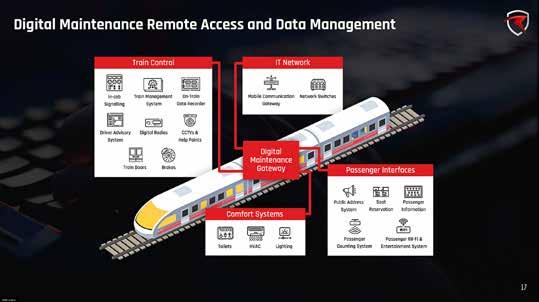
NETWORK RAIL AND THE WIDER SYSTEM
Peter Gibbons, Network Rail’s chief security officer, expressed the firm view that managing cyber security is just another part of health and safety management, part of an operator’s duty under the Railways and Other Guided Systems Regulations (ROGS).
He added that NIS has similar requirements for cyber security and applies to two groups of organisations: operators of essential services (OES) and relevant digital service providers (RDSPs). OES are organisations that operate services deemed critical to the economy and wider society, e.g., duty holders involved in railway operation. In summary, NIS requires:
» An OES must take appropriate measures to manage risks posed to the security of information systems on which their service relies.
» An OES must take measures to prevent and minimise the impact of incidents affecting the security of the information systems, with a view to ensuring the continuity of those services.
» The measures take account of the state of the art technology, to ensure a level of security of information systems appropriate to the risk posed.
Peter said that these requirements are similar to those in the ROGS where an operator is required to hold a safety certificate confirming it has a safety management system that describes how they run their transport system safely which includes identifying and managing risks as low as reasonably practicable. Not only that, he added, but managing cyber security risk is also required to meet contractual obligations. In extremis, a successful cyberattack could put an operator out of business.
Peter suggested three things operators should do about cyber security:
» Stop pretending it’s different/ special/difficult/specialist (i.e. not your job).
» Review existing business practices and make sure that managing cyber threats is baked in.
» Normalise talking about cyber risk management, balancing the need to keep secrets with the need to be transparent and to collaborate.
Typical rolling stock systems controlled though computer networks
RAZORSECURE Rail Engineer | Issue 208 | May-Jun 2024 74 FEATURE
PHOTO:
DIGITAL MAINTENANCE
Dr Emma Taylor from RazorSecure concluded the event with a talk about digital maintenance. Digital maintenance was described by Emma as “any corrective or preventative maintenance carried out on electronic systems on board the train. It is characterised by the use of electronic equipment (e.g., service laptops, USB devices and digital media) to connect to an on-board system to view data, diagnose performance issues, and test and/or update systems.”
Typical digital maintenance activities might include: updating software, management of onboard network equipment; repair, replacement or upgrade of equipment; management of data files; and management, update and configuration of service laptops, test equipment, and digital media; and finally, of course, cyber security.
Cyber protection techniques should include:
» Control of user credentials and privileges.
» Manage anonymous access, insider threats.
» Central management of files and applications.
» Isolate train from service laptops and potential malware.
» Secure remote access.
» Tracking maintenance activity including session logging, monitoring, and configuration control.
Concluding, Emma said that different projects have different requirements, and are deployed in different ways. Some have a cyber security focus, others an operational focus. The digital systems’ lifecycles can be complex, multi-step and iterative. All require some form of onboard installation (software, hardware) and active monitoring & management of digital systems (including networks). Moreover, there is a greater use of cloud-based systems and rail businesses are increasingly dependent on the data such systems generate.
SUMMARY
This seminar made it clear that any view that software, once created and working well is maintenance free, is somewhat naïve. Increasingly complex systems and continual change to meet more demanding requirements means that continual effort to ensure that trains continue to function as required is necessary. Moreover, software design, safety and cyber security are intertwined, and the latter is an ever-evolving issue.
During the discussion, the wealth of useful guidance from the National Cyber Security Centre (NCSC), available on its website, was mentioned. Designers, suppliers, operators, and maintainers need to be aware of the threats and organisations need to employ people whose job it is to test the defences of the various systems. As one speaker said, when it comes to cyber security it’s best to work on the basis that the glass is half empty.
With thanks to Rail Partners’ Neil Ovenden and Susie Beevor for the opportunity to attend this event.
Software suddenly not working (from the keynote address):




PHOTO: RAZORSECURE Rail Engineer | Issue 208 | May-Jun 2024 75 FEATURE
RazorSecure Digital Maintenance Project:


The National Cyber Security Centre
At the February 2024 Rail Partners Rolling Stock Software and Cyber Security event, the work of the National Cyber Security Centre (NCSC) was mentioned.
Launched in October 2016, the NCSC brings together expertise from CESG (the information assurance arm of GCHQ), the Centre for Cyber Assessment, CERT-UK, and the Centre for Protection of National Infrastructure, which became the National Protective Security Authority (NPSA) in March 2023.
The NCSC provides a single point of contact for SMEs, larger organisations, government agencies, the general public, and departments. It works collaboratively with other law enforcement agencies, defence, the UK’s intelligence and security agencies, and international partners.
The high-level principles of the NCSC are:

Understand what’s important. Organisations, government, regulators, and the NCSC should share an upto-date understanding of risk. This should be based on the criticality of organisations, assets, systems, networks, and projects; the resilience of critical assets, systems, networks, and projects; and the threat faced by organisations including bad actors, methods, capability, and intent.


Improve the now. Organisations’ existing assets, systems, networks, and processes should be cyber secure and resilient to a degree commensurate with the level of risk they face. Organisations with the highest potential impact should present a difficult target for even capable cyber adversaries.
Secure the future. Organisations’ new assets, systems, networks, and processes should be secure by design and cyber resilient to a degree commensurate with the level of risk they will face over their lifecycle. Projects with the highest potential impact should present a difficult target for even capable cyber adversaries.
There are real threats. In its 2023 review, the NCSC said that the UK’s critical sectors face a threat that is ‘enduring and significant’, and it believes it is essential to understand the risks to the UK’s Critical National Infrastructure (CNI) before our adversaries do. But while the UK’s CNI is subject to ever-increasing threats, its operators also face other, especially commercial, pressures.
MALCOLM DOBELL
PHOTO: ISTOCKPHOTO.COM/SANKAI Rail Engineer | Issue 208 | May-Jun 2024 FEATURE 76
IDEAL APPROACH
The ideal approach requires a variety of tools appropriate to organisational context and risk appetite. The NCSC indicates that organisations should also manage risk through the supply chain and assess the potential for low frequency, but high impact events. Clearly this approach is similar to any other risk assessment/ management system. State-sponsored cyber attackers are capable of using the built-in tools on victims’ systems to camouflage their activity.

network, without VLAN technology or routers to enforce segregation. The same effect can be seen where firewalls are used without restrictive rules. Thus, all hosts are routable to all other hosts. The NCSC recommends that designers implement network segregation and identify and control network segregation limitations.
It is important to establish a system’s context before embarking on its design, and this should include network zoning and supply chain security. Designers should make it hard to compromise the system, by not trusting external input, enforcing one way flow, reducing the attack surface (minimising entry/exit points), and gaining confidence in security controls. It is clearly good practice to make detection of an attack or a system compromise easier, as well as reducing the impact of compromise together with controls such as duty separation and protecting documentation.
Flat, unsegmented/unsegregated networks, characterised by devices and hosts being able to communicate with other devices and hosts unhindered where they have no legitimate need to do so, are undesirable. These are commonly built using a switch (or several switches) to connect all the devices on the
There have been more distributed denial-of-service (DDoS) threats and attacks against western critical national infrastructure since Russia invaded Ukraine. They are not necessarily Russian in origin but are state aligned groups sympathetic to Russia and are ideologically motivated rather than rather being aimed at extortion. Clearly poorly protected systems are more at risk.
The NCSC website includes guidance on actions to be taken when the cyber threat is heightened, advice on asset management and on appropriate logging and monitoring techniques. Scan the QR code to visit the online version of this article which includes links to articles and white papers on NCSC’s website relevant to the issues we’ve discussed.


Is Your Rail OT System
Cybersecure Enough?
As an expert in securing railway OT networks, I understand the critical importance of cybersecurity in maintaining continuous rail operations.
StationGuard, OMICRON’s specialized Intrusion Detection System (IDS), is designed specifically for OT environments and ensures comprehensive threat detection without compromising network availability. Supporting all relevant operational protocols such as IEC 61850 and DNP3, StationGuard meticulously analyzes the network tra c of your power supply infrastructure. With an extensive vulnerability database covering major vendors, StationGuard is a strategic investment in the future reliability of vital rail infrastructure.
Explore all our features at www.omicroncybersecurity.com and strengthen the cybersecurity of your rail system.



 Andreas Klien Cybersecurity Expert
Andreas Klien Cybersecurity Expert
AD24014-StationGuard-RailProfessional-190x130mm-ENU.indd 1 2024-03-29 11:10:25 Rail Engineer | Issue 208 | May-Jun 2024 FEATURE 77
UK Rail Strategy 2024 looking to the future

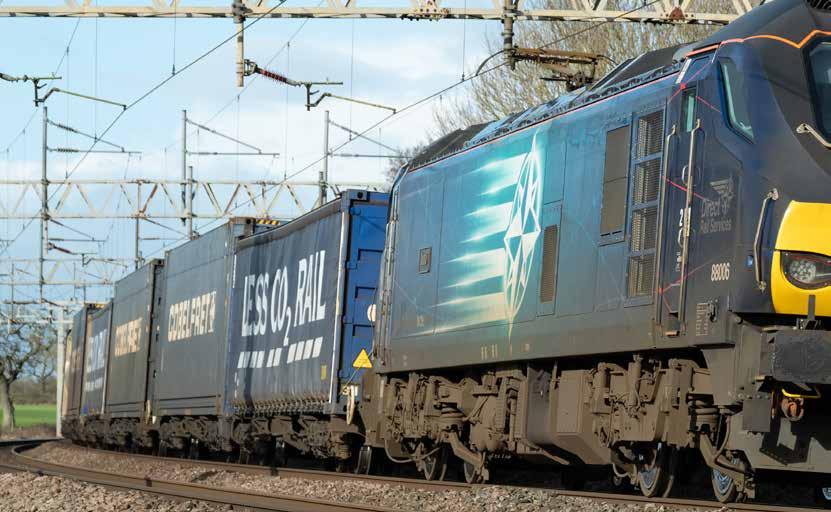


The direction that the UK rail industry takes in the next few months is taxing the minds of many and generating much speculation. To try to understand the issues and to perceive the likely way forward, an online conference was recently organised by the Westminster Energy, Environment and Transport Forum. The outcome probably raised a considerable degree of uncertainty amongst the attendees. Mixed messages emerged but the availability of finance was at the heart of the debate.
RAIL REFORM
To set the scene, Jonny Mood from the National Audit Office (NAO) – the independent public spending watchdog in support of parliament – questioned whether the Department for Transport (DfT) really understood the rail sector. That rail systems need to change is pretty much agreed as taxpayer funding is too high and performance for both passengers and freight is not good enough.

The government has produced a Rail Reform Bill but with a timetable that is high risk. The establishment of Great British Railways (GBR) has been planned for over three years but there has been little progress toward implementation. The plans are front end loaded for expenditure, but the Treasury wants £2.6 billion in savings to come from the reform of work practices.
The government plans are viewed as too complicated, and the delays have added to the financial uncertainties resulting in higher costs.
The DfT and the Treasury are not seeing eye to eye on the resultant risks. With little expected to happen before the general election, any potential savings will not be realised before the next parliament. New passenger contracts will not happen, leaving items listed in the Bill as unclear. The impact of Covid is recognised but the return of passenger growth is misaligned between the TOCs and DfT. Even short-term activities aimed at implementation in 2025 are in doubt.
Optimisation of rail timetables and a fundamental shake up of fares and ticketing is vital but there is difficulty in getting rail companies to buy into this. The last three years have seen some progress and will be relevant to the ongoing situation. Getting an understanding of targets and scope changes will be fundamental.
The NAO concludes that performance has not been good enough, with the DfT not understanding the implementation issues or able to translate these into deliverables.
Rail Engineer | Issue 208 | May-Jun 2024 78 FEATURE
CLIVE KESSELL
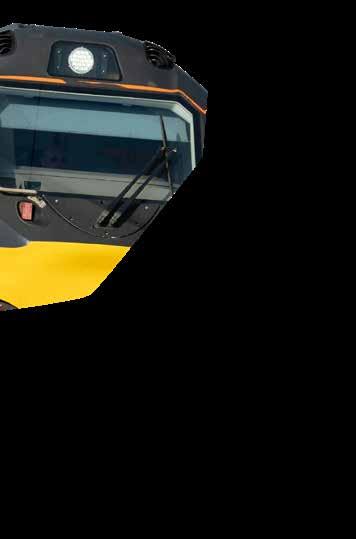
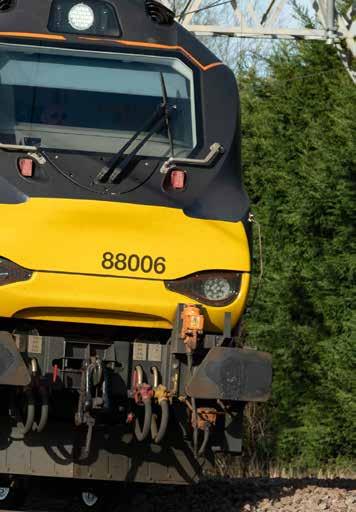

PASSENGERS’ VIEWPOINT
Natasha Grice from Transport Focus informed participants of a recent survey of 15,000 passengers. Their main concerns were obtaining value for money, punctuality, and reliability, but train frequencies and information when disruption occurs were also mentioned. Overall, 85% of passengers were satisfied with the service but this number varied across the TOCs; 74% for Wales up to 92% for Great Northern.
Rail use has changed since the pandemic began with lapsed users wanting lower fares to trigger a return to rail. The help of frontline staff can be a big factor, particularly when buying tickets. Minimising the effect of engineering work is a worry. Blockades are financially beneficial to undertake renewals compared to a multiplicity of weekend work, although it was acknowledged that information provision, especially on the availability of alternative routes, could be much improved.
In short, fares & ticketing, train capacity, information provision, and day to day performance all need improvement if the passenger market is to grow.
A TRADE UNION PERSPECTIVE
News and media headlines invariably cast the trade unions in a negative light by being unwilling to change working practices. However, their views can be important as invariably they see life at the ‘coal face’. Mick Whelan from ASLEF emphasised the need for the rail industry to work as a partnership. In the last five years, the privatised model for rail operation has become seen as flawed by most people. For example, despite rail’s ability to offer a ‘turn up and go’ offering, the price of so doing is often extortionate and people use other means of travelling. Scotland is leading the way to get this put right.
The recent announcement by the Labour Party on future rail policy has caused legal minds to analyse what it means, according to Tammy Samuel from Stephenson Harwood. The timing and structure of rail reform remains uncertain, but GBR will happen as it is already operating in shadow mode.
The nationalisation of the rail passenger services as TOC contracts expire has made headline news but needs analysing. LNER, South Eastern, Northern, and Trans Pennine Express are already effectively nationalised as they are operated by the government following poor performance or financial irregularities. Railways in Wales are owned by Transport for Wales, a Welshgovernment-controlled company and Scotrail is similarly owned and operated by the Scottish parliament.
It is therefore only the remaining franchised TOCs that will be nationalised. Open access operators, the rolling stock leasing companies (ROSCOs), and the freight companies will not be.
At privatisation, the original franchised TOCs had great decision-making power but this has ebbed away with the abandonment of most private sector involvement. It is hoped that if Labour win the election, private sector involvement will be encouraged.
All this uncertainty has exacerbated the skills shortage, and building back confidence for career futures will be important. Whatever happens, organisational reform must not interfere with performance improvements.
The discontinuity of the European Train Control System (ETCS) programme is a concern. A little here, a little there, but with not much joined up. This makes it difficult and inefficient for the training of drivers and the familiarity of other staff. An accelerated programme for whole route conversions would be welcomed.
The way people work has changed since the pandemic with season ticket income (almost a type of bond) all but disappeared. Capacity planning has to align with this but is slow in being realised. The ‘directing mind’ of someone who knows the intricacies and pressure points of the industry is badly needed and establishing GBR is therefore welcomed. The demand for rail freight growth is welcomed but currently drivers in that sector are leaving in droves and it will become a major problem to crew trains if the perceived growth is realised.
The present industrial relations dispute was referred to. Interestingly, there is no problem in Wales and Scotland, as well as with Merseyrail and some others, but elsewhere no meaningful negotiations have happened for months with the government seemingly dictating what or what not to do. The plea was made – just talk to us and a deal will be arrived at.
RAIL FUTURE VISION
As would be expected, Chris Page from Rail Future would like to see a bigger, better railway but the financial hole of the industry was recognised. There needs to be a better understanding of what the railway is for. In addition to basic travel and reliability, sustainability and environment issues should be part of the agenda.
Fundamental will be firming up on future structure and ownership. Empowering expert leaders, creating a trajectory for revenue spend, and publishing a longer-term investment pipeline will be crucial. Decarbonising via a strategy for electrification or battery traction would be welcomed. Reforming fares and ticketing is top of the agenda with decisions removed from ministers and civil servants. Playing politics is very damaging.
Rail Engineer | Issue 208 | May-Jun 2024 79 FEATURE

INDUSTRY REQUIREMENTS
Robert Cook spoke for the Railway Industry Association (RIA) which represents industrial suppliers to the railway ranging from large international groups down to small and medium enterprises (SMEs). To get efficient deliverables from industry, a long-term strategy is needed with a 30 year plan and a refresh every five years. This will give confidence to invest in staff, planning and factory deliverables. No business can currently do this with any certainty.
GBR is key to a having a long-term financial strategy whilst recognising the risk of allowing a build-up of renewals work that will eventually impact on train services. The future relationship between GBR and government must not restrict rolling stock procurement or timetable creation.
NORTHERN POWER HOUSE

This organisation has been prominent in its objectives for many years but has been somewhat wrongfooted by the cancellation of Phase 2a of HS2 and the associated problem of congestion on the West Coast Main Line around Stafford. Henri Munson considered the impact and what might replace it. Central government funding for major projects does not seem to work but alternative finance provision is a dilemma. Maybe a localised tax base would help, but how would this work in practice and how can savings be made? Council Tax increases are ruled out so funding from the local private sector might work if this benefits local businesses plus, perhaps, a settlement from central government.

Northern Power House would like to see electrification of the Trans Pennine route all the way from Liverpool to Hull including the links to Selby and Doncaster. This would avoid the need for hybrid trains which are more expensive than electric trains. Rail keeps making partial decisions on investment without any real idea of the end game.
More ambitious ideas envisage a new line from Huddersfield to Warrington as a second part of the Trans Pennine upgrade, plus a need to better connect the East and West Midlands using Leicester as a hub, with joined up thinking across the counties.
THE STATE OF THE INFRASTRUCTURE
Rail infrastructure is all part of the system and not something to be considered in isolation, so said Professor Paul Plummer from University of Birmingham and one time head of the Rail Delivery Group. A long-term plan to understand what infrastructure resilience will cost is also required.
Common standards across the network are needed, but putting customers first is a priority. GBR and rail reform will help, but a clear and consistent narrative on environment, sustainability and decarbonisation objectives has to part of the plan.
At grass roots level, Alastair MacDonald from Balfour Beatty spoke of the major work to replace the viaduct between Oxford and Didcot, and the associated disruption this caused. Similar major works will be required at other locations as weaknesses become known. Constant strengthening of banks and cuttings is happening with real time monitoring showing up emerging problems before major failures occur.
One hundred and twenty thousand engineers and technicians are required every year to keep the infrastructure in good order, meaning that investment in apprenticeships and graduates must be ramped up with an emphasis put on local suppliers to encourage new recruitment. Off-site manufacture of components will help this.
Regrettably, the actual money spent at the worksites as compared to the overheads of renewal provision is a decreasing percentage. There is an urgency to get requirements firmed up at the start and not to then change the scope. The five-year control periods do give the supply industry a degree of certainty but much improved planning is vital.
Rail Engineer | Issue 208 | May-Jun 2024 80 FEATURE
PHOTO: ISTOCKPHOTO/ HXDBZXY
Rail reform is mentioned constantly but the real problems are something different, so said Stephen Glaister, emeritus Professor of Transport and Infrastructure at Imperial College London, and a former head at the Office of Rail and Road (ORR). First, the size of the railway has increased by a factor of three over 15 years. Government fiscal support in 2019 was £12 billion per year but post-Covid lockdowns, the next government will face a support level of £18 billion per year, which represents about £600 for every household. The terms of reference for the Williams Shapp report precluded any increase in government money, whereas the public expectation is a reduction in fares and better services.
The equations do not stack up. Questionable is why various parts of the railway are subsidised differently: Northern is 29.5p per passenger, Great Western is 10.8p, Greater Anglia is 1.1p, whereas C2C is -1.4p (i.e., it makes a contribution). The average is 6.4p per passenger, so what accounts for these vast differences?
Secondly, governance is an issue where three things need attention – a more effective system operation which is already much improved, better procurement of passenger services which might come with nationalisation, and the resolution of ongoing industrial relations problems.
Much is talked about the creation of GBR but beware of learning from the demise of the previous Strategic Rail Authority. Reading the history of this in the Terry Gourvish report should be mandatory. The subsidy for bus operation and the maintenance of local roads will be big money devolved to Local Authorities and where rail has only 10% of the market. Transport taxation and fuel duty is controversial but policies for net zero carbon may influence this.
On a brighter note, CP6 did deliver the efficiencies set out but it is difficult to see how this would work for a nationalised railway.
DELIVERING THE STRATEGY
While GBR will eventually become a reality, in the short term it will be largely down to Network Rail (NR) to deliver the strategy, according to Paul McMahon, NR’s director for planning and regulation. With £45.4 billion allocated for maintenance and renewals in CP7, the plans for spending this money will be owned by the regions and functions. HQ will coordinate and align the strategy across the network, ever mindful of delivering the UK and Scottish governments objectives.
With its devolved organisation, NR’s plans will concentrate on:
» Improving train performance.
» Growing rail freight.
» Improving environmental performance.
» Keeping asset age to a minimum.
» Increasing efficiency to combat inflation.
» Infrastructure monitoring and climate change recognition.
» Speeding up the introduction of digital signalling (ETCS).
» Improving public, passenger, and workforce safety.
To achieve these, four areas of working practice will need to be reviewed and modernised:
» Capability – skills and competence, use of technology, and processes.
» Efficiency – contracting, standards, maintenance modernisation, obtaining a whole industry approach.
» Agility – response to emergency challenges and opportunities.
» Collaboration – working together with industry and stakeholders.
MONITORING THE STRATEGY DELIVERABLES
The ORR has a duty to police the effectiveness of any new strategy but with a priority to focus efforts on the end user, said Will Godfrey, its director of economics, finance, and markets. Periodic reviews take account of the items listed by NR but also structural changes in demand (e.g. during a pandemic) and industrial action.
During the Covid pandemic emergency, train punctuality improved measurably because there were fewer passengers and trains. Freight traffic declined by 8% between 2014/5 and 2023/4 but a target of 1.3% growth is set for CP7. Of the £45.4 billion allocated for the period, 40% of expenditure will be for keeping the network in good order but with less spend on renewals and more on maintenance. Up to £2.8 billion will focus on improving network resilience. Access charges must remain below inflation to ensure the future for open access operators and freight.
Obtaining value for money means significant efficiencies are needed but these were obtained in CP6 which delivered £4 billion of savings, better than the target of £3.5 billion. CP7 requires £3.6 billion of savings. There are uncertainties ahead, but passenger recovery and inflation are going in the right direction. There is room for optimism.
IN SUMMARY
There is little doubt that the next few years will see change as to how the railway is structured and operated. Just how this will happen is far from clear and several mixed messages emerged from this conference. Finance will be key to everything but with the competing pressures from the health service, social security, defence, policing, and education, it is difficult to judge exactly where rail sits in the pecking order. Much will depend on how rail performs in the short term but building back confidence and getting costs under control will be key factors. We have to wait until after the general election to see how rail reform will actually take shape.


A TOUCH OF REALITY
ISTOCKPHOTO/ ILYA LUKICHEV Rail Engineer | Issue 208 | May-Jun 2024 81 FEATURE
PHOTO:




























































82 CAREERS Rail Engineer | Issue 208 | May-Jun 2024 Find your role! visit: www.RailwayPeople.com / email: rp@rail-media.com / telephone: 01530 816 450 What is RailwayPeople.com? RailwayPeople.com is the largest dedicated rail job board in the UK. How can it help me? With the top career opportunities updated daily, your next move is a fingertip away. What should I do? Visit RailwayPeople.com today to find your next role and become an essential part of the UK’s rail industry to help the nation build back better. Job updatedroles daily
WORK FOR US
CAREER OPPORTUNITIES



We work together to unlock the potential of our people


SYMCA - Public Transport Operations
Sheffield (Hybrid Working or Onsite)

• Track & Civils Engineering Manager



• Rolling Stock Engineering Manager
• Electrical and Mechanical Engineering Manager
• Systems Engineering Manager



• System Engineering and Integration Manager


The South Yorkshire Mayoral Combined Authority (SYMCA) brings together the local authorities of Barnsley, Doncaster, Rotherham, and Sheffield to serve the communities and businesses of South Yorkshire.
Good public transport is key to unlocking South Yorkshire’s potential. The South Yorkshire Supertram system is the region’s fast, frequent, zero-carbon mass transit system allowing people to access jobs, homes, education, leisure, and retail destinations. The system comprises 32 vehicles, 29km of twin track with electrified overhead line equipment, 50 tram stops, 12 substation, and various other civils, signalling, and communications assets. The network also contains the UK’s first tram-train service which sees light rail vehicles travel over both light and heavy rail infrastructure (owned by Network Rail) between Sheffield city centre and the neighbouring town of Rotherham. The system is owned and managed by SYMCA, with operations and maintenance recently transferring to South Yorkshire Future Trams Limited (a wholly owned subsidiary of SYMCA) following the end of Stagecoach’s 27-year contract.
SYMCA is embarking on a wide-ranging improvement programme to modernise the Supertram system and improve the service for our passengers. Significant investment across all aspects of the system is planned over the coming years; this includes an extensive rail replacement programme, procurement of a new fleet, refurbishment of our substations and full renewal of all light rail systems. We are also exploring options for extending the tram network in line with our Mayor’s transport vision.
We are strengthening our teams to be ready for the challenges of delivering this scale of improvement and investment. We have exciting opportunities for people looking to make a positive impact on their career and the future of transport in South Yorkshire.
This is an exciting time to be joining the South Yorkshire Mayoral Combined Authority as we continue to support the development of our region and make South Yorkshire a great place to work and live.

Rail Engineer | Issue 208 | May-Jun 2024 83 CAREERS
Apply Now and find out more about our exciting Career Opportunities Please visit: www.SYMCA-Careers.co.uk


Rail Engineer | Issue 208 | May-Jun 2024 This isn’t just a rail dropper. Available from Unipart Rail (Official UK Distributors) E: enquiries@unipartrail.com T: +44 (0)1270 847600 Gripple E: sales@gripple.com T: +44 (0) 114 275 2255 You’ve got to see it to believe it gripple.com/swiftline/ It’s faster project delivery. The Gripple SwiftLine Rail Dropper is the Network Rail-approved game changer for rail electrification. Easy to install with minimal additional training required, it shortens project durations and helps contractors provide more competitive quotes.











 DAVID SHIRRES
DAVID SHIRRES
RAIL ENGINEER EDITOR
DAVID SHIRRES
DAVID SHIRRES
RAIL ENGINEER EDITOR

 Siemens Battery EMU now in service in Germany
Siemens Battery EMU now in service in Germany











 Battery EMUs such as this Siemens Mireo plus B are now entering service in Europe. RIA’s plan proposes the large-scale use of such units
PHOTO:SIEMENS MOBILITY
Battery EMUs such as this Siemens Mireo plus B are now entering service in Europe. RIA’s plan proposes the large-scale use of such units
PHOTO:SIEMENS MOBILITY



























 PHOTO: GRIPPLE
PHOTO: GRIPPLE
PHOTO: GRIPPLE
PHOTO: GRIPPLE














































































 Aston Church Road Bridge
Key:
Purple: Extent of site
Blue: Bromford portal and box
Red: Extent of depot site
Yellow:
Left: Sidings (top) and Driver/ Service Staff Building (bottom)
Middle: Network Integrated Control Centre
Right: Maintenance building and wheel lathe
Aston Church Road Bridge
Key:
Purple: Extent of site
Blue: Bromford portal and box
Red: Extent of depot site
Yellow:
Left: Sidings (top) and Driver/ Service Staff Building (bottom)
Middle: Network Integrated Control Centre
Right: Maintenance building and wheel lathe































 Advanced materials at the University of Sheffield’s stand
Advanced materials at the University of Sheffield’s stand






 PAUL DARLINGTON
PAUL DARLINGTON












 MALCOLM DOBELL
MALCOLM DOBELL





 Breakdown of WSTCF causes over a 10 year period
Breakdown of WSTCF causes over a 10 year period




















 MALCOLM DOBELL
MALCOLM DOBELL



 Sample measured rail profiles
Sample measured wheel profiles
Sample measured rail profiles
Sample measured wheel profiles


















 Optical Displacement Sensor fixed to sleeper with laser directed at a fixed trackside structure
PHOTO: NETWORK RAIL
Disruptive track movement due to extreme temperatures near Glasgow, 2006
Optical Displacement Sensor fixed to sleeper with laser directed at a fixed trackside structure
PHOTO: NETWORK RAIL
Disruptive track movement due to extreme temperatures near Glasgow, 2006



 MALCOLM DOBELL
Darren Fitzgerald, RSSB (Left) and Dr George Bearfield, Rock Rail and Chair Asset Integrity Group Rail (Right)
MALCOLM DOBELL
Darren Fitzgerald, RSSB (Left) and Dr George Bearfield, Rock Rail and Chair Asset Integrity Group Rail (Right)



 Peter Gibbons, Network Rail (Left) and Stacy Thundercliffe, Avanti West Coast (Right)
Peter Gibbons, Network Rail (Left) and Stacy Thundercliffe, Avanti West Coast (Right)













 Andreas Klien Cybersecurity Expert
Andreas Klien Cybersecurity Expert




























